- How To Draft A Survey Disclaimer: Important Laws, Examples

Surveys are an important method for collecting research data . However, respondents may be hesitant to provide their data if you do not guarantee their data security.
Respondents’ concerns usually revolve around their privacy, identity, and the research’s purpose; this is where a survey disclaimer can help. Adding a survey disclaimer to the questionnaire assures respondents of how their data will be processed and its security.

What Is a Survey Disclaimer?
A survey disclaimer allows researchers to reiterate their data security and privacy policies. Typically, the disclaimer will state whether or not the responses of the respondents will be shared with third parties.
The survey disclaimer also informs respondents whether their data will be kept anonymous and if it will be used for marketing purposes.
People usually find it difficult to read disclaimers if they are too long, or they simply assume that it is the same disclaimers they have encountered in the past. So they simply read through the survey and consent to it by checking the “I agree to the terms and conditions” box.
It is advisable to include a consent statement in your survey disclaimer so that respondents understand what they are about to do and how their answers will impact the research.
Why Do You Need a Survey Disclaimer Statement?
Respondents are usually hesitant to disclose identifiable personal information such as names, contact information, addresses, and financial information. Most people also dislike receiving spam emails or having their data exposed to companies they didn’t share it with.
Respondents’ reluctance to divulge information is primarily motivated by a fear that the information will be misused. As a result, a researcher should specify how identifiable personal information will be handled
Study disclaimers help respondents in making an informed decision about whether or not to participate in the survey. Respondents also want to understand the purpose of a survey so that they can decide whether or not to participate in such research.
There are no laws governing survey disclaimers, but there are laws governing privacy and data protection. These laws aim to protect consumers’ or citizens’ privacy and specify how data controllers should process consumers’ data.
A survey disclaimer statement assures respondents that you recognize and follow the law when collecting and processing their information. It also informs respondents about the research’s purpose and objectives, and how the data collected from respondents will be useful to the research.
Four Purposes of a Survey Disclaimer
These are the major reasons why the survey disclaimer is more useful to the researcher seeking the highest possible response rate.
- It Boosts the Researcher’s Credibility
Respondents associate a survey disclaimer with professionals. As a result, they believe that their information is safer in the hands of a reputable researcher.
- More Responses
A survey disclaimer statement is an excellent way of gaining the researcher’s trust. An increased survey response rate increases your chances of collecting more diverse and accurate data for your research.
Respondents will readily answer your questions once they are assured of their anonymity, privacy, and confidentiality.
- It Shows You Adhere to Industry Best Practices
Adding a survey disclaimer statement to your questionnaire shows participants that you adhere to industry best practices. It shows that you follow all applicable data privacy laws and regulations.
- It Helps Respondents Determine whether or not to Participate in a Study
Your survey disclaimer statement helps respondents decide whether to proceed with answering your questionnaire or abandon it.
Once they see how you intend to use the data, they can know if it is a cause they want to help with.
Important Laws on Survey Disclaimers
Hipaa act (u.s.).
Although the US does not have one generic law for privacy protection, medical information is taken seriously in all states. The Health Information Portability and Accountability Act specifies the duties of anyone who handles medical information. Universities, researchers, and businesses adhere to HIPAA guidelines.
HIPAA balances the security of health information privacy with issues such as the availability of information to assess treatment, securing public health concerns, and supporting research.
The health care provider is required to always notify the person whose health information is being collected. Also, before the medical provider can process the information, that person must have consented to providing it and allowing the medical provider to process it.
Typically, surveys on mental or physical health include a disclaimer stating that respondents’ personal information will not be associated with the answers they provide. Instead of being associated with any email address, automated online surveys are given random identifying numbers.
This law allows the researcher to collect relevant data while protecting the respondent’s identity.
CalOPPA Act (U.S.)
In 2004, the California Online Privacy Act was enacted. The law stipulates the responsibilities of data controllers.
Data controllers are entities that collect personal data from their users. These entities must notify users before collecting their information according to the CalOPPA Act.
California is one of the most populous states in the United States, and it also has a thriving business community. As a result, if you want to survey in California, you must follow this law.
CalOPPA’s precaution is necessary because online surveys frequently include people from all over the world. So, even if your respondent isn’t from California, you should always follow the law; you never know when you’ll be surveying someone from the Golden State.
CalOPPA requires that every website include an obvious link to the privacy policy. It also includes a list of mandatory requirements for websites’ privacy policies. The following requirements apply to surveys:
- Accurate description of the kind of personal information collected.
- The purpose of collection of that personal information.
- Identity of third parties who may have access to the personal information collected.
PIPEDA (Canada)
The Personal Information Protection and Electronic Documents Act of Canada makes provision for surveys sponsored by for-profit surveys. The law requires companies to obtain consent before using or disclosing personal data.
It also states that the use of personal data is limited to the purpose for which it was collected. The purpose should also be stated at the time of collection.
Although PIPEDA is meant to regulate commercial organizations, it also applies to businesses that fall directly under the legislative authority of the legislature. As a result, airports, airlines, banks, public transportation authorities, television and radio broadcasters, telecommunications companies, and offshore drilling operators are all covered by this law.
Since it’s nearly impossible to know which province your respondents are from, it’s best to follow this law whenever you conduct a survey or involve anyone in Canada.
The European Union’s General Data Protection Regulation does not specifically address surveys. Rather, it covers all aspects of data collection and processing.
Data must be collected lawfully and processed lawfully and fairly. The GDPR includes data protection principles such as accountability, specifying the purpose of collection, the right of data subjects to consent or object to collection or processing, and the right of data subjects to the erasure of their data.
It also includes the right of data subjects to access their data, the right to rectification where data is incorrect, the right to data portability, and the right to automated decision-making.
So, if your survey is going to collect any personal data, your survey disclaimer statement should include the details of the data needed, how you intend to use the data, and what happens to the data once you’ve finished using it. This standard must be met, especially if you use clickwrap to ensure respondents accept your survey’s terms and conditions.
Important Points to Consider While Drafting a Disclaimer for Your Survey
The survey disclaimer must reflect the type of research you are conducting. For example, the privacy you need to assure respondents of when asking for medical history will be very different from the privacy you need to assure respondents of when surveying their use of public libraries.
People are more likely to keep their medical information private, but if you were researching the use of public libraries, they might be willing to participate.
Here are some of the questions that your survey disclaimer must answer for your respondents:
Purpose of the Survey
Tell them the aim of the study. It will help the respondents know why their honest answers are necessary.
For example, state that “the responses will be used for general analytical studies only.” That shows the relevance of their answers and assures them of privacy at the same time.
How You’ll Maintain Their Privacy
This is necessary when collecting personal information. Inform respondents that you intend to contact them again in the future using the contact information they provided.
Also, inform respondents if anyone else with access to the research may have access to their personal information. Also, specify how long you intend to keep their data before erasing it.
If You’re Sharing Their Information With Third-Parties
Disclose whether or not you intend to share data collected with third-party apps, particularly for marketing purposes. Respondents may be reluctant to provide personal information if they’ll end up being bombarded with marketing emails and spam.
The Survey Length and Time
When time is short, it encourages most respondents to respond on the spot. But if the survey is lengthy, it will give them a heads-up and allow them to decide whether or not to answer.
You can do this by stating the number of questions and the average time it takes a person to answer all of them.
How to Draft a Survey Disclaimer
Before settling on the survey disclaimer to draft, consider the type of information you need. If your survey requires information that people are willing to give a total stranger, such as perceptions of public events or consumer products, a general survey disclaimer will most likely suffice.
Regardless of how impersonal you think the information is, respondents are understandably concerned about what happens after the information is provided.
If the product you need the survey for is pretty personal, respondents may also feel exposed. So, it’s important to reassure them that their names, addresses, and contact information will not be made public.
Include an “I agree” checkbox at the bottom of the consent form, allowing respondents to choose whether or not to participate in the survey after reading the disclaimer.
You may draft a survey disclaimer that integrates your privacy policy with a hyperlink. However, it is preferable to summarize your privacy policy in simple and easy-to-understand language in that disclaimer statement.
Examples of Survey Disclaimers
The following questions will be used for general analytical purposes only. Although your email address is sent along with your answers, your specific responses will not be linked to you in any way once the responses are posted on the website.
After your results are added to the final tally, your email address will be deleted from any records we may have. So, you will not be added to any mailing lists you didn’t subscribe to. No third party will be given access to your responses. Only numerical results will be displayed.
Going ahead to participate in this survey implies that you understand and agree to the provisions in this disclaimer.
Researchers often struggle with choosing between the ability to track respondents and maintaining respondents’ anonymity. Keeping responses anonymous ensures that they are honest and accurate while keeping respondents’ identities allows researchers to contact them if additional input is required.
We maintain the privacy and confidentiality of our survey participants with Respondent Anonymity Assurance (RAA). Once the RAA is activated, it can neither be removed nor edited by the researchers.
Hey, glad to see you around here!
Thank you for deciding to help by taking our ten minutes survey.🙂
We at xxx seek to collect the right data about [survey subject]. Our target audience is everyone who is [target audience]. This is why we need you!
Your data is safe with us. We’ll use it only for this research and delete it afterward. We promise.
Your privacy policy probably includes your best data privacy practices, but survey disclaimers help to reassure your respondents. Respondents have to feel safe to provide the requested information, even if it is not personally identifiable information.
Also, keep your survey disclaimer language simple and clear. Unlike privacy policies, which are often lengthy, survey claimers should be very easy to understand.

Connect to Formplus, Get Started Now - It's Free!
- bad research questions
- research questions
- survey disclaimer
- survey research
- Moradeke Owa

You may also like:
Customer Insight: Types, Examples & Tools Guide
Customer insight helps businesses to know their customers better and build great products for them. Continue reading to learn how to...

Double-Barreled Questions: Examples & How To Avoid Them In Research
Introduction It’s popular knowledge that survey creators want to create a perfect experience for their respondents, as this is the sure...
9 Great Books For Survey Researchers & Practitioners Part I
Introduction Many research topics are published daily, detailing the recent developments across various niches. According to data from a...
Testimonial Questions: Free Examples + How to ask
Introduction The business climate has become more aggressive over the years, with competitors littering the place, making it harder for...
Formplus - For Seamless Data Collection
Collect data the right way with a versatile data collection tool. try formplus and transform your work productivity today..
- Skip to main content
- Skip to primary sidebar
- Skip to footer
- QuestionPro

- Solutions Industries Gaming Automotive Sports and events Education Government Travel & Hospitality Financial Services Healthcare Cannabis Technology Use Case NPS+ Communities Audience Contactless surveys Mobile LivePolls Member Experience GDPR Positive People Science 360 Feedback Surveys
- Resources Blog eBooks Survey Templates Case Studies Training Help center
Home Surveys
Survey Disclaimer: What it is + Why It’s Important
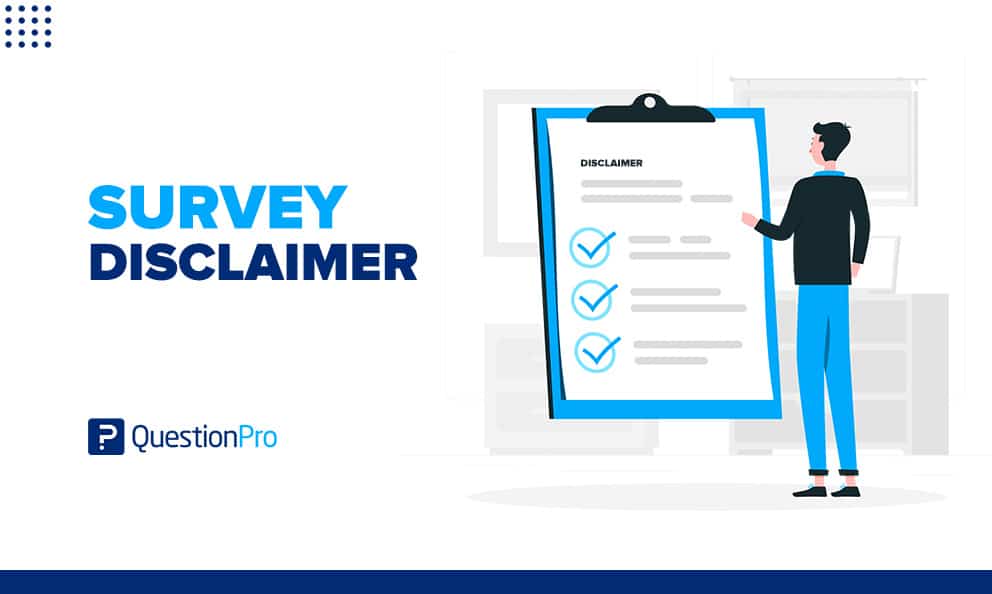
Surveys are an effective means of data collection. However, getting respondents to take an online survey might be difficult if you don’t assure them privacy. Or if they are skeptical about how their answers will be used. After all, everyone wants to know the survey goals and objectives before answering the questions.
The information gathered in this survey disclaimer is solely intended for research purposes. It does not provide personalized medical advice, as our primary aim is to address securing public health concerns on a broader scale.
Adding a disclaimer in the questionnaire is an excellent practice to get more responses. It aids in reassuring the audience that their data is safe. Organizations can stay transparent and let the participants know how their responses will be used.
What is a survey disclaimer?
A survey disclaimer is a way for researchers to reiterate their privacy policies and data security measures. After answering the questionnaire, you can let the survey takers know what they can expect.
A survey disclaimer is a way to ensure that the participants know if their responses will be anonymous or used for any marketing purposes. Organizations can take this opportunity to let them know if their data will be shared with any third party.
Usually, people do not go through the terms and conditions before consenting to the survey. Most participants would quickly glance through the policies and tick the ‘I agree to the terms and conditions.’ checkbox.
Adding a survey consent statement will ensure that the participants know what they are about to do and how their responses will impact the research study.
Why do you need a survey disclaimer statement?
A survey disclaimer or survey consent statement is not mandatory to include in the survey as per the laws. However, many government regulations, such as GDPR, HIPAA, CCPA, and others, aim at protecting consumers’ privacy.
Survey participants might not want their names to be disclosed with sensitive information, so you can let them know about your company’s various data privacy and security measures.
Respondents are reluctant to share their Personal Identifiable Information (PII), such as email addresses, because they fear they will get promotional, spam, or junk emails.
Hence, market research companies should show a survey disclaimer statement before asking the questions and highlight if their PII is safe. If no PII is being collected, mention the purpose of the survey and how the data will be used.
Here are why you should add a survey privacy disclaimer or ask consent questions.
- It increases the credibility of researchers: Respondents will be willing to answer questions once they know their anonymity, privacy, and confidentiality.
- Get more responses: Respondents are likelier to answer questions from a trustworthy organization, increasing the survey response rate .
- Industry best practice: It is good to share with your survey participants that your survey tool and method adhere to various data privacy laws and regulations.
- Allow participants to decide if they want to answer the survey: Let them know how you will use the data, and then give them an option if they want to proceed further. It also emphasizes that respondents’ consent matters to your organization.
Example#1: Survey disclaimer statement
Consider a student who wants to conduct research on alcohol. If the sample audience is evenly distributed, it is likely that a few people may not consume alcohol.
The survey consent statement provides more information about the survey and checks with the participants if they are willing to proceed further with the checkbox ‘I agree”.
LEARN ABOUT: Survey Sample Sizes
Example #2: Anonymous survey example
Researchers often struggle while choosing between the ability to track the respondents and not linking their identity. Keeping responses anonymous ensures the responses are honest and accurate, while the identity details allow researchers to contact respondents if further inputs are required.
QuestionPro allows our users to maintain the privacy and confidentiality of the survey participants with Respondent Anonymity Assurance (RAA). There will be a link to more details for surveys with RAA enabled in the footer. Once it is activated, it cannot be removed or edited by the researchers.
Four purposes of a survey disclaimer
A survey disclaimer is a statement that outlines the terms, intentions, and limitations of a survey, helping respondents understand what to expect and protecting the organization or individual conducting the survey. Here are four key purposes of a survey disclaimer:
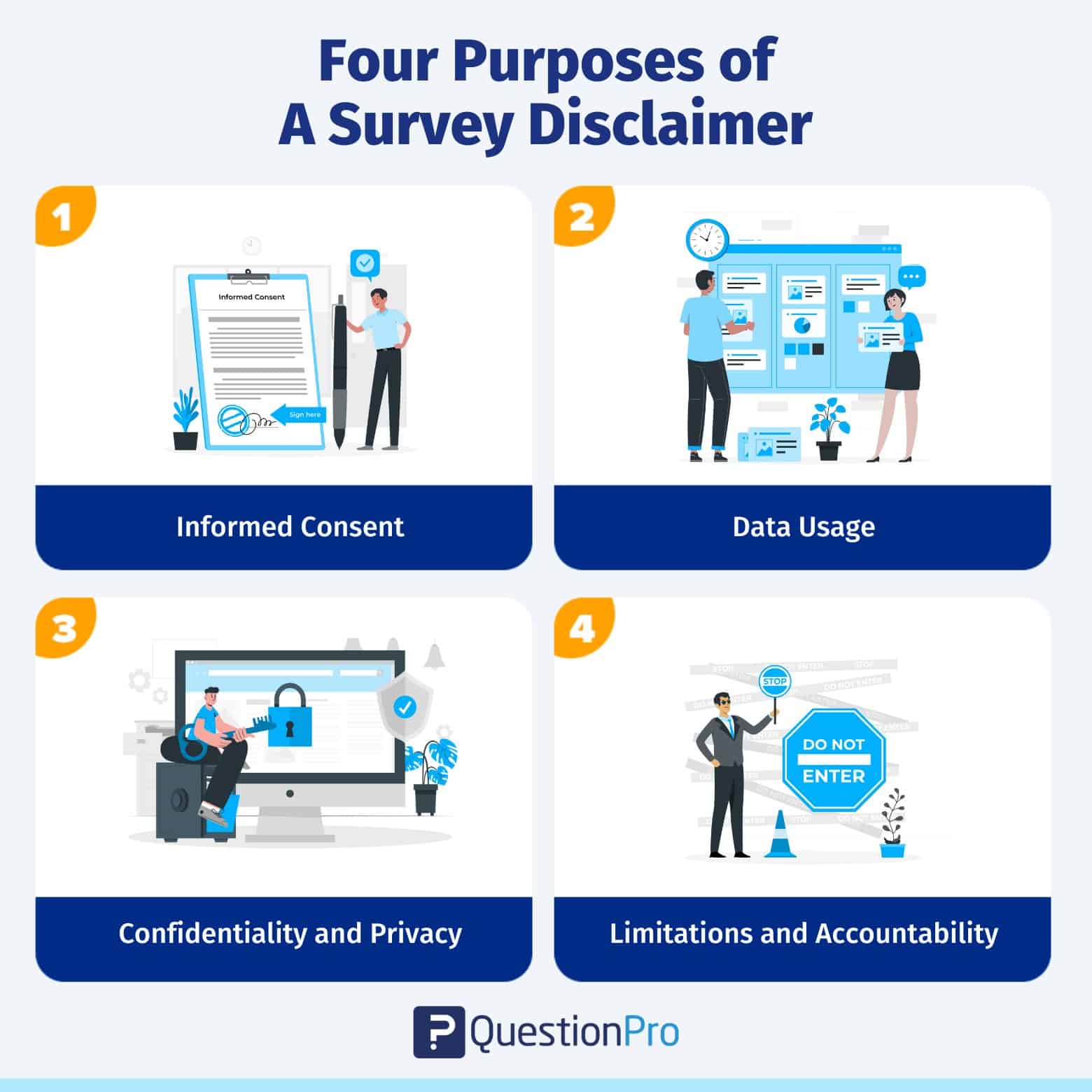
1. Informed consent
A survey disclaimer informs respondents about the purpose and objectives of the survey. It ensures that respondents are aware of the data they are providing, how it will be used, and their rights regarding participation. Informed consent is crucial for maintaining ethical research practices and respecting participants’ autonomy.
2. Data usage
The disclaimer clarifies how the collected data will be used. It may explain whether the data will be anonymized, aggregated, or used for specific research purposes. This helps respondents feel more comfortable sharing their information and reduces concerns about their data being misused or shared without their knowledge.
3. Confidentiality and privacy
A survey disclaimer outlines the measures taken to protect respondents’ confidentiality and privacy. This can include assurances that responses will be kept confidential, that no personally identifiable information will be shared, and that data will be stored securely. This transparency encourages respondents to provide honest and accurate information.
4. Limitations and accountability
The disclaimer sets expectations about the limitations of the survey. It may specify that the survey represents only a specific population or may not cover all relevant aspects of a topic. Additionally, disclaimers can clarify the contact information of the survey organizers or researchers, providing a point of contact for respondents to specifically address surveys any concerns or questions they might have.
Important points to consider while drafting a disclaimer for your survey
The disclaimer statement depends on the type and purpose of the survey. For instance, if you are a ride-sharing app asking for feedback after a trip, then there is no need to add a disclaimer. However, if you are conducting a deep medical research study, it is advisable to draft a consent statement for your questionnaire.
Here are some of the basic questions you must answer in the survey disclaimer for your participants.
Q-1: What is the purpose of the survey?
Be explicit about the aim of the study. For instance, you can say, “The responses will be used for general survey disclaimer analytical use only.”
Q-2: How will privacy be maintained?
Respondents’ identity details, such as email address, IP address, location, and country code, are collected unless it is an anonymous survey. You can disclose whether the email address will be linked to the responses in any way.
Q-3: What happens with personal information collected?
Many surveys collect personal data by asking for contact details such as name, address, phone number, etc. Mention if you conduct GDPR compliant market research .
Q-4: Will the data portability be shared with third-party apps?
Nobody wants their inbox flooded with unwanted marketing emails. So, disclose whether the email address or individual responses will be shared with third parties.
Q-5: What is the approximate time taken to complete the survey?
This is optional, but you can mention the number of questions in the survey and the approximate time to answer them so that the respondents know beforehand if they want to proceed.
And last but not least, take consent! Ask questions like ‘Do you wish to proceed further?’ or ‘Do you agree with the terms and conditions?’
A survey disclaimer statement in the questionnaire reflects the values of researchers and agencies. Hence, if you want your respondents to stay loyal and have a good survey experience, you should disclose any necessary information.
A survey implies a legal formality and a critical component of maintaining transparency, trust, and ethical standards in the survey process. Whether you’re a survey creator or a participant, understanding the importance of survey disclaimers can lead to a more informed and responsible approach to data protection, collection, and analysis.
If you need any help with how to draft a disclaimer in the survey or how to design a survey , feel free to reach out to us at [email protected] .
LEARN MORE SIGN UP FREE
MORE LIKE THIS
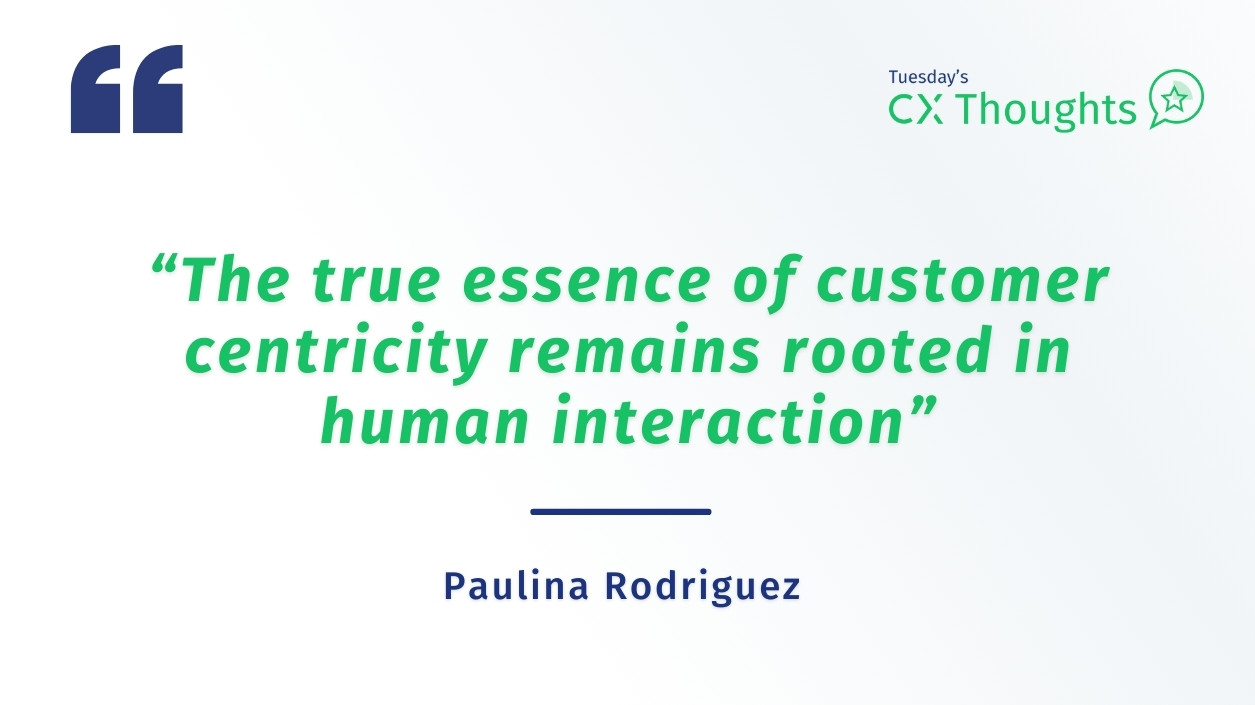
CX Shenanigans: Booth Duty and Beyond — Tuesday CX Thoughts
Jul 9, 2024
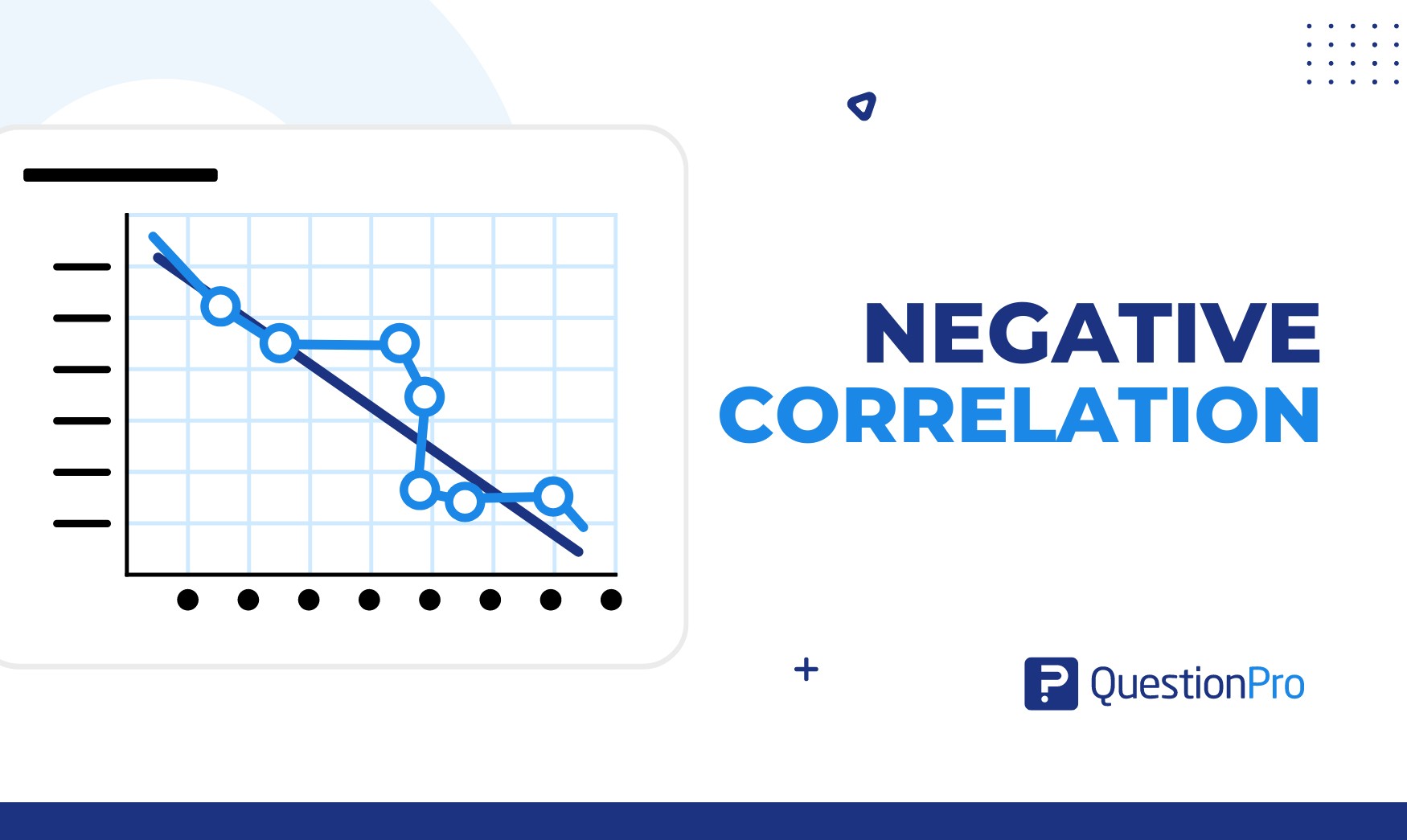
Negative Correlation: Definition, Examples + How to Find It?

Customer Marketing: The Best Kept Secret of Big Brands
Jul 8, 2024
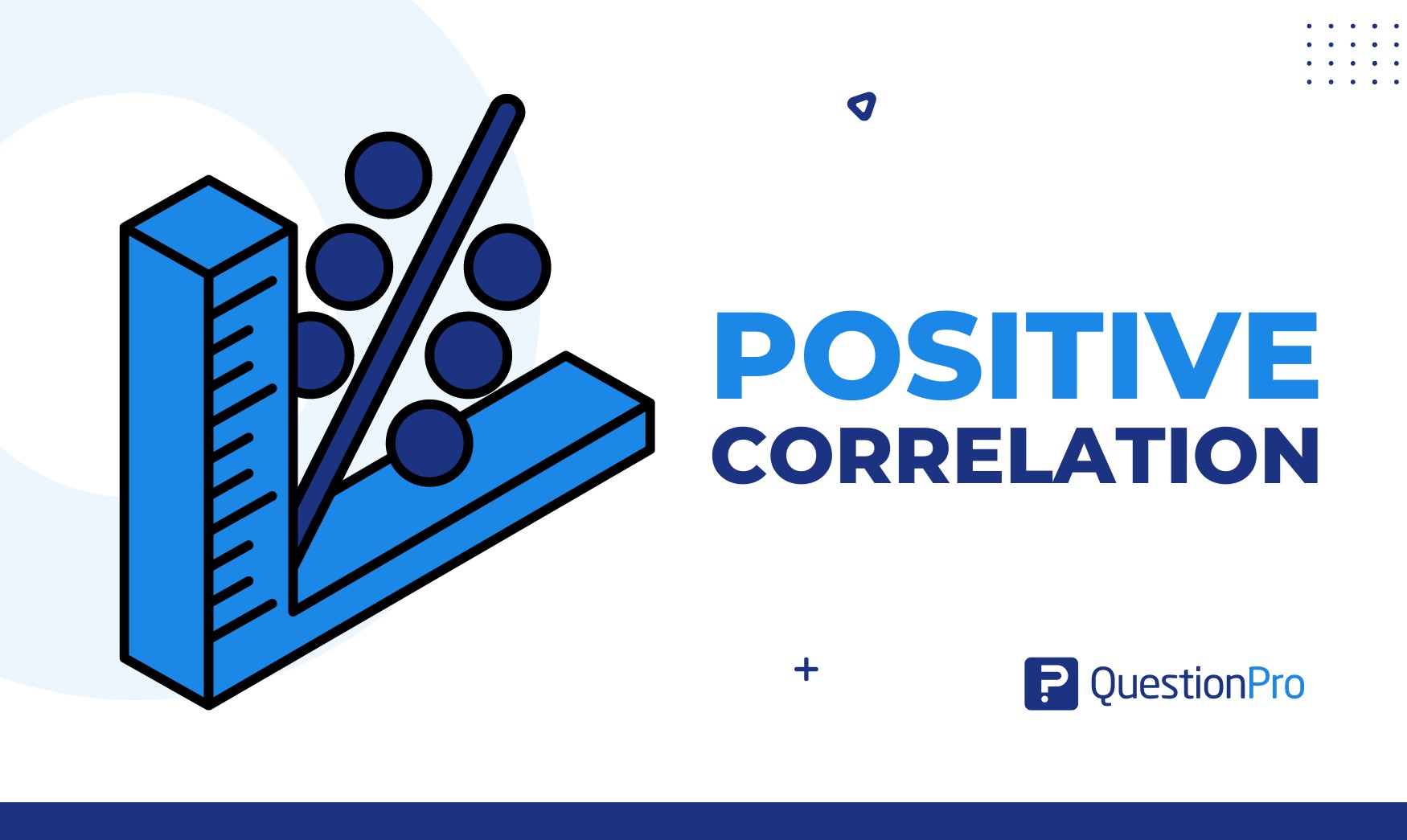
Positive Correlation: What It Is, Importance & How It Works
Jul 5, 2024
Other categories
- Academic Research
- Artificial Intelligence
- Assessments
- Brand Awareness
- Case Studies
- Communities
- Consumer Insights
- Customer effort score
- Customer Engagement
- Customer Experience
- Customer Loyalty
- Customer Research
- Customer Satisfaction
- Employee Benefits
- Employee Engagement
- Employee Retention
- Friday Five
- General Data Protection Regulation
- Insights Hub
- Life@QuestionPro
- Market Research
- Mobile diaries
- Mobile Surveys
- New Features
- Online Communities
- Question Types
- Questionnaire
- QuestionPro Products
- Release Notes
- Research Tools and Apps
- Revenue at Risk
- Survey Templates
- Training Tips
- Tuesday CX Thoughts (TCXT)
- Uncategorized
- What’s Coming Up
- Workforce Intelligence
Disclaimers for Surveys
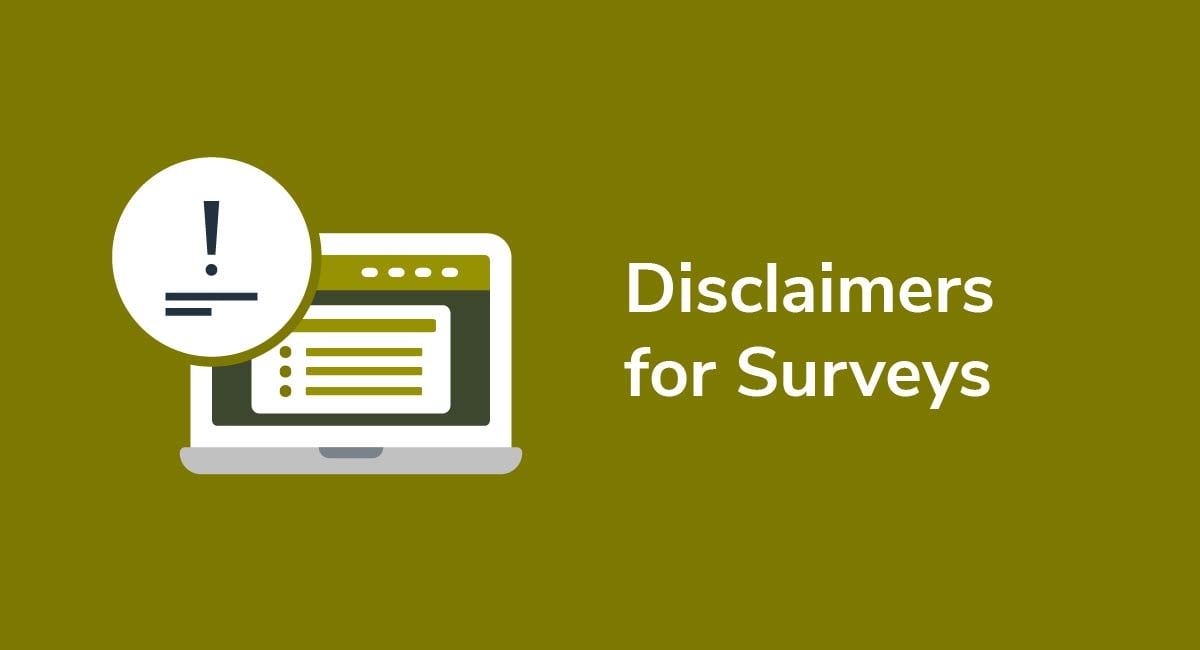
Surveys can provide organizations with valuable feedback that can be used to improve products and services. But collecting and processing personal data is inherently risky.
Thankfully, disclaimers for surveys can promote transparency , give participants peace of mind, and provide abundant protections for you and your organization.
In this article, we'll cover why disclaimers are so important for surveys, how to create them, and how to display them with your surveys.
Get compliant today with PrivacyPolicies.com
Select one of our generators to create the required legal agreements for your business:
- Our Privacy Policy Generator can help you generate a customized Privacy Policy in around three minutes, for free.
- Our Terms & Conditions Generator can help you generate a customized Terms & Conditions agreement in around three minutes, for free.
- Our EULA Generator can create a customized End-User License Agreement for your mobile or desktop app.
- Our Cookies Policy Generator can create a customized Cookies Policy to help your compliance with ePrivacy Directive and GDPR.
- Our Disclaimer Generator can create a disclaimer or disclosure for your website.
- Our Return & Refund Policy Generator can help your ecommerce store by creating a returns or refunds policy.
Integrate a free Cookies Notice and Cookie Consent banner to comply with the EU ePrivacy Directive and the new GDPR law regarding cookies.
- 1. What are Survey Disclaimers?
- 2. Are Disclaimers Required for Surveys?
- 3. Types of Survey Disclaimers
- 3.1. No Professional Relationship
- 3.2. Affiliate Links
- 3.3. Third Party Links
- 3.4. Copyright
- 3.5. Errors and Omissions
- 3.6. Consent
- 3.7. Compensation
- 3.8. Risks Associated with the Survey
- 4. How and Where to Display Disclaimers for Surveys
What are Survey Disclaimers?
Disclaimers for surveys are statements that let participants know important information like why you're conducting a survey, what types of data you'll collect, how it'll be used and protected, as well as for minimizing risk by rejecting future legal claims for damages resulting from errors, omissions, and specific acts.
They inform users of important information that can benefit them to know.
Are Disclaimers Required for Surveys?
While disclaimers for surveys aren't usually required by law, they sometimes can be a requirement. For example, in the U.S., the FTC requires that affiliate links come with an affiliate disclaimer .
Additionally, having such disclaimers can help limit your legal liability and keep your customers informed about important things. This is why you should have them even though it may not be a full legal requirement.
In effect, you may not need them, but you will definitely want them.
Types of Survey Disclaimers

There are a number of different types of survey disclaimers to consider. Some may be very appropriate for your survey, while others won't be relevant or needed. Consider the nature of your business and your survey to determine which disclaimers work best for you.
No Professional Relationship
No Professional Relationship disclaimers are particularly important when users might assume that participating in a survey or receiving feedback constitute a legitimate professional relationship.
This is especially true for legal and health-related surveys.
Baptist Health provides free online Health Risk Assessments designed to evaluate participant's health outlooks in the short and long terms.
The company includes the following clause in its Health Risk Assessment Disclaimer to establish that No Professional Relationship exists with users:
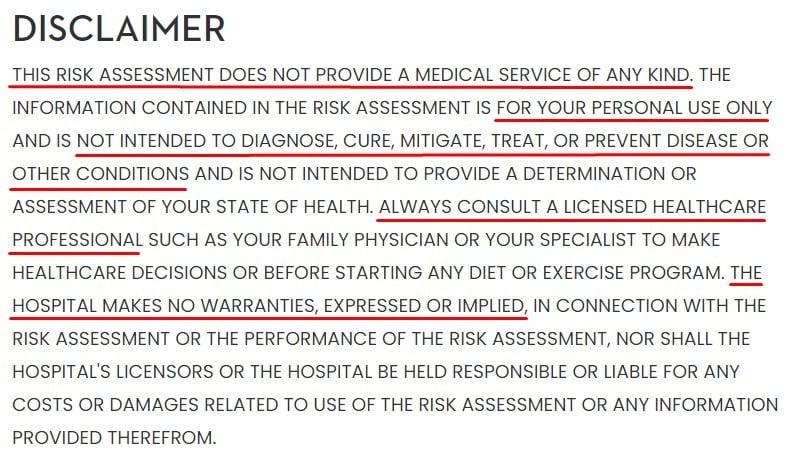
In the first sentence, Baptist Health's Disclaimer establishes that Risk Assessments are not a medical service.
It also lets users know that:
- The risk assessment survey is for personal use only and isn't intended to diagnose, mitigate or treat any condition or disease
- Users should always contact a licensed healthcare provider
- The hospital makes no expressed or implied warranties regarding the risk assessment
Affiliate Links
Affiliate disclaimers let users know that you may be compensated when they purchase a product or service from a third party that you linked to on your blog, website, or mobile app.
And to recap, the FTC requires that affiliate links come with affiliate disclaimers in the United States.
Here's Surveys Best Paid's Affiliate Disclaimer:
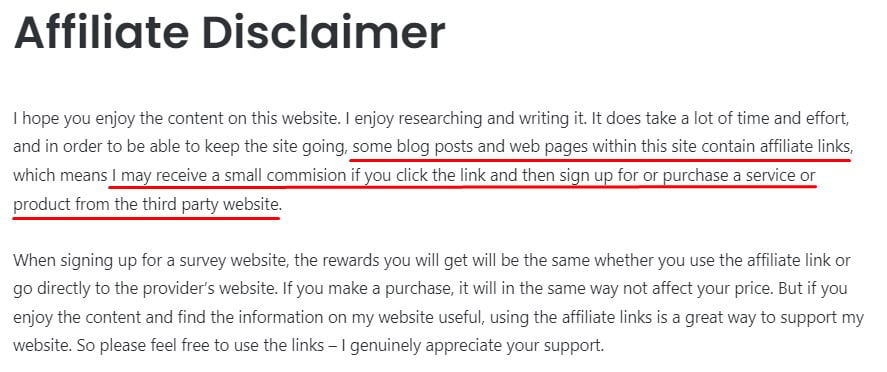
Third Party Links
If your survey links to other sites, you can benefit from a disclaimer that states you take no responsibility for the content on those other sites. This can keep you safe from liability for anything that goes awry on the other site.
Adaptive Surveys lets users know that it's not responsible for content found on websites it links to.

In the United States, copyright law covers everything from paintings and photos to software and written content.
As such, it's wise to let users know in your survey disclaimer that the content on your website and surveys is your property and can't be used without your permission.
Here's how survey company Polco addresses copyright enforcement:
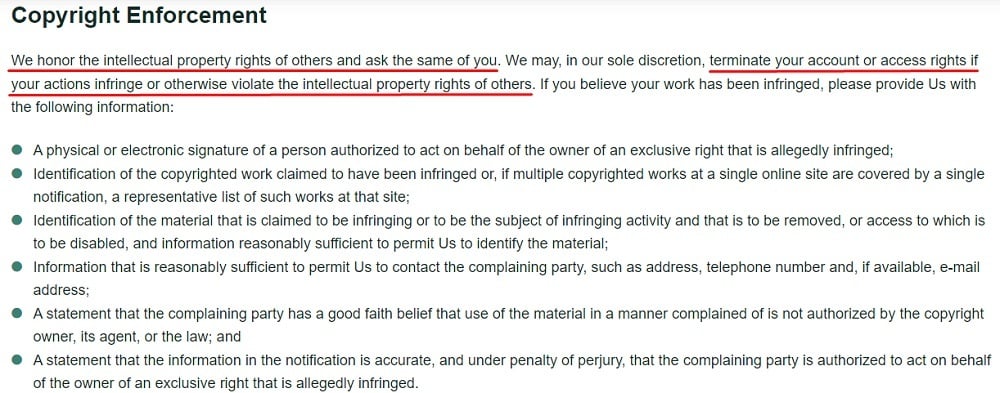
Polco makes it clear that respecting copyright is a two way street, and that it can terminate user's accounts if they violate the property rights of other users or the company.
Polco also provides a bullet pointed list of steps users must take if they think the company has violated their property rights.
You can and should also include a standard copyright disclaimer with your survey to protect its content.
Errors and Omissions
Surveys, websites, and mobile apps are rarely complete and error free.
By addressing this in your survey disclaimer, you can let users know that you aren't liable for damages if issues arise from inaccurate, incomplete, or missing information.
1823 is a program managed by the Efficiency Office of the Hong Kong Special Administrative Region Government in which online participants answer questions and comment about their experiences with various government agencies.
The following excerpt from the 1823 Website Survey Disclaimer shows how errors and omissions are addressed:
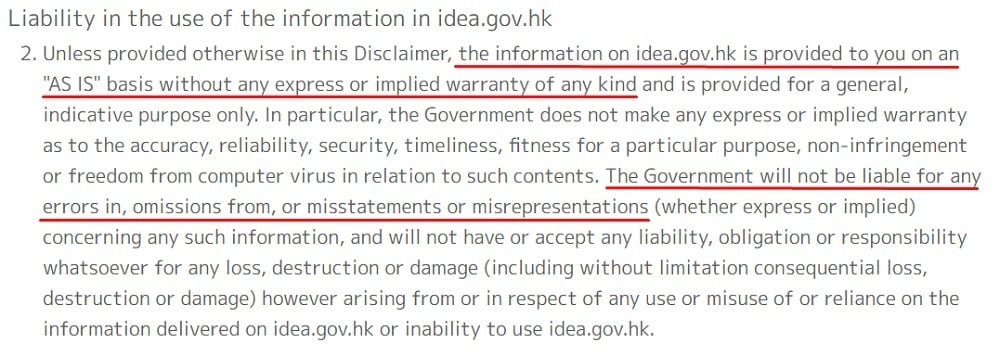
This disclaimer states that information is provided "as is," and that the government isn't responsible for errors, omissions, misstatements, or misrepresentations.
It's a good idea to get consent from each participant before giving them access to the survey and beginning the data collection process.
Here's how Harvard University's Center for Education Policy Research addresses the issue of Consent for those considering participating in its Year-two Control School Leader Survey :
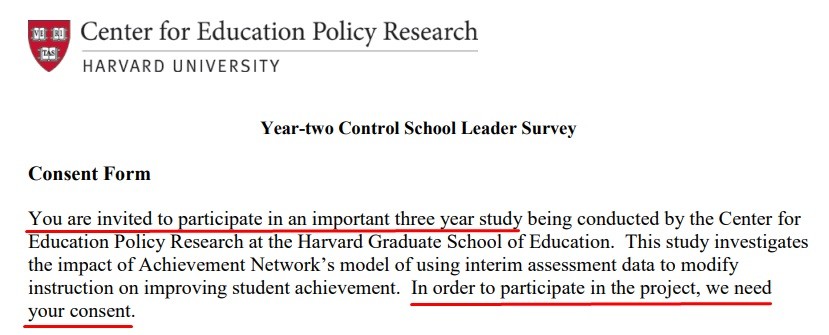
In addition to giving students a brief overview of the study, the opening paragraph makes it clear that consent is required before participation .
Consent forms may also ask users to affirm that:
- They are participating voluntarily
- They are legally an adult in the jurisdiction in which they live
- They have read and understand the information provided
- Compensation
Companies that provide contract survey services generally compensate users for participating.
Compensation is a great way to entice people who may not participate otherwise. However, even with unpaid surveys, people may participate out of a sense of duty or because they think their input will help bring about positive change.
Here's how Harvard University addresses compensation for its Year-two Control School Leader Survey :

In this case participants receive two gift cards, and Harvard lets them know when they'll get each one.
Risks Associated with the Survey
Most surveys aren't particularly risky, but participation can lead to social, economic, and psychological risks when data is leaked or anonymity is compromised.
Here's how Bowling Green State University addresses risk for its campus recycling survey:

Data risks are another real thing to consider. You'll have a tough time rounding up survey participants if you can't assure them that their data will be protected while it's in your possession.
For this reason and others, data and identity protection should be addressed early on.
In its consent form, Harvard lets participants know that collected information will be reported anonymously without any personal identifying information:

Remember that it's normal that you may need either all of these disclaimers, or just one or maybe two. It really depends on the nature of your survey and your business, and some of these disclaimers may just not apply to you.
How and Where to Display Disclaimers for Surveys

General survey information and disclaimers are typically placed at the beginning of a survey or linked within other legal agreements such as a Terms agreement.
Since many surveys are conducted online, you can present your disclaimers in text before a user officially starts a survey, as seen here from Bowling Green State University:
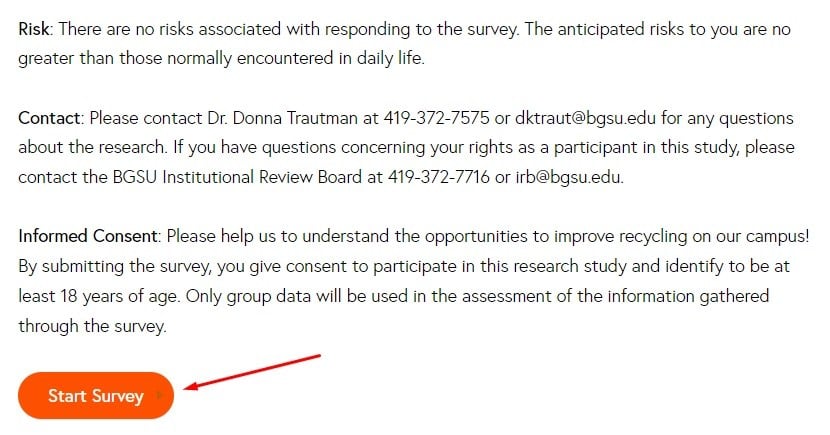
In addition, disclaimers for surveys are sometimes found within Terms and Conditions agreements or other similar terms documents.
In the following example, the University of Victoria has a separate Terms of Service agreement that solely applies to its relationship with survey company SurveyMonkey:

In its survey disclaimer, the University of Victoria lets users know that:
- Round-the-clock access to Survey Monkey's website isn't guaranteed
- It's not responsible to for third party content linked to on SurveyMonkey's web pages
Privacy Policies are also worthwhile places to include survey disclaimers and other survey-related information.
In the following example, The University of Roehampton notes how the data it collects - including that from surveys - may be used or shared:
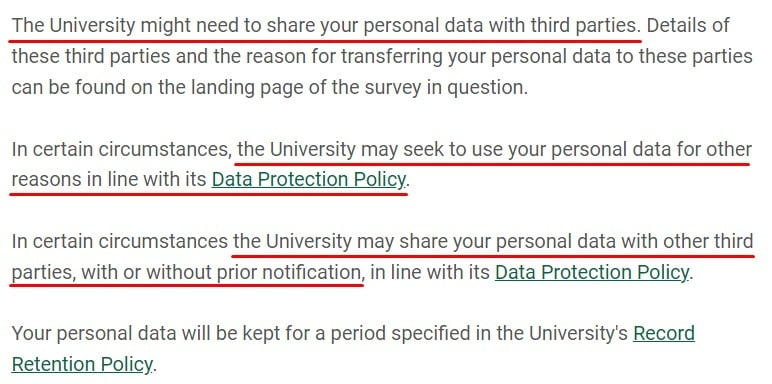
The University uses its Privacy Notice to let participants know that:
- Their personal data may be shared with third parties, with or without prior notification (if so, more information can be found on individual survey landing pages)
- The University may seek to use collected data for additional reasons
- The data storage term will be in accordance with the University's Record Retention Policy
Surveys can provide valuable information that can help organizations remain competitive by improving their products and services.
By including well-written survey disclaimers, you can protect yourself and your organization while letting participants know what important information relevant to them when taking your survey.
Disclaimers for surveys can vary greatly, but here's a list of some standard types:
- Professional relationships
- Affiliate links
- Third party links
- Errors and omissions
Disclaimers for surveys are generally displayed somewhere close to the survey, such as at the start of it before a user answers the first question, and also within Terms and Conditions agreements.
Matthew Copes PrivacyPolicies.com Legal writer
Last updated on 23 June 2023
Legal information, legal templates and legal policies are not legal advice. Please read the disclaimer .
Article categories
- Disclaimers
- #1 Privacy Policy Generator
- Cookies Policy Generator
- Terms and Conditions Generator
- EULA Generator
- Return & Refund Policy Generator
- Disclaimer Generator
- Cookie Consent
Related articles
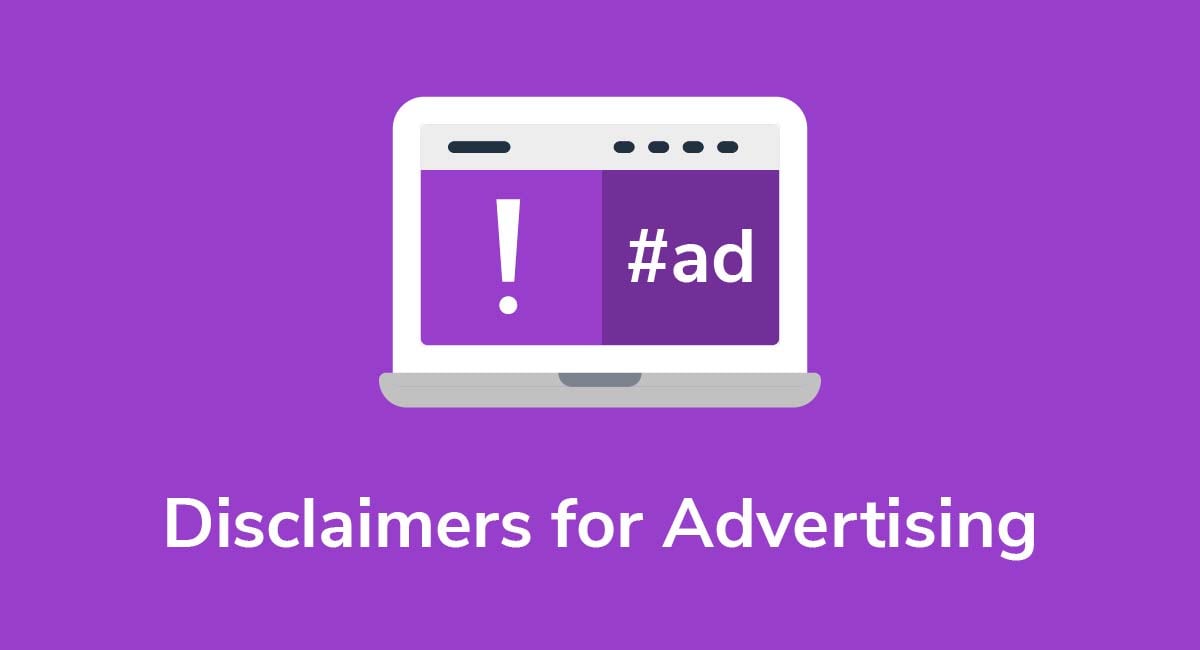
Disclaimers for Advertising
Advertising disclaimers are short statements displayed on advertisements that declare that the content is an ad. These disclaimers help protect a business from various types of legal claims, while also...
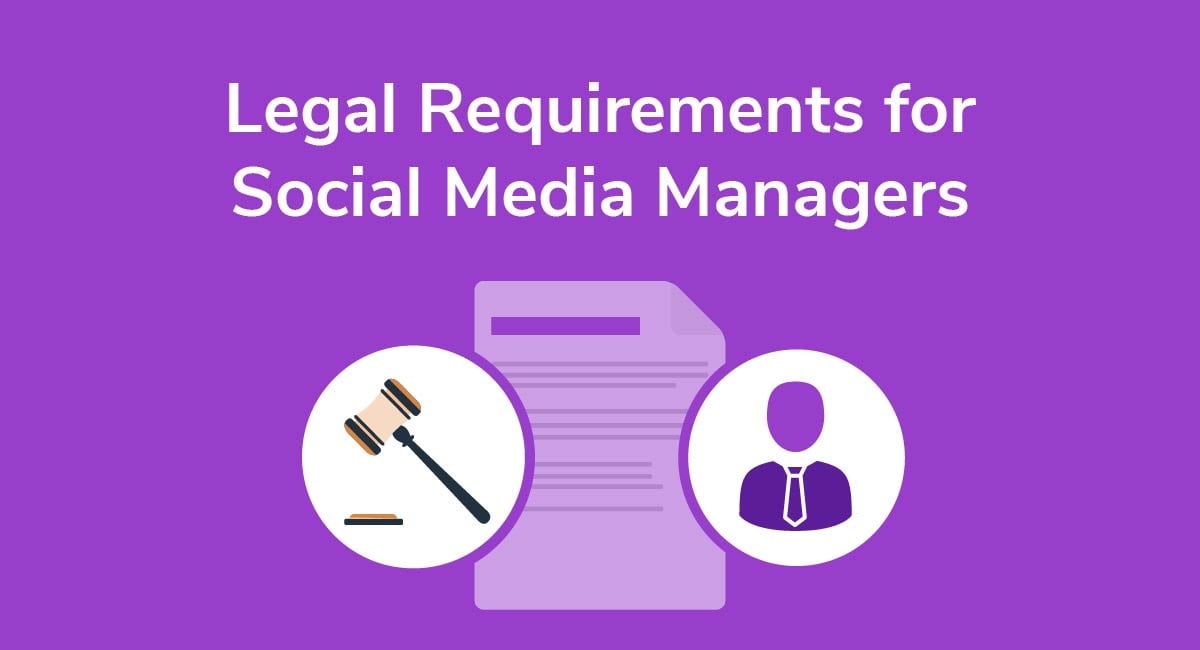
Legal Requirements for Social Media Managers
Social media is reshaping the world before our very eyes. According to We Are Social, there were 2.8 billion social media users worldwide in 2017 - that's 37% of the...
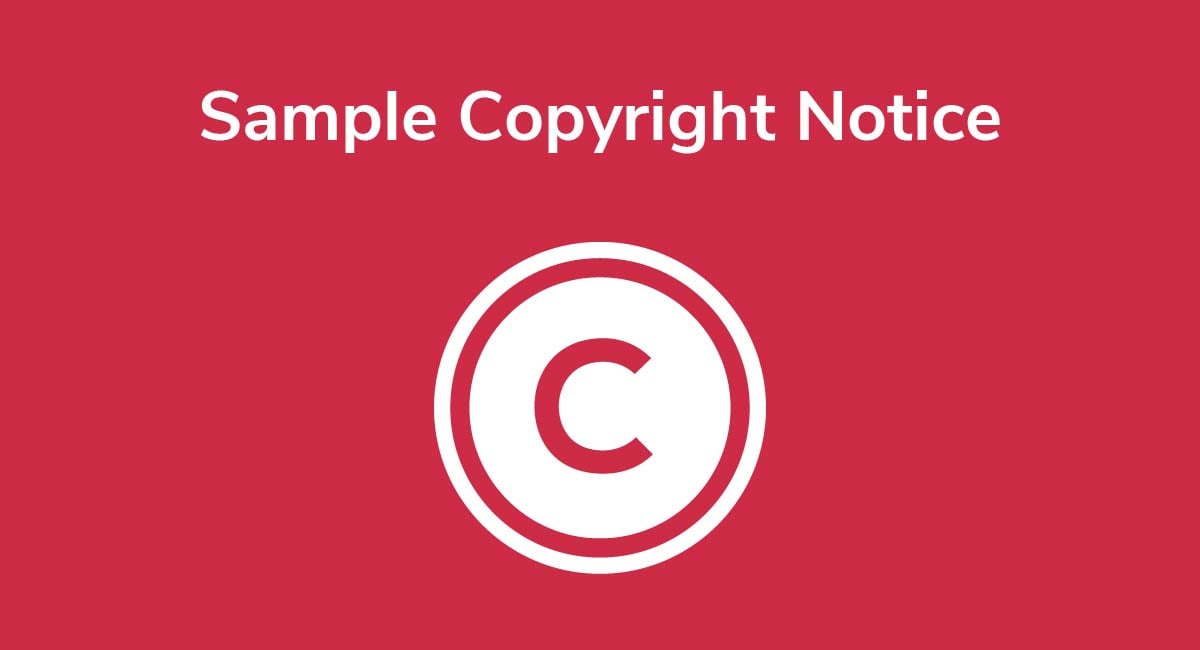
Sample Copyright Notice
If you've created something new, and you don't want anyone to copy it or redistribute it without your permission, then you should put a Copyright Notice on your website. A Copyright...

Dissertation Format and Submission
- Dissertation Submission
- Getting Survey Permissions
- Help Videos
Download a PDF of this FAQ
Download the template permission letter, instrument permissions faq, permissions to use and reproduce instruments in a thesis/dissertation frequently asked questions, why might i need permission to use an instrument in my thesis/dissertation.
- Determine whether you need permission
- Identify the copyright holder
- Ask for permission
- Keep a record
- What if I can't locate the copyright holder?
If you want to use surveys, questionnaires, interview questions, tests, measures, or other instruments created by other people, you are required to locate and follow usage permissions. The instrument may be protected by copyright and/or licensing restrictions.
Copyright Protection
Copyright provides authors of original creative work with limited control over the reproduction and distribution of that work. Under United States law, all original expressions that are “fixed in a tangible medium” are automatically protected by copyright at the time of their creation. In other words, it is not necessary to formally state a declaration of copyright, to use the © symbol, or to register with the United States Copyright Office.
Therefore, you must assume that any material you find is copyrighted, unless you have evidence otherwise. This is the case whether you find the instrument openly on the web, in a library database, or reproduced in a journal article. It is your legal and ethical responsibility to obtain permission to use, modify, and/or reproduce the instrument.
If you use and/or reproduce material in your thesis/dissertation beyond the limits outlined by the “fair use” doctrine, which allows for limited use of a work, without first gaining the copyright holder’s permission, you may be infringing copyright.
Licensing/Terms of Use
Some instruments are explicitly distributed under a license agreement or terms of use. Unlike copyright, which applies automatically, users must agree to these terms in order to use the instrument. In exchange for abiding by the terms, the copyright holder grants the licensee specific and limited rights, such as the right to use the instrument in scholarly research, or to reproduce the instrument in a publication.
When you ask a copyright holder for permission to use or reproduce an instrument, you are in effect asking for a license to do those things.
How do I know if I need permission to use instruments in my thesis/dissertation research? (Adapted from Hathcock & Crews )
Follow the four-step process below:
1. Determine whether you need permission
There are different levels of permissions for using an instrument:
a) No permission required
i. The copyright holder has explicitly licensed the use of instrument for any purpose, without requiring you to obtain permission.
ii. If you are only using a limited portion of the instrument, your use may be covered under the Fair Use Doctrine. See more here: https://uhcl.libguides.com/copyright/fairuse .
iii. If the instrument was developed by the federal government or under a government grant it may be in the public domain, and permission is therefore not required.
iv. If the document was created before 1977, it may be in the public domain, and permission is therefore not required. See the Stanford Public Domain Flowchart at https://fairuse.stanford.edu/wp-content/uploads/2014/06/publicdomainflowchart.png .
b) Non-commercial/educational use: The copyright holder has licensed the instrument only for non-commercial research or educational purposes, without requiring you to obtain the permission of the copyright holder. Any other usage requires permission.
Sample Permission for Educational Use:
Test content may be reproduced and used for non-commercial research and educational purposes without seeking written permission. Distribution must be controlled, meaning only to the participants engaged in the research or enrolled in the educational activity. Any other type of reproduction or distribution of test content is not authorized without written permission from the author and publisher. Always include a credit line that contains the source citation and copyright owner when writing about or using any test.
Source: Marta Soto, “How Permissions Work in PsycTests,” APA Databases & Electronic Resources Blog. American Psychological Association. http://blog.apapubs.org/2016/12/21/how-permissions-work-in-psyctests/ .
Even if you are not required to obtain permission to use the instrument, consider contacting the author for ideas on how to administer and analyze the test. Authors often welcome further use of their work, and may request you send them a copy of your final work.
c) Permission required: Instruments that require you to obtain the permission of the copyright holder, regardless of whether the use is for educational or commercial purposes. This may be because the copyright holder
- has important directions for how the test must be administered and analyzed
- wants to make sure the most current version is being used
- charges users a fee in order to administer the test
If you cannot locate the permissions, you are required to identify the copyright holder and contact them to ask about permission to use the instrument.
2. Identify the copyright holder (Adapted from Crews )
The next step is to identify who owns the copyright. The copyright holder is usually the creator of the work. If the copyright owner is an individual, you will need to do the usual Internet and telephone searches to find the person. Be ready to introduce yourself and to explain carefully what you are seeking.
Some authors transfer copyright to another entity, such as a journal publisher or an organization. In these cases, you must obtain permission from that entity to use or reproduce the instrument. You can often identify the owner by locating a © copyright notice, but as mentioned above, not all copyrighted works have a notice.
Check the following sources to locate instruments, their copyright holders, and their permission statements:
- Mental Measurements Yearbook: https://uhcl.idm.oclc.org/login?url=https://search.ebscohost.com/login.aspx?authtype=ip,uid&profile=ehost&defaultdb=mmt
- PsycTESTS: https://uhcl.idm.oclc.org/login?url=https://search.ebscohost.com/login.aspx?authtype=ip,uid&profile=ehost&defaultdb=pst
- Neumann Library Tests & Measures help: https://uhcl.libguides.com/PSYC/tests
- Library assistance e-mail: [email protected]
You may need to contact the author or publisher directly to find out who owns the copyright. Publishers often have websites that prescribe a method for contacting the copyright owner, so search the publisher website for a permissions department or contact person. Be sure to confirm the exact name and address of the addressee, and call/e-mail the person or publishing house to confirm the copyright ownership.
- The copyright owner may prefer or require that permission requests be made using a certain medium (i.e. fax, mail, web form, etc.). If you do not follow instructions, you may not get a reply.
- Telephone calls may be the quickest method for getting a response from the owner, but they should be followed up with a letter or e-mail in order to document the exact scope of the permission. E-mail permissions are legally acceptable in most cases, but getting a genuine signature is usually best.
- The request should be sent to the individual copyright holder (when applicable) or permissions department of the publisher in question. Be sure to include your return address, telephone and fax numbers, e-mail address, and the date at the top of your letter or message. If you send the permission request by mail, include a self-addressed, stamped return envelope.
- Make the process easy for the copyright owner. The less effort the owner has to put forth, the more likely you will get the permission you need. If you are using conventional mail, include a second copy of your request for the owner’s records.
- State clearly who you are, your institutional affiliation (e.g., University of Houston-Clear Lake), and the general nature of your thesis/dissertation research.
Do not send permissions letters to all possible rightsholders simultaneously. Taking the time to find the person who most likely holds the copyright will better yield success. If you do not have much information about who actually owns the copyright, be honest with your contacts, and they may be able to help you find the right person.
3. Ask for permission (Adapted from Crews )
Once you have identified the copyright holder, you must determine the scope of your permission request. Some copyright owners furnish their own permission form that you may download from their website.
If the copyright owner does not provide a permission agreement form, you may write your own letter ( click here to download a template ). Requests should be made in writing; e-mail is fine for this purpose. A most effective letter will include detailed information concerning your request for permission to use the work. Include the following information:
- Who: Introduce yourself. Tell who you are, your degree program, and a brief overview of your research.
- Why: Tell why you are contacting that person or entity for permission.
- What: Be as specific as possible when you cite and describe the instrument you wish to use. Include whether you plan to use the entire instrument, or if you plan on modifying or adapting any of the questions.
- How: Tell how you plan to use the instrument. Specify the parameters of your research study, and include any important information about the way you will administer the instrument and/or analyze the results.
- When: Expected length of the project and time to complete the thesis/dissertation.
Important : Obtaining permission to use an instrument is not the same as obtaining permission to reproduce the instrument in your appendix. If you intend on providing a copy of the instrument in an appendix, ask for separate permissions to do that.
Click here to download a template letter . Feel free to modify and adapt this template for your purposes.
4. Keep a record
After securing permission to use and/or reproduce the instrument, save a copy of the correspondence and the agreement. Documentation allows you to demonstrate to others that you have the legal right to use the owner's work. In the unlikely event that your use of the work is ever challenged, you will need to demonstrate your good faith efforts. That challenge could arise far in the future, so keep a permanent file of the records. Moreover, you might need to contact that same copyright owner again for a later use of the work, and your notes from the past will make the task easier.
Upload a copy of your permission letter in Vireo with your thesis/dissertation, or include it as an appendix in the document itself.
What if I can't locate the copyright holder? (Adapted from Hathcock & Crews & Pantalony )
In some cases, you may never get a response from the copyright holder or you may never even be able to identify who they are or how to contact them. It can be difficult to know how to proceed when you reach a dead end. Unfortunately, no matter how diligently you have tried to get permission, these efforts cannot completely eliminate the risk of infringement should you proceed to use the work.
Assuming you have diligently investigated your alternatives, do not want to change your project, and remain in need of the elusive copyright permission, the remaining alternative is to explore a risk-benefit analysis. You need to balance the benefits of using that particular material in your given project against the risks that a copyright owner may see your project, identify the materials, and assert the owner’s legal claims against you. Numerous factual circumstances may be important in this evaluation. The “benefit” may depend upon the importance of your project and the importance of using that particular material. The “risks” may depend upon whether your project will be published or available on the Internet for widespread access—as theses and dissertations will. You ought to investigate whether the work is registered with the U.S. Copyright Office and weigh the thoroughness of your search for the copyright owner and your quest for appropriate permission.
Undertaking this analysis can be sensitive and must be advanced with caution and with careful documentation. You may be acting to reduce the risk of liability, but you have not eliminated liability. A copyright owner may still hold rights to the material. Members of the University of Houston-Clear Lake community should consult with their chair or the Neumann Library to discuss their options.
Portions of this FAQ are used and adapted from:
Crews, Kenneth and Rina Elster Pantalony. “Special Cases.” Columbia University Copyright Advisory Services. https://copyright.columbia.edu/basics/special-cases.html . Licensed under Creative Commons Attribution 4.0 International (CC BY 4.0).
Crews, Kenneth. “Asking for Permission.” Columbia University Advisory Services. https://copyright.columbia.edu/basics/permissions-and-licensing.html . Licensed under Creative Commons Attribution 4.0 International (CC BY 4.0).
Hathcock, April. “Getting Permission.” NYU Libraries Copyright Library Guide, https://guides.nyu.edu/c.php?g=276785&p=1845968 . Licensed under Creative Commons Attribution-NonCommercial 4.0 International (CC BY-NC 4.0).
- << Previous: Dissertation Submission
- Next: Help Videos >>
- Last Updated: Jun 4, 2024 12:48 PM
- URL: https://uhcl.libguides.com/dissertation
| Bayou Building 2402, 2700 Bay Area Blvd, Houston, TX 77058-1002 |
Survey Disclaimers

William Blesch
Legal and data protection research writer at TermsFeed.

Reviewed by
Sara Pegarella
Widener University School of Law graduate, Managing Legal Editor at TermsFeed.

If your business or website uses surveys to collect personal information, including a survey disclaimer is an excellent way to protect your business and your users.
This article breaks down what survey disclaimers are, what they should include, and how to create your own.
Our Disclaimer Generator can generate a legal disclaimer for your business, website or mobile app. Just follow these steps:
At Step 1, select where your Disclaimer will be used.
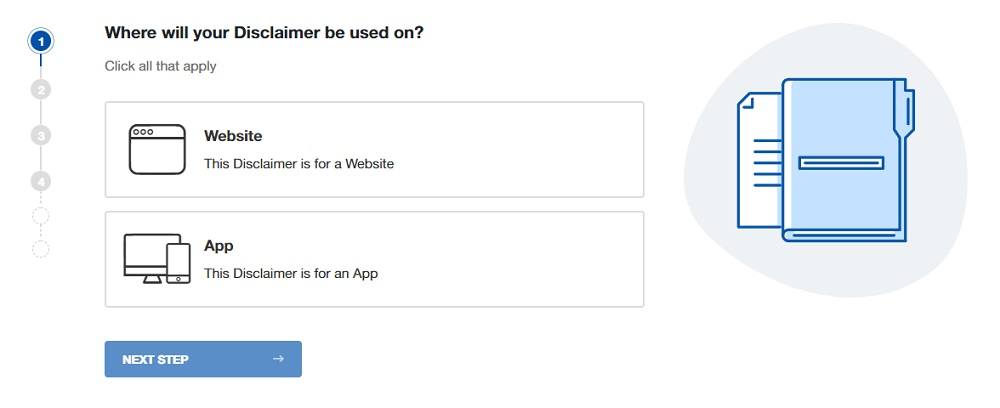
At Step 2, add in information about your website/app and business.
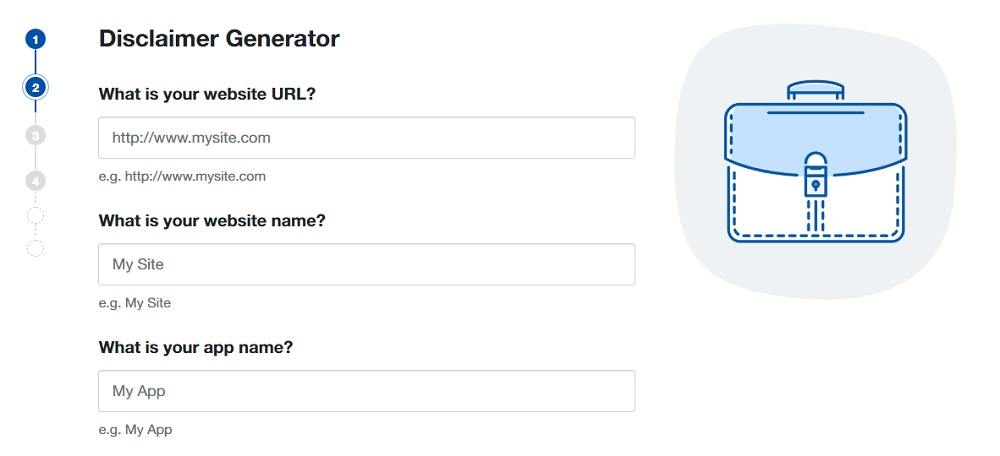
Answer some questions about your business practices.
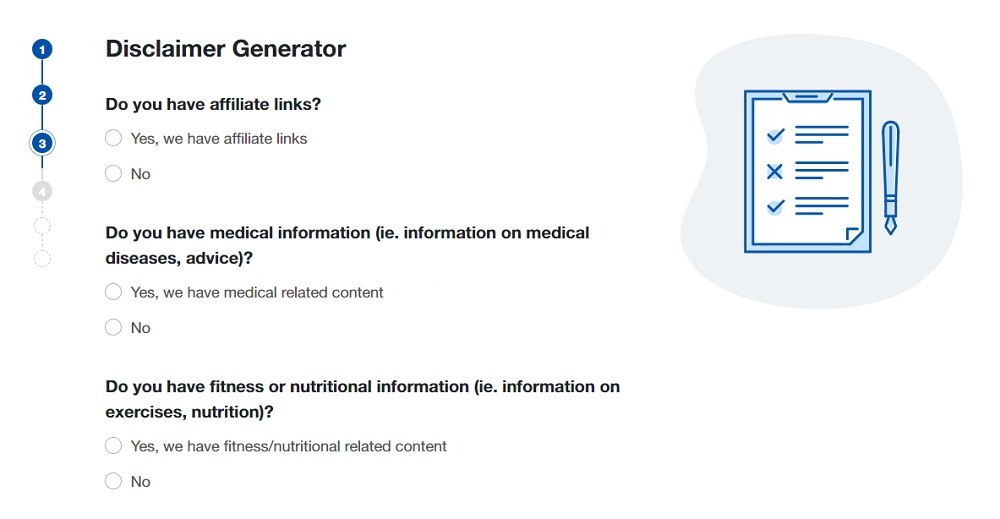
Enter an email address where you'd like to receive your Disclaimer and click "Generate."
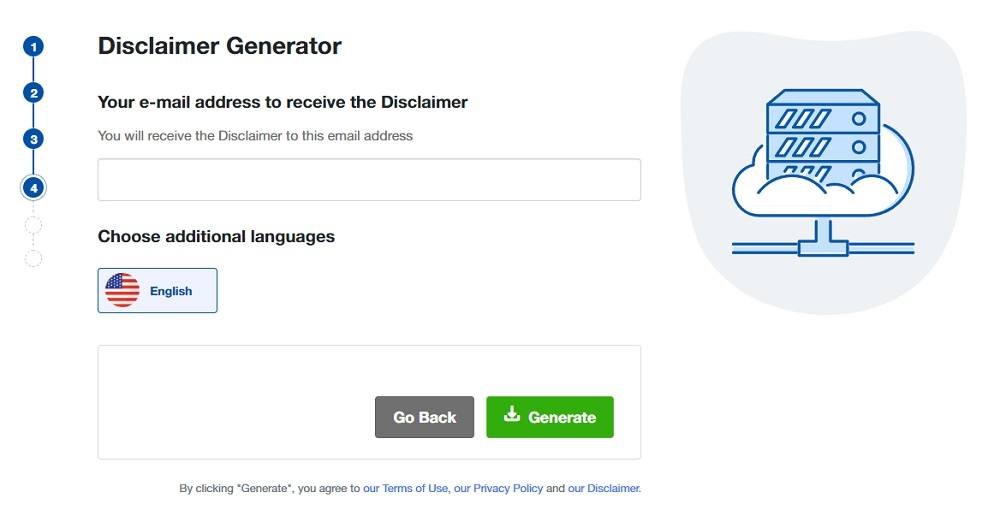
Done! You'll be able to instantly access and download your new Disclaimer.
- 1. What are Survey Disclaimers?
- 2. Why are Survey Disclaimers Important?
- 3. Are there Specific Laws and Regulations Requiring Survey Disclaimers?
- 4. How Do I Write a Survey Disclaimer?
- 4.1. Data Protection and Legal Compliance
- 4.2. There is No Professional Relationship Formed
- 4.3. Affiliate Links
- 4.4. Third-Party Links
- 4.5. Copyright
- 4.6. Compensation
- 4.7. Risks Linked to the Survey
- 5. Where Should I Display Disclaimers for Surveys?
- 6. What are the Consequences of Not Including a Survey Disclaimer?
What are Survey Disclaimers?
A survey disclaimer is a short text statement that gets included with a survey to inform survey takers of something.
They are the same as any other disclaimers, except they are associated with an online survey.
Why are Survey Disclaimers Important?
Survey disclaimers are important because they help establish trust with survey participants, and inform them of important information regarding the survey.
They also help limit liability in the same way that other disclaimers do.
Are there Specific Laws and Regulations Requiring Survey Disclaimers?
No, not specifically. However, if your survey collects legally protected personal information , it will trigger the requirement to have and display a Privacy Policy on the site where you have the survey.
For more information on laws that require a Privacy Policy if personal information is collected, such as through a survey, check out our feature articles:
- Privacy Policies are Mandatory by Law
- Privacy Laws By Country
How Do I Write a Survey Disclaimer?
There are a variety of ways to write a survey disclaimer, depending on the nature of your business and the survey itself.
Here are a few ways to write a disclaimer that may be appropriate for your survey.
Data Protection and Legal Compliance
If a survey collects personal information, such as a name or email address, you can let users know that you take steps to protect the personal information and to comply with laws.
Here's how Endometrix's survey disclaimer addresses data collection and laws:
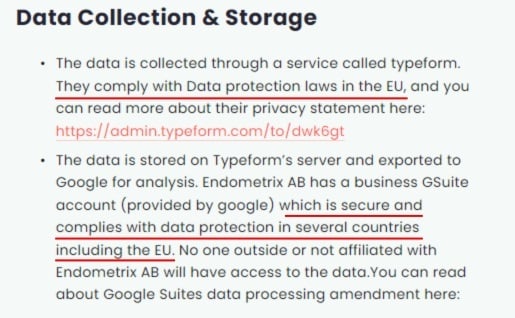
You can include a reminder in your survey itself, as seen below, to not include any personal or confidential information:
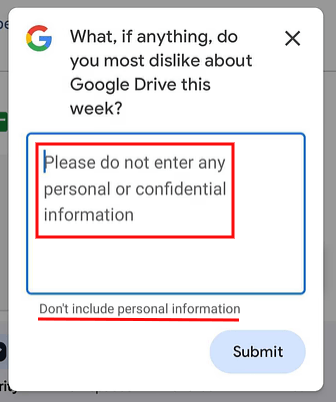
There is No Professional Relationship Formed
If your survey may be perceived as creating a relationship between you and the survey taker, you can use a disclaimer to help ensure that survey takers know that they are not becoming your client, patient, etc. by taking the survey.
This disclaimer is particularly relevant for surveys that ask medical or legal questions.
For example, OSF Healthcare clarifies that there's no professional relationship formed with users. The company incorporates the following statement in its Health Risk Assessment Disclaimer:
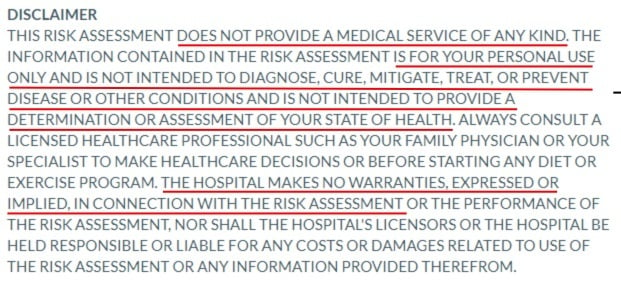
In its initial statement, OSF Healthcare's Disclaimer clarifies that risk assessments do not equate to a medical service.
It also informs users that:
- The risk assessment survey is designed solely for individual use and isn't aimed at diagnosing, alleviating, or addressing any health condition or ailment
- Engaging a licensed healthcare professional is always recommended
The hospital offers no explicit or implied guarantees concerning the risk assessment.
Affiliate Links
If your survey includes affiliate links, inform users that you might receive compensation if they buy a product or service from a third-party source you've linked to on your blog, website, or mobile application.
In the United States, the FTC mandates the presence of affiliate disclaimers alongside affiliate links.
Here's an example of a disclaimer used by Awesome Survey Reviews :
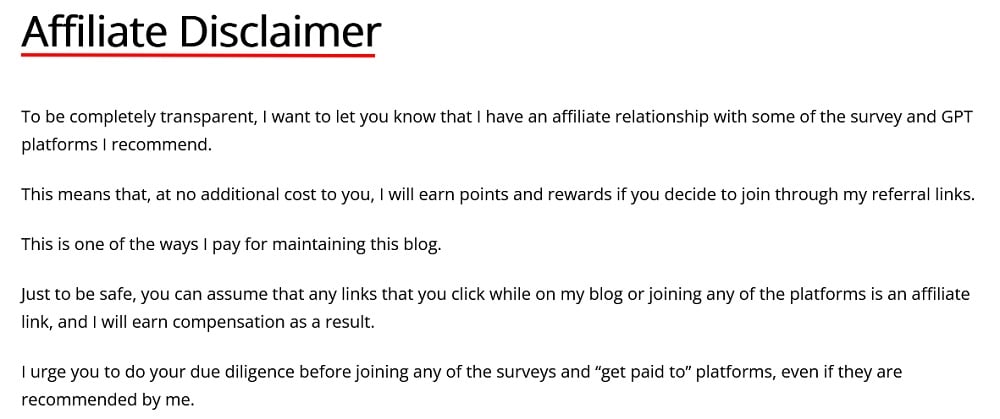
Third-Party Links
If your survey includes links that direct users to external sites, include a disclaimer specifying that you're not accountable for the content on those linked sites.
This can protect you from potential liabilities stemming from issues on those third-party platforms.
Here's how The Anti Fragile Survey lets users know that it's not responsible for content found on websites it links to:
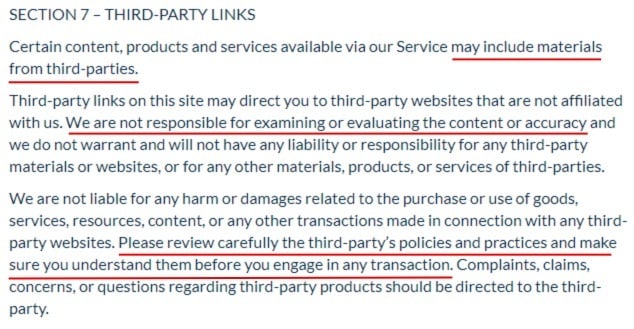
You should inform users through your survey disclaimer that the material on your website and in your surveys is proprietary and unauthorized usage without your consent is prohibited.
Here's how CPR Survey does this:
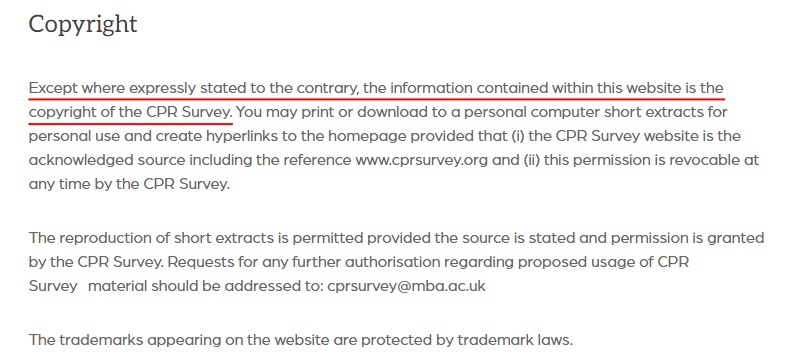
As you can see, CPR Survey asserts its copyright over the content on this website unless explicitly stated otherwise.
Compensation
If you give monetary compensation to survey-takers, let them know any important information about how compensation will work, such as if there are tax responsibilities.
The Society of Manufacturing Engineers includes language about compensation related to its surveys and promotions on its survey disclaimer page:
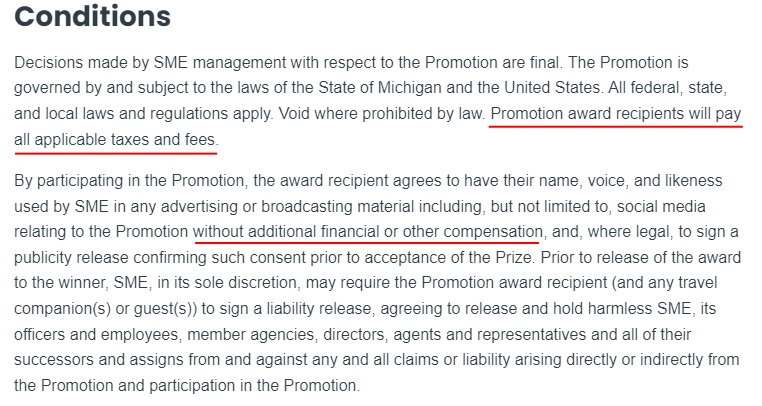
Risks Linked to the Survey
While many surveys pose minimal risk, participants can face social, economic, and psychological challenges if data breaches occur or anonymity is lost.
Here's an example of how you can disclose this in a disclaimer survey:

Where Should I Display Disclaimers for Surveys?
For a survey disclaimer to truly serve its purpose, both its content and its placement are pivotal. Some optimal places to display your survey disclaimer include the following:
Beginning of the Survey : Placing your disclaimer at the beginning of the survey helps make sure that participants have a chance to view it before starting the survey.
Here's an example of how this can look, with the survey disclaimer posted above the link that takes someone to the survey:
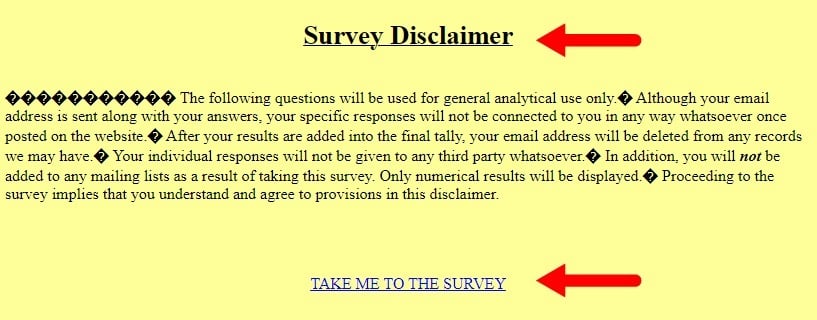
Footer of the Website : Another strategic location is within the footer of your website. A link labeled "Survey Disclaimer" can direct users to the detailed terms, ensuring that they're always accessible to anyone visiting your site.
Within a Terms and Conditions agreement : Consider adding your survey disclaimer within your Terms and Conditions agreement.
On Device Research has a separate Terms and Conditions agreement for surveys, but you could simply add a clause like this one here to your standard T&C:
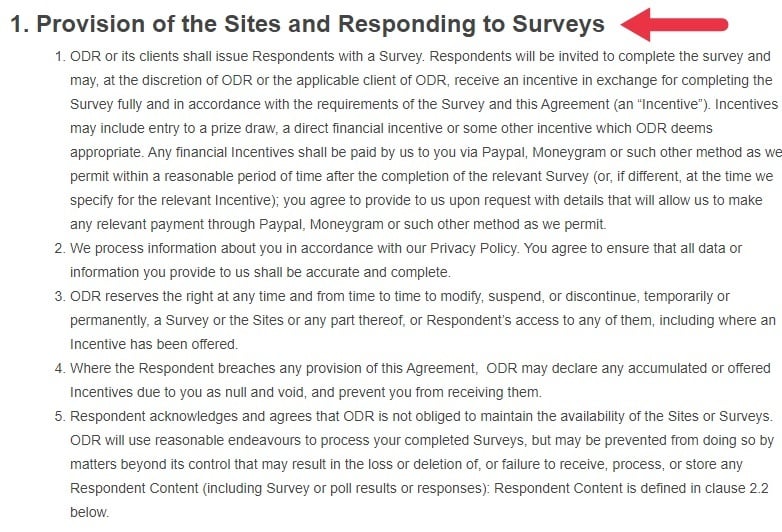
What are the Consequences of Not Including a Survey Disclaimer?
Not including a survey disclaimer can lead to legal issues and trust issues.
Without a clear disclaimer, you open yourself up to potential legal challenges. Respondents could claim misrepresentation, misuse of data, or even violation of privacy rights.
If participants were not made aware of the purposes or potential uses of their data and harm results, they might seek legal redress. In many jurisdictions, laws regarding data collection and user consent are stringent, and failing to adhere can result in fines or lawsuits.
Surveys, especially those in the fields of medical research or social sciences, often deal with sensitive information. Absence of a clear disclaimer can blur ethical boundaries, especially if participants are unaware of potential risks or how their data might be used.
Ethical malpractices can tarnish your reputation and lead to a loss of professional credibility.
Trust is fundamental to a respondent's willingness to participate in a survey. If participants feel their information might be misused or that they were deceived about the survey's nature, they may become wary of future interactions.
Word of mouth can amplify these concerns, making it harder to recruit participants in the future.
Having a clear and well-structured survey disclaimer is crucial. Not only does it shield your organization from potential liabilities, but it also keeps participants informed about important information related to your survey.
While there's a wide range of potential disclaimers for surveys, some common ones include:
- Clarifying professional relationships
- Highlighting affiliate links
- Noting third-party links
- Stating copyright protection
- Explaining compensation
- Detailing potential risks
It's common practice to position these disclaimers prominently, typically at the survey's outset and within the Terms and Conditions, ensuring participants see them before diving in.
Comprehensive compliance starts with a Privacy Policy.
Comply with the law with our agreements, policies, and consent banners. Everything is included.
Generate Privacy Policy
This article is not a substitute for professional legal advice. This article does not create an attorney-client relationship, nor is it a solicitation to offer legal advice.
Last updated on
12 May 2024
- Disclaimer Agreements
Related articles
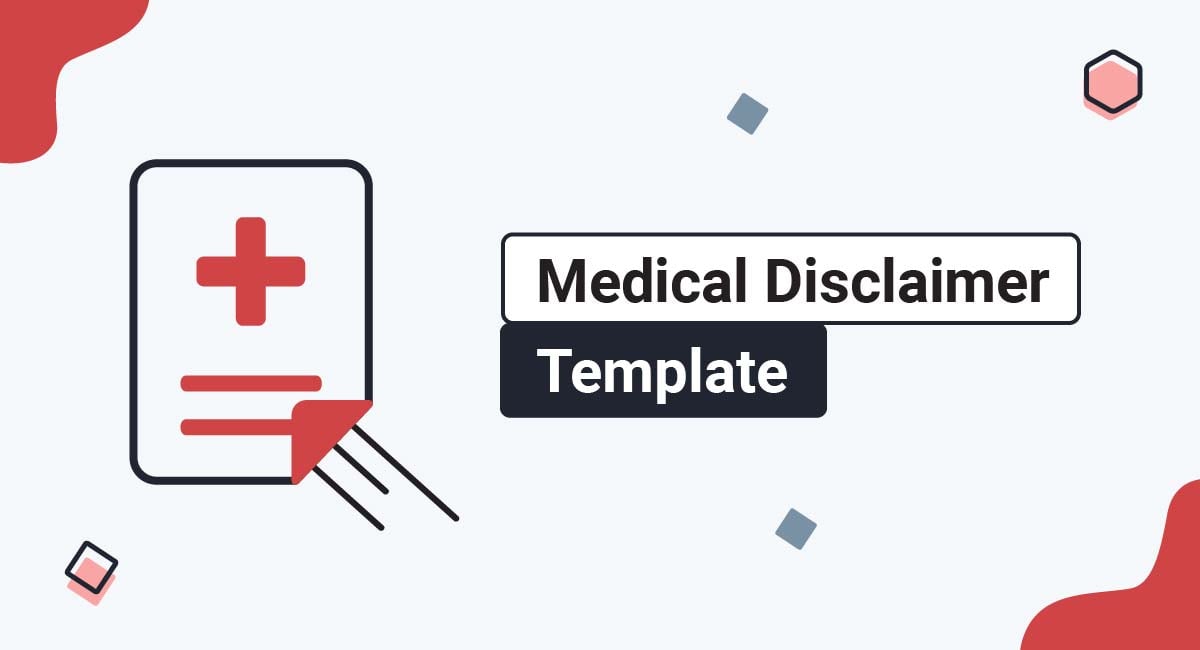
Medical Disclaimer Template
If you are a medical, healthcare, or fitness-based business, including a medical disclaimer on your website is crucial. Doing so can help you reduce legal liability by clearly communicating the limitations and scope of your information or services. It can also offer important information to your users to help keep...
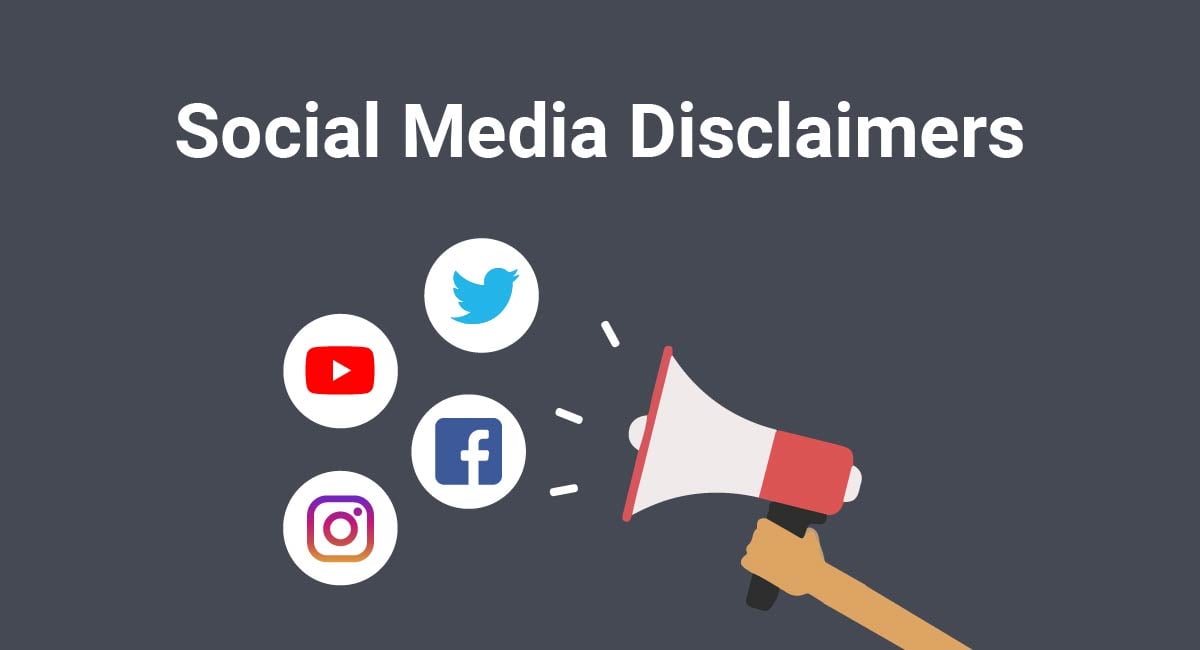
Social Media Disclaimers
Having a social media presence for your business is important for branding and marketing, as well as connecting with potential and existing customers or clients. Maintaining business social media accounts comes with a lot of perks, but it can also come with some risks. Users may post defamatory comments or dangerous...
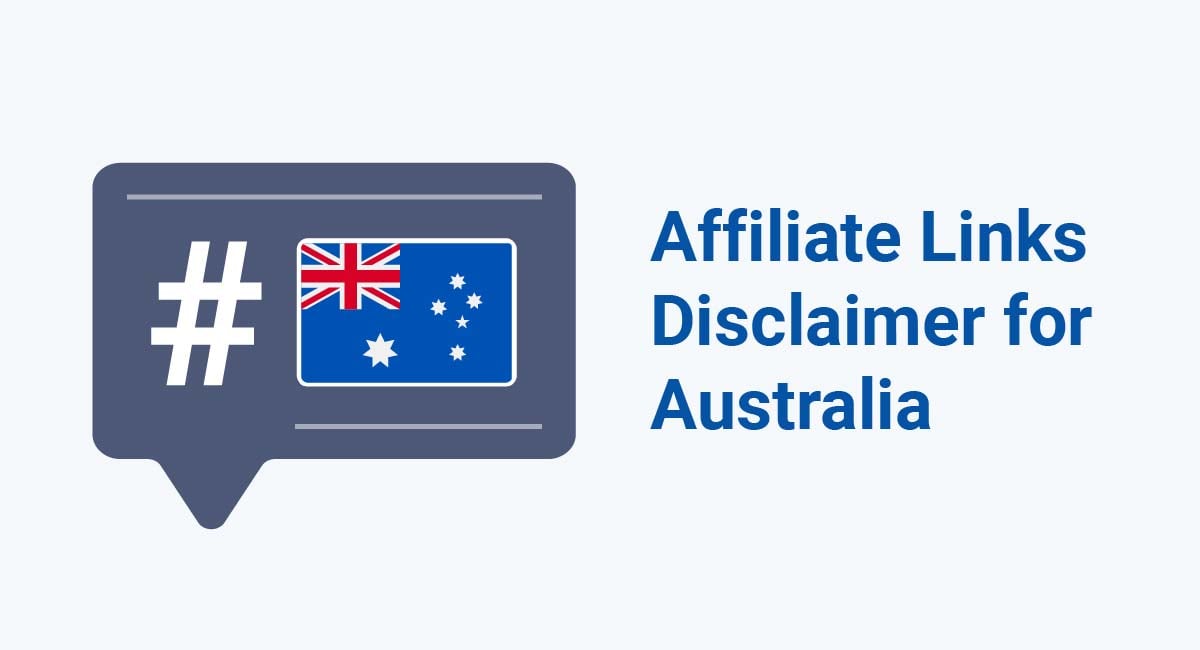
Affiliate Links Disclaimer for Australia
On February 1, 2021, the Australian Association of National Advertisers (AANA)'s disclosure guidelines went into effect. These influencer marketing guidelines govern influencers, bloggers, and other marketers who do business in Australia. This article will discuss Australian disclosure guidelines and what affiliate marketers who do business in Australia should do to ensure...
Masters Compare - Find your perfect masters course.

- Studying a Postgraduate degree
Using a questionnaire survey for your dissertation
Share this article.
- Facebook Sharer
- Twitter Sharer
- LinkedIn Sharer

Explore other topics
- Funding a Postgraduate course
- Living as a Postgraduate student
- Popular masters degree subjects
- Student Wellbeing
- Finding a PhD or Masters Course
Think Postgrad
Find out how to use a dissertation questionnaire for your masters.
Prof Martyn Denscombe, author of " The Good Research Guide, 6th edition ", gives expert advice on using a questionnaire survey for your postgraduate dissertation.
Questionnaire surveys are a well-established way of collecting data. They work with relatively small-scale research projects so design and deliver research questionnaires quickly and cheaply. When it comes to conducting research for a master’s dissertation, questionnaire surveys feature prominently as the method of choice.
Using the post for bulky and lengthy surveys is normal. Sometimes questionnaires go by hand. The popularity of questionnaire surveys is principally due to the benefits of using online web-based questionnaires. There are two main aspects to this.
Designing questionnaires
First, the software for producing and delivering web questionnaires. Simple to use features such as drop-down menus and tick-box answers, is user-friendly and inexpensive.
Second, online surveys make it possible to contact people across the globe without travelling anywhere. Given the time and resource constraints faced when producing a dissertation, makes online surveys all the more enticing. Social media such as Facebook, Instagram and WhatsApp is great for contacting people to participate in the survey.
In the context of a master’s dissertation, however, the quality of the survey data is a vital issue. The grade for the dissertation will depend on being able to defend the use of the data from the survey. This is the basis for advanced, master’s level academic enquiry.
Pro's and con's
It is not good enough to simply rely on getting 100 or so people to complete your questionnaire. Be aware of the pros and cons of questionnaire surveys. You need to justify the value of the data you have collected in the face of probing questions, such as:
- Who are the respondents and how they were selected?
- How representative are the respondents of the whole group being studied?
- What response rate was achieved by the survey?
- Are the questions suitable in relation to the topic and the particular respondents?
- What likelihood is there that respondents gave honest answers to the questions?
This is where The Good Research Guide, 6th edition becomes so valuable.
It identifies the key points that need to be addressed in order to conduct a competent questionnaire survey. It gets right to the heart of the matter, with plenty of practical guidance on how to deal with issues.
In a straightforward style, using plain language, this bestselling book covers a range of alternative strategies and methods for conducting small-scale social research projects and outlines some of the main ways in which the data can be analysed.
Read Prof Martyn Denscombe's advice on using a Case Study for your postgraduate dissertation.
- Advertisers
- Cookie Policy
- Terms and Conditions
Sorry! You need to sign up
Sign up to Postgraduate Studentships
Sign up to compare masters
Opportunity added!
Thanks for making your selection. Click below to view your list.
Course Added
Thanks for making your selection. Click below to view your comparisons.

Think Postgrad Ltd 2008-2024 Website By Parachute
.webp)
How to Write a Survey Introduction: Tips & Free Template

Do you know what the last step of composing an article is? Writing the introduction!
Many editors do this at the end because, by the time they get there, they know what the article is about, what it contains, and who exactly it’s for.
That’s precisely the kind of information you should put in an article introduction. And the same goes for surveys.
A survey introduction is a place where you can let respondents know who you are, why you want their responses, and what you will do with them. Adding an introduction to a survey is one of the best ways to boost your response rate .
In this article, I’ll guide you through how to write a good introduction that will make respondents more eager to answer your questions. I’ll give you a survey introduction example and a template ready to fill out as well. Let’s begin.
What Is a Survey Introduction?
A survey introduction is a short text that outlines what a survey respondent can expect from the people/company running the survey. A survey introduction is also known as a survey disclaimer.
A good survey introduction teaches the respondents everything they need to know about your company and why you’re looking to gather information. It acts as a guiding reference and will put you at the front of all other companies looking to gain customer feedback .
No matter the content, each survey should begin with a survey introduction. You have spent your time creating a survey and now, you need answers. Having the right survey introduction will set you on track to catch your customers at ‘hello.’
For a more academic take on the subject, you might also like a breakdown by Dartmouth College of what a survey introduction should look like.
You should aim to add an introduction to each survey type you run, whether it's the universal and globally recognized Net Promoter Score (see the template below) or a customized survey created to suit your individual needs.
How to Introduce a Survey
The following five pieces of information are great places to start when writing a survey introduction. If you are unsure how to welcome your respondents, simply answer these five questions.
#1. Who are you?
If you’re running a survey outside your web page or social media, remember that your respondents might not know who you are.
Even if it’s quick, make sure you give your target audience an introduction to yourself and your company.
#2. Why are you asking for input?
Let’s face it, we’ve all filled out surveys and wondered if anyone was going to look at them. Make sure your respondents feel like their input is valued.
Explain why you collect data on this topic and why your respondents should care.
It probably isn’t a good enough reason that the survey will satisfy your curiosity. It needs to really have an impact on your company’s products and services.
#3. How will you use the gathered data?
It’s one thing to tell your potential respondents why you need to know this information but another thing to tell them how their personal information and insights will be handled.
Highlighting that your goal is not to gather responses for responses’ sake, but to take them into consideration and improve your product or service .
You may also want to mention your privacy policy. In the day and age of data leaks and the illegal use and purchase of data, keep in mind that you should be compliant with GDPR and other local policies.
Always use your clients’ information responsibly. You’ll benefit from the insights they give you and they can receive a better quality of products and services.
#4. How long will it take to complete the survey?
Have you ever started a survey, couldn’t see how long it would take to finish, got 20 questions in, and clicked out of it?
This is pretty common. If you don’t know how long a survey will take, it’s hard to commit to it. Taking an hour-long survey isn’t that rewarding for a client unless they’re invested in the outcome.
Tell your clients how long the survey will take , how many and what type of questions they can expect, and the average length of time it takes to complete. Remember, 10 closed-ended survey questions versus open-ended questions can take quite a different amount of time.
Adding a progress bar is another similar tactic that can help fight survey fatigue .
#5. Any other insights?
Conclude your intro with something that makes the respondents remember you are important.
Don’t forget to say goodbye and thank you as well! Make your respondents see that you’re reflecting on their insights and will include them in your future interactions.
.webp)
Survey Introduction Example
Still wondering what your survey introduction might look like? Here’s a survey introduction sample. It helps to introduce clients to the company, explain the goal of the survey, and get your customers on board.
We’re [your company name] and we just launched a survey to find out how you feel about [your survey topic].
Once you submit your responses, we’ll make sure the data reaches the right teams. Our goal is to [improve our product/service, smooth out struggles, find out more about you, etc].
We are fully GDPR-compliant and will not share your sensitive data with anyone else.
There are [number of questions] [open-ended, closed-ended] questions in this survey and it shouldn’t take you more than [number of minutes] minutes to complete the survey .
There’s also room for your insights at the end if you’d like to let us know about anything not covered by the questions. We can even reach out to you and let you know when your issue issolved.
We greatly appreciate the time you take to let us know how we can do better!
If you are having trouble getting inspired, use this survey introduction template . You can send it within the email where you invite potential participants to complete a survey such as the one below:
Or, some survey tools allow you to embed the introduction right inside the survey.
How to Add an Introduction to Your Survicate Surveys
If you are using a good customer feedback tool like Survicate , you don’t have to worry about including introductions in emails, pop-ups , or anywhere outside of the platform itself.
Once you begin making a survey, you can add an introduction with a single click.

Click “welcome message” at any point during your survey creation and simply type it in. You can even add a separate introduction for each question.

And don’t forget to include a thank-you screen as well!
.webp)
Automate your surveys with Survicate
A good survey starts with a solid and clear introduction. Get your consumers at hello with a survey introduction that tells them exactly what’s coming.
- Who are you?
- Why are they taking this survey?
- How long will it take them?
- How will you protect their privacy?
These are all crucial questions and answering them all can improve your response rate in no time.
Stay ahead of your competition and begin crafting your survey introduction!

We’re also there

How to make a GDPR compliant survey
- Written October 15, 2021
- by Stefan Debois
The GDPR data protection law came into effect in the EU on May 25, 2018. While the law itself is quite complicated, complying doesn’t have to be as hard.
When you’re using Pointerpro, you’re collecting and processing data. If that data can be used to identify an individual, it’s wise to make a few small updates in your questionnaires. Learn more about whether or not that data falls under the GDPR here.
In this blog post, we’ll explain what you can do to make your surveys and quizzes GDPR-proof and protect your respondents’ data.
Remember that this article is meant to be seen as a resource and not as legal advice. We encourage you to search for legal advice on how to comply with GDPR and determine what effect it has on your organization.
Considerations to make before you create your survey
First, when creating (or updating) your surveys to comply with GDPR, it’s wise to consider what you’ll be using the data for.
Is it an entirely anonymous survey?
Ensure that even a combination of the information you collect cannot help you identify a person.
For example, if you’re asking the employees of a specific department in your office to take an anonymous survey where you ask them what age range they’re in and what gender they are… That’s entirely fine!
BUT if in that specific department there’s only one woman in the age range between 31 and 40, then the data can be used to identify that person, and the GDPR applies.
Is the data you collect for internal use only?
Check whether or not the data you collect will be used internally and in what departments it can be accessed.
For example, if you collect email addresses on an event and those addresses will be added to a CRM where your sales team can access them for further follow-up, you’ll have to communicate this upfront.
Another example is that GDPR also applies to employees. Even if you create a survey that collects data from the people you already know, consider who will have access to the information. A colleague’s home address cannot be shared with another colleague who wishes to send a birthday card unless that colleague has given consent for that address to be shared.
Will the data only be saved on your Pointerpro account?
Or do you plan on transferring it to other apps as well? Any third-party processor you use is directly and legally obligated to also be in compliance . It’s wise to check if they do before transferring any more collected data.
What will you do with the data?
Before launching your survey it’s more important than ever to list what you plan on doing with it. Each different aspect should be mentioned in your privacy policy and should be attached to your survey.
Moreover, specific actions such as marketing communication or a sales follow up require specific consent from the respondent, aside from being mentioned in the privacy policy.
Is the first checklist done? Then it’s time to get down to business…
4 Quick Things You Can Include to Comply With the GDPR
1. add a short introduction on the intro screen of your survey. .
Simply inform your respondents about what you’ll be using the survey for (like you did before) and specifically state what will be done with the collected personal data.
For example:
2. Link to a privacy statement with all necessary information.
The essentials of what you should include in your privacy statement are listed later on in this blog post. There are two ways you can include your privacy statement in your survey.
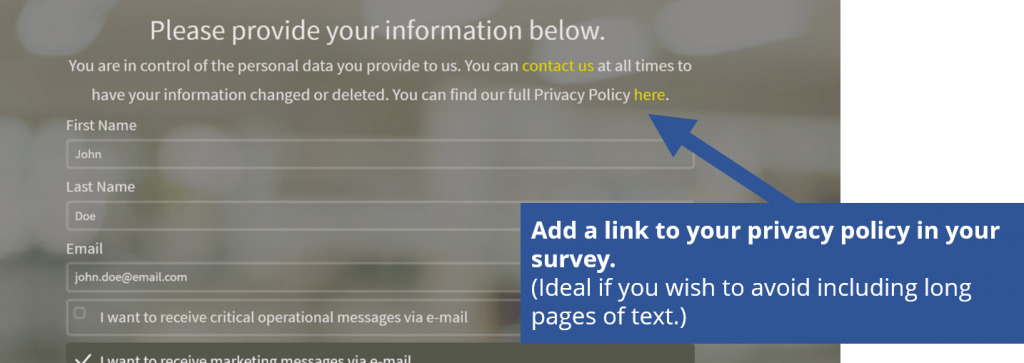
3. Add active opt-ins near your form fields
Make sure that you add your opt-ins the right way. Keep in mind that consent requests need to meet these requirements:
- Unbundled : Consent requests should be separate from other terms and conditions and they cannot be a precondition of signing up to a service unless necessary for that service.
- Active opt-in : Pre-ticked opt-in boxes are invalid. Luckily the tool only offers unticked opt-in boxes. Another option is to use similarly active opt-in methods. For example: A binary choice where both options are given equal prominence.
- Granular : Give granular options to consent separately for different types of processing wherever appropriate. For example: A separate opt-in for a subscription to the newsletter and a subscription to updates of partner companies.
- Named : Name your organization and any third parties who will be relying on consent. Even precisely defined categories of third-party organizations aren’t sufficient under the GDPR.
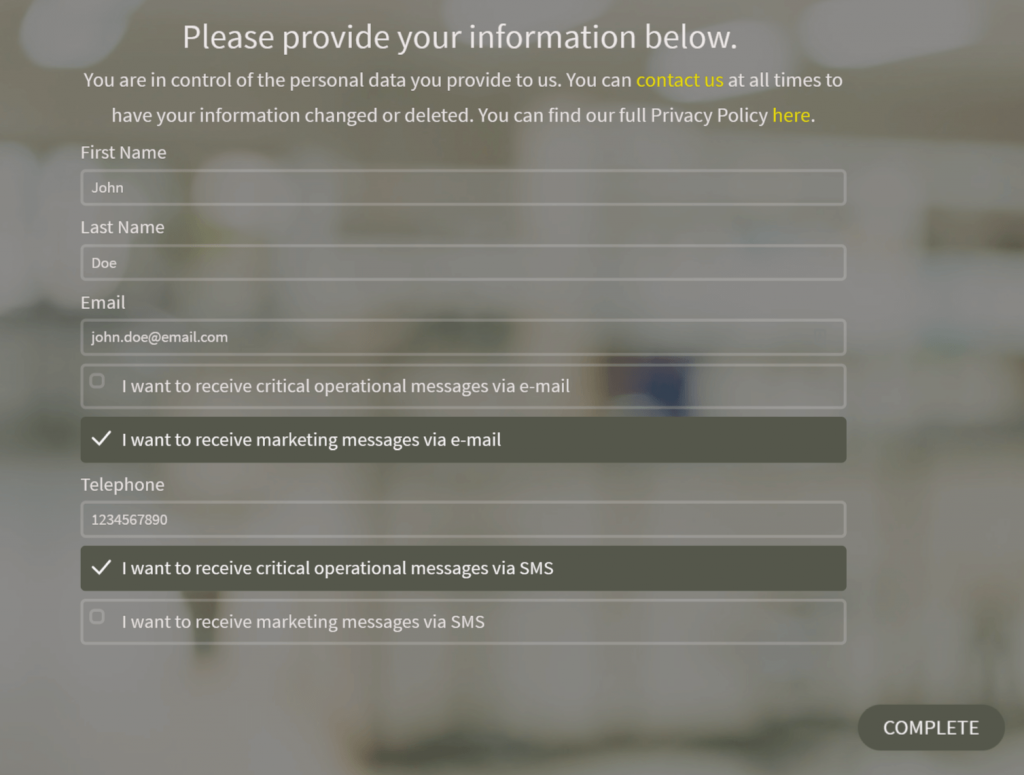
4. Provide additional information on why you need specific information
For example, if you’re asking for a date of birth. You could add something along these lines: Your date of birth helps us provide you with special promotions and purchase benefits during your birthday month.
These small changes can make a very big difference! An essential additional to-do is updating your privacy policy.
While this article is in no way legal advice, the items mentioned below make a great guideline to cover your basics.
What to Include in a GDPR-Proof Privacy Policy:
Basic information about:.
- Who you are;
- What you are going to do with your respondents’ data;
- Who this collected data will be shared with.
Insights in and proof of how personal data will be used in a fair way:
Explain how the data obtained will be used in a way that people reasonably expect.
- Show awareness of the impact and ramifications of the processing of that personal data.
- Be transparent and ensure that people know how their data is used.
Showing fairness in your privacy policy is the key to establishing trust, which is needed for consent! So be as straightforward as possible about what data you have, why you will be using it and how long you plan on holding on to it.
Answers to the following questions:
What kind of data do you collect from customers, in minute detail?
- Do you have good reason to collect this data? Why do you need it?
- How was the data obtained, exactly? Did users consent to the collection of their information?
- How long will you retain it?
- How secure is the data in your possession?
- Do you ever share the personal information of users with third parties? Do you have good reason to do so?
Clear overview of user rights:
Under the GDPR, user rights are clearly defined. Make sure respondents know they have the right to:
- Access, view and edit their own information in a timely manner. In the case of Pointerpro, this means that they can request the data that was collected while they took a survey or quiz . You can easily provide this information by downloading the responses of that specific individual in a PDF report .
- Be erased from your records upon request, unless you have a legal reason to hold their information. In the case of Pointerpro, this means you can offer respondents to be “anonymized”, deleting the data that can help identify them but keeping the other responses intact. OR you can offer respondents to be deleted along with all of their responses.
- Access to clear instructions on how to object to or opt-out of marketing messages and/or targeted advertising from your business.
What will happen in the case of a data breach:
If this happens, a couple of actions must take place:
- The data breach must be detected and reported to the appropriate authorities within 72 hours.
- If the security of user data is put at risk, then the affected or potentially affected users must be informed within 72 hours as well.
The list of essentials to add to your privacy policy was taken from this excellent source.
Tips for complying with the GDPR
There are tons of great examples of adaptations made to comply with the GDPR. Many of those can inspire to create better, stronger survey experiences as well.
Here are some of our favorites!
1. Clarify why people are receiving certain information
Focus on highlighting the added value of being subscribed. Found via Optinmonster .
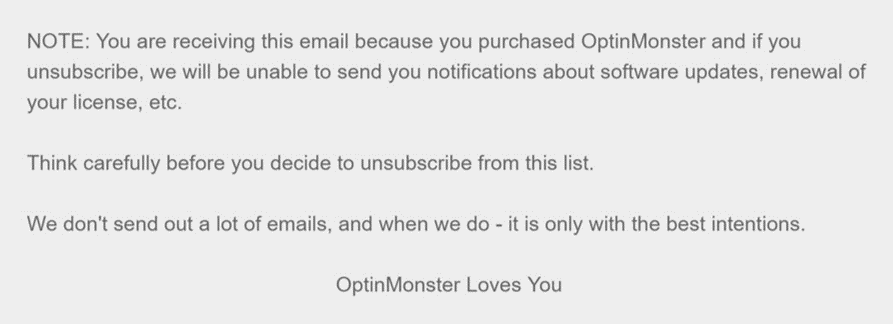
2. Just-in-time privacy notices
Just-in-time privacy notices that give short, understandable snippets of information at the moment you need it. Found via econsultancy.com .
3. Use “human” language in your privacy policy
In this case, it makes it almost fun to read and it’s clear and relatable for all audiences. Read the entire thing at TurnkeyLinux.org .

4. Add a “plain English” version
There’s a simple explanation next to each “serious” aspect of the privacy policy. Great approach, found via Codepen.io .
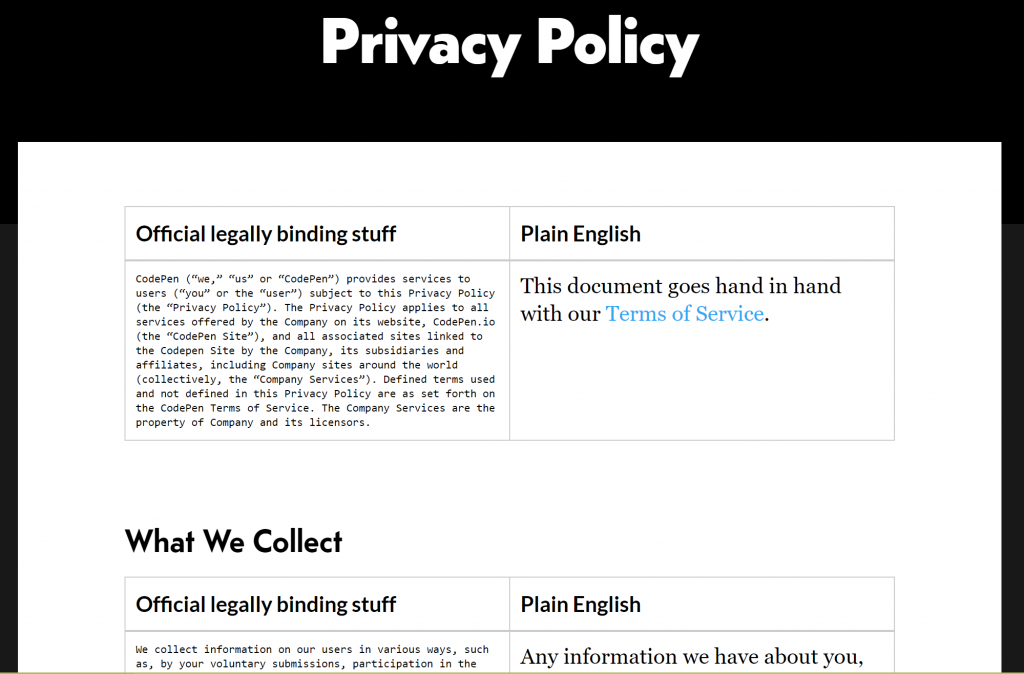
What’s next?
- Read the GDPR (General Data Protection Regulations) basics : The most important GDPR principles, Data Controlling, Data Processing, but also what consequences can you face for not being GDPR compliant.
- Discover what updates were made in the Pointerpro tool to make the software and your questionnaires GDPR proof: Data collection features: IP address & user agent are default on “nocollect”, Automatically add an “unsubscribe” link in your email invitations, Anonymising responses and more.
Create your own assessment for free!
About the author:.

Stefan Debois
3 responses.
Hi Stefan Thanks For Share wonderful information for GDPR very informative
The European Union’s General Data Protection Regulation (GDPR) came into effect in May 2018. The motive behind introducing such a regulation was to provide data subjects with more control over their personal data. data protection policy template
Thanks very much for the advice and information
Recommended reading
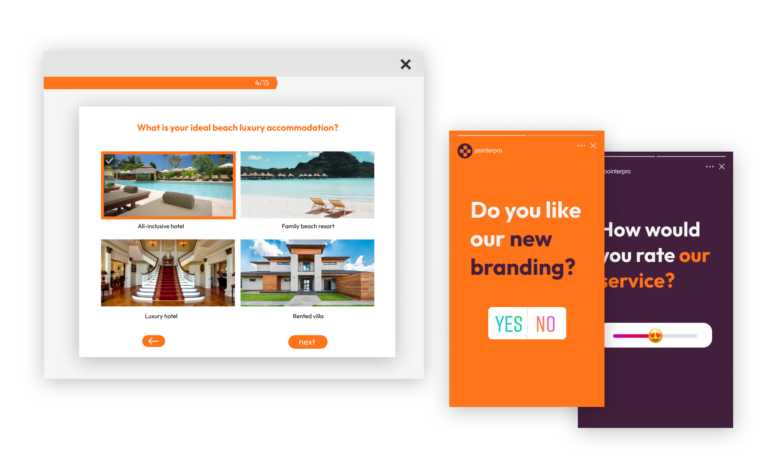
How to create effective poll questions
Do you want to interact with your audience to learn more about them, but don’t want to inconvenience them with
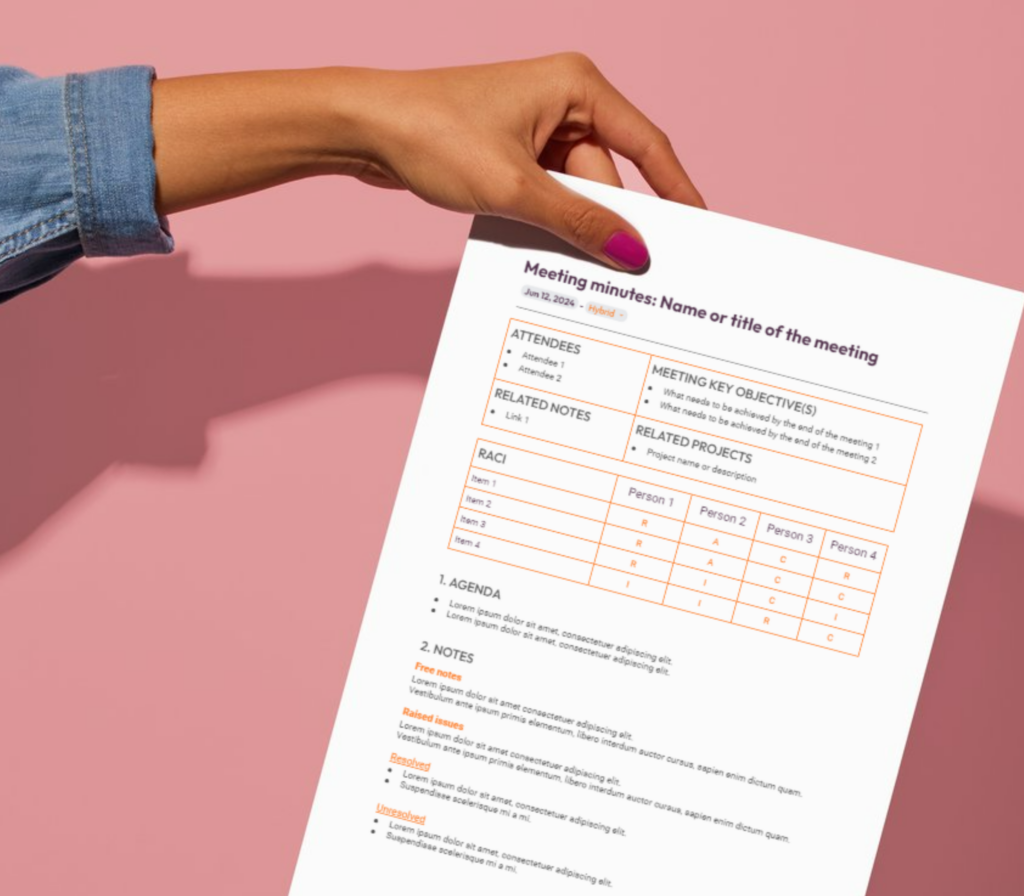
How to perfect and automate your own meeting minutes template
Not too long ago, my habit was to take meeting notes on paper. Until I started working for an IT

9 AI tools for consultants to get everyday tasks done faster and better
In this article we’ll walk you through 5 AI tools you can use in your consulting business.
Want to know more?
Subscribe to our newsletter and get hand-picked articles directly to your inbox.

The Pointerpro newsletter brings you the latest market trends and will give you an overview of compelling testimonials from our community. Register now!
Popular Articles
Get to know us.
Contact us Careers (We’re hiring!) Affiliate marketing
Help Center
Certifications.

ISO 27001 Certified
Careers (We’re hiring!)
Let’s stay in touch, we’d like that
Have a language expert improve your writing
Run a free plagiarism check in 10 minutes, automatically generate references for free.
- Knowledge Base
- Methodology
- Doing Survey Research | A Step-by-Step Guide & Examples
Doing Survey Research | A Step-by-Step Guide & Examples
Published on 6 May 2022 by Shona McCombes . Revised on 10 October 2022.
Survey research means collecting information about a group of people by asking them questions and analysing the results. To conduct an effective survey, follow these six steps:
- Determine who will participate in the survey
- Decide the type of survey (mail, online, or in-person)
- Design the survey questions and layout
- Distribute the survey
- Analyse the responses
- Write up the results
Surveys are a flexible method of data collection that can be used in many different types of research .
Table of contents
What are surveys used for, step 1: define the population and sample, step 2: decide on the type of survey, step 3: design the survey questions, step 4: distribute the survey and collect responses, step 5: analyse the survey results, step 6: write up the survey results, frequently asked questions about surveys.
Surveys are used as a method of gathering data in many different fields. They are a good choice when you want to find out about the characteristics, preferences, opinions, or beliefs of a group of people.
Common uses of survey research include:
- Social research: Investigating the experiences and characteristics of different social groups
- Market research: Finding out what customers think about products, services, and companies
- Health research: Collecting data from patients about symptoms and treatments
- Politics: Measuring public opinion about parties and policies
- Psychology: Researching personality traits, preferences, and behaviours
Surveys can be used in both cross-sectional studies , where you collect data just once, and longitudinal studies , where you survey the same sample several times over an extended period.
Prevent plagiarism, run a free check.
Before you start conducting survey research, you should already have a clear research question that defines what you want to find out. Based on this question, you need to determine exactly who you will target to participate in the survey.
Populations
The target population is the specific group of people that you want to find out about. This group can be very broad or relatively narrow. For example:
- The population of Brazil
- University students in the UK
- Second-generation immigrants in the Netherlands
- Customers of a specific company aged 18 to 24
- British transgender women over the age of 50
Your survey should aim to produce results that can be generalised to the whole population. That means you need to carefully define exactly who you want to draw conclusions about.
It’s rarely possible to survey the entire population of your research – it would be very difficult to get a response from every person in Brazil or every university student in the UK. Instead, you will usually survey a sample from the population.
The sample size depends on how big the population is. You can use an online sample calculator to work out how many responses you need.
There are many sampling methods that allow you to generalise to broad populations. In general, though, the sample should aim to be representative of the population as a whole. The larger and more representative your sample, the more valid your conclusions.
There are two main types of survey:
- A questionnaire , where a list of questions is distributed by post, online, or in person, and respondents fill it out themselves
- An interview , where the researcher asks a set of questions by phone or in person and records the responses
Which type you choose depends on the sample size and location, as well as the focus of the research.
Questionnaires
Sending out a paper survey by post is a common method of gathering demographic information (for example, in a government census of the population).
- You can easily access a large sample.
- You have some control over who is included in the sample (e.g., residents of a specific region).
- The response rate is often low.
Online surveys are a popular choice for students doing dissertation research , due to the low cost and flexibility of this method. There are many online tools available for constructing surveys, such as SurveyMonkey and Google Forms .
- You can quickly access a large sample without constraints on time or location.
- The data is easy to process and analyse.
- The anonymity and accessibility of online surveys mean you have less control over who responds.
If your research focuses on a specific location, you can distribute a written questionnaire to be completed by respondents on the spot. For example, you could approach the customers of a shopping centre or ask all students to complete a questionnaire at the end of a class.
- You can screen respondents to make sure only people in the target population are included in the sample.
- You can collect time- and location-specific data (e.g., the opinions of a shop’s weekday customers).
- The sample size will be smaller, so this method is less suitable for collecting data on broad populations.
Oral interviews are a useful method for smaller sample sizes. They allow you to gather more in-depth information on people’s opinions and preferences. You can conduct interviews by phone or in person.
- You have personal contact with respondents, so you know exactly who will be included in the sample in advance.
- You can clarify questions and ask for follow-up information when necessary.
- The lack of anonymity may cause respondents to answer less honestly, and there is more risk of researcher bias.
Like questionnaires, interviews can be used to collect quantitative data : the researcher records each response as a category or rating and statistically analyses the results. But they are more commonly used to collect qualitative data : the interviewees’ full responses are transcribed and analysed individually to gain a richer understanding of their opinions and feelings.
Next, you need to decide which questions you will ask and how you will ask them. It’s important to consider:
- The type of questions
- The content of the questions
- The phrasing of the questions
- The ordering and layout of the survey
Open-ended vs closed-ended questions
There are two main forms of survey questions: open-ended and closed-ended. Many surveys use a combination of both.
Closed-ended questions give the respondent a predetermined set of answers to choose from. A closed-ended question can include:
- A binary answer (e.g., yes/no or agree/disagree )
- A scale (e.g., a Likert scale with five points ranging from strongly agree to strongly disagree )
- A list of options with a single answer possible (e.g., age categories)
- A list of options with multiple answers possible (e.g., leisure interests)
Closed-ended questions are best for quantitative research . They provide you with numerical data that can be statistically analysed to find patterns, trends, and correlations .
Open-ended questions are best for qualitative research. This type of question has no predetermined answers to choose from. Instead, the respondent answers in their own words.
Open questions are most common in interviews, but you can also use them in questionnaires. They are often useful as follow-up questions to ask for more detailed explanations of responses to the closed questions.
The content of the survey questions
To ensure the validity and reliability of your results, you need to carefully consider each question in the survey. All questions should be narrowly focused with enough context for the respondent to answer accurately. Avoid questions that are not directly relevant to the survey’s purpose.
When constructing closed-ended questions, ensure that the options cover all possibilities. If you include a list of options that isn’t exhaustive, you can add an ‘other’ field.
Phrasing the survey questions
In terms of language, the survey questions should be as clear and precise as possible. Tailor the questions to your target population, keeping in mind their level of knowledge of the topic.
Use language that respondents will easily understand, and avoid words with vague or ambiguous meanings. Make sure your questions are phrased neutrally, with no bias towards one answer or another.
Ordering the survey questions
The questions should be arranged in a logical order. Start with easy, non-sensitive, closed-ended questions that will encourage the respondent to continue.
If the survey covers several different topics or themes, group together related questions. You can divide a questionnaire into sections to help respondents understand what is being asked in each part.
If a question refers back to or depends on the answer to a previous question, they should be placed directly next to one another.
Before you start, create a clear plan for where, when, how, and with whom you will conduct the survey. Determine in advance how many responses you require and how you will gain access to the sample.
When you are satisfied that you have created a strong research design suitable for answering your research questions, you can conduct the survey through your method of choice – by post, online, or in person.
There are many methods of analysing the results of your survey. First you have to process the data, usually with the help of a computer program to sort all the responses. You should also cleanse the data by removing incomplete or incorrectly completed responses.
If you asked open-ended questions, you will have to code the responses by assigning labels to each response and organising them into categories or themes. You can also use more qualitative methods, such as thematic analysis , which is especially suitable for analysing interviews.
Statistical analysis is usually conducted using programs like SPSS or Stata. The same set of survey data can be subject to many analyses.
Finally, when you have collected and analysed all the necessary data, you will write it up as part of your thesis, dissertation , or research paper .
In the methodology section, you describe exactly how you conducted the survey. You should explain the types of questions you used, the sampling method, when and where the survey took place, and the response rate. You can include the full questionnaire as an appendix and refer to it in the text if relevant.
Then introduce the analysis by describing how you prepared the data and the statistical methods you used to analyse it. In the results section, you summarise the key results from your analysis.
A Likert scale is a rating scale that quantitatively assesses opinions, attitudes, or behaviours. It is made up of four or more questions that measure a single attitude or trait when response scores are combined.
To use a Likert scale in a survey , you present participants with Likert-type questions or statements, and a continuum of items, usually with five or seven possible responses, to capture their degree of agreement.
Individual Likert-type questions are generally considered ordinal data , because the items have clear rank order, but don’t have an even distribution.
Overall Likert scale scores are sometimes treated as interval data. These scores are considered to have directionality and even spacing between them.
The type of data determines what statistical tests you should use to analyse your data.
A questionnaire is a data collection tool or instrument, while a survey is an overarching research method that involves collecting and analysing data from people using questionnaires.
Cite this Scribbr article
If you want to cite this source, you can copy and paste the citation or click the ‘Cite this Scribbr article’ button to automatically add the citation to our free Reference Generator.
McCombes, S. (2022, October 10). Doing Survey Research | A Step-by-Step Guide & Examples. Scribbr. Retrieved 10 July 2024, from https://www.scribbr.co.uk/research-methods/surveys/

Is this article helpful?
Shona McCombes
Other students also liked, qualitative vs quantitative research | examples & methods, construct validity | definition, types, & examples, what is a likert scale | guide & examples.
- Utility Menu
Harvard University Program on Survey Research
- Questionnaire Design Tip Sheet
This PSR Tip Sheet provides some basic tips about how to write good survey questions and design a good survey questionnaire.
| 40 KB |
PSR Resources
- Managing and Manipulating Survey Data: A Beginners Guide
- Finding and Hiring Survey Contractors
- How to Frame and Explain the Survey Data Used in a Thesis
- Overview of Cognitive Testing and Questionnaire Evaluation
- Sampling, Coverage, and Nonresponse Tip Sheet
- Introduction to Surveys for Honors Thesis Writers
- PSR Introduction to the Survey Process
- Related Centers/Programs at Harvard
- General Survey Reference
- Institutional Review Boards
- Select Funding Opportunities
- Survey Analysis Software
- Professional Standards
- Professional Organizations
- Major Public Polls
- Survey Data Collections
- Major Longitudinal Surveys
- Other Links
Dissertation surveys: Questions, examples, and best practices
Collect data for your dissertation with little effort and great results.
Dissertation surveys are one of the most powerful tools to get valuable insights and data for the culmination of your research. However, it’s one of the most stressful and time-consuming tasks you need to do. You want useful data from a representative sample that you can analyze and present as part of your dissertation. At SurveyPlanet, we’re committed to making it as easy and stress-free as possible to get the most out of your study.
With an intuitive and user-friendly design, our templates and premade questions can be your allies while creating a survey for your dissertation. Explore all the options we offer by simply signing up for an account—and leave the stress behind.
How to write dissertation survey questions
The first thing to do is to figure out which group of people is relevant for your study. When you know that, you’ll also be able to adjust the survey and write questions that will get the best results.
The next step is to write down the goal of your research and define it properly. Online surveys are one of the best and most inexpensive ways to reach respondents and achieve your goal.
Before writing any questions, think about how you’ll analyze the results. You don’t want to write and distribute a survey without keeping how to report your findings in mind. When your thesis questionnaire is out in the real world, it’s too late to conclude that the data you’re collecting might not be any good for assessment. Because of that, you need to create questions with analysis in mind.
You may find our five survey analysis tips for better insights helpful. We recommend reading it before analyzing your results.
Once you understand the parameters of your representative sample, goals, and analysis methodology, then it’s time to think about distribution. Survey distribution may feel like a headache, but you’ll find that many people will gladly participate.
Find communities where your targeted group hangs out and share the link to your survey with them. If you’re not sure how large your research sample should be, gauge it easily with the survey sample size calculator.
Need help with writing survey questions? Read our guide on well-written examples of good survey questions .
Dissertation survey examples
Whatever field you’re studying, we’re sure the following questions will prove useful when crafting your own.
At the beginning of every questionnaire, inform respondents of your topic and provide a consent form. After that, start with questions like:
- Please select your gender:
- What is the highest educational level you’ve completed?
- High school
- Bachelor degree
- Master’s degree
- On a scale of 1-7, how satisfied are you with your current job?
- Please rate the following statements:
- I always wait for people to text me first.
- Strongly Disagree
- Neither agree nor disagree
- Strongly agree
- My friends always complain that I never invite them anywhere.
- I prefer spending time alone.
- Rank which personality traits are most important when choosing a partner. Rank 1 - 7, where 1 is the most and 7 is the least important.
- Flexibility
- Independence
- How openly do you share feelings with your partner?
- Almost never
- Almost always
- In the last two weeks, how often did you experience headaches?
Dissertation survey best practices
There are a lot of DOs and DON’Ts you should keep in mind when conducting any survey, especially for your dissertation. To get valuable data from your targeted sample, follow these best practices:
Use the consent form.
The consent form is a must when distributing a research questionnaire. A respondent has to know how you’ll use their answers and that the survey is anonymous.
Avoid leading and double-barreled questions
Leading and double-barreled questions will produce inconclusive results—and you don’t want that. A question such as: “Do you like to watch TV and play video games?” is double-barreled because it has two variables.
On the other hand, leading questions such as “On a scale from 1-10 how would you rate the amazing experience with our customer support?” influence respondents to answer in a certain way, which produces biased results.
Use easy and straightforward language and questions
Don’t use terms and professional jargon that respondents won’t understand. Take into consideration their educational level and demographic traits and use easy-to-understand language when writing questions.
Mix close-ended and open-ended questions
Too many open-ended questions will annoy respondents. Also, analyzing the responses is harder. Use more close-ended questions for the best results and only a few open-ended ones.
Strategically use different types of responses
Likert scale, multiple-choice, and ranking are all types of responses you can use to collect data. But some response types suit some questions better. Make sure to strategically fit questions with response types.
Ensure that data privacy is a priority
Make sure to use an online survey tool that has SSL encryption and secure data processing. You don’t want to risk all your hard work going to waste because of poorly managed data security. Ensure that you only collect data that’s relevant to your dissertation survey and leave out any questions (such as name) that can identify the respondents.
Create dissertation questionnaires with SurveyPlanet
Overall, survey methodology is a great way to find research participants for your research study. You have all the tools required for creating a survey for a dissertation with SurveyPlanet—you only need to sign up . With powerful features like question branching, custom formatting, multiple languages, image choice questions, and easy export you will find everything needed to create, distribute, and analyze a dissertation survey.
Happy data gathering!
Sign up now
Free unlimited surveys, questions and responses.
Postgraduate Studentships - Search for funding opportunities.

- Studying a Postgraduate degree
Using a questionnaire survey for your dissertation
Share this article.
- Facebook Sharer
- Twitter Sharer
- LinkedIn Sharer

Explore other topics
- Finding a Masters Course
- Funding a Postgraduate course
- Living as a Postgraduate student
- Popular masters degree subjects
- Student Wellbeing
Think Postgrad
Find out how to use a dissertation questionnaire for your masters.
Prof Martyn Denscombe, author of " The Good Research Guide, 6th edition ", gives expert advice on using a questionnaire survey for your postgraduate dissertation.
Questionnaire surveys are a well-established way of collecting data. They work with relatively small-scale research projects so design and deliver research questionnaires quickly and cheaply. When it comes to conducting research for a master’s dissertation, questionnaire surveys feature prominently as the method of choice.
Using the post for bulky and lengthy surveys is normal. Sometimes questionnaires go by hand. The popularity of questionnaire surveys is principally due to the benefits of using online web-based questionnaires. There are two main aspects to this.
Designing questionnaires
First, the software for producing and delivering web questionnaires. Simple to use features such as drop-down menus and tick-box answers, is user-friendly and inexpensive.
Second, online surveys make it possible to contact people across the globe without travelling anywhere. Given the time and resource constraints faced when producing a dissertation, makes online surveys all the more enticing. Social media such as Facebook, Instagram and WhatsApp is great for contacting people to participate in the survey.
In the context of a master’s dissertation, however, the quality of the survey data is a vital issue. The grade for the dissertation will depend on being able to defend the use of the data from the survey. This is the basis for advanced, master’s level academic enquiry.
Pro's and con's
It is not good enough to simply rely on getting 100 or so people to complete your questionnaire. Be aware of the pros and cons of questionnaire surveys. You need to justify the value of the data you have collected in the face of probing questions, such as:
- Who are the respondents and how they were selected?
- How representative are the respondents of the whole group being studied?
- What response rate was achieved by the survey?
- Are the questions suitable in relation to the topic and the particular respondents?
- What likelihood is there that respondents gave honest answers to the questions?
This is where The Good Research Guide, 6th edition becomes so valuable.
It identifies the key points that need to be addressed in order to conduct a competent questionnaire survey. It gets right to the heart of the matter, with plenty of practical guidance on how to deal with issues.
In a straightforward style, using plain language, this bestselling book covers a range of alternative strategies and methods for conducting small-scale social research projects and outlines some of the main ways in which the data can be analysed.
Read Prof Martyn Denscombe's advice on using a Case Study for your postgraduate dissertation.
- Advertisers
- Cookie Policy
- Terms and Conditions
Sorry! You need to sign up
Sign up to Postgraduate Studentships
Sign up to compare masters
Opportunity added!
Thanks for making your selection. Click below to view your list.
Course Added
Thanks for making your selection. Click below to view your comparisons.

Think Postgrad Ltd 2008-2024 Website By Parachute
- AI Survey Creation
- AI Survey Analysis
- Anonymous Surveys
- Conjoint Analysis
- Maxdiff Analysis
- Token Gated Surveys
- Social Media Verification
- White Label
- Repeat Question
- Market Research
- Mental Health
- Human Resources
- Web3 guides
- Survey Guides
- Case Studies
Quantitative Research
Qualitative research.
- Free plan, no time limit
- Set up in minutes
- No credit card required
7+ Reasons to Use Surveys in Your Dissertation

Writing a dissertation is a serious milestone. Your degree depends on it, so it takes a lot of effort and time to figure out what direction to choose. Everything starts with the topic: you read background literature, consult with your supervisor and seek approval before you start writing the first draft. After that, you need to decide how you will collect the data that is supposed to contribute to the research field.
This is where it gets complicated. If you have never tried conducting primary research (i.e. working with human subjects), it can seem quite scary. Analyzing articles may sound like the safest and the coolest option. Yet, there might not be enough information for you to claim that your research is somehow novel.
To make sure it is, you might need to conduct primary research, and the survey method is the most widespread tool to do that. The number of advantages surveys present is huge. However, there are various perks depending on what approach you pursue. So, let’s go through all of them before you decide to pay for essay and order a dissertation that will go on and on about analyzing literature and nothing else except it.
In the quantitative primary research, students have to calculate the data received from typical a, b, c, d questionnaires. The latter provides precise answers and helps prove or reject the formulated hypothesis. For the research to be legit, there are several stages to go through like:
- Discarding irrelevant or subjective questions/answers included in questionnaires.
- Setting criteria for credible answers.
- Composing an explanation of how you will manage ethical concerns (for participants and university committee).
However, all this is done to prevent issues in the future. Provided you have taken care of all the points above, you will get to enjoy the following benefits.
Data Collection Is Less Tedious
There are numerous services, like Survey Monkey, that the best write my essay services use. It can help you distribute your questionnaire among potential participants. These platforms simplify the data collection process. You don’t have to arrange calls or convince someone that they can safely share the information. Just upload the consent letter each participant has to sign and let the platform guide them further.
Data Analysis Is Fast
In quantitative analysis, all you have to take care of is mainly data entry. It requires focus and accuracy, but the rest can be done with the help of software. Whether it’s ordinary Excel or something like SPSS, you don’t have to reread loads of text. Just make sure you download the collected data from the platform correctly, remove irrelevant fields, and feed the rest to your computer.

Numbers Rule
Numbers don’t lie (unless you miscalculated them, of course). They give a clear answer: it’s either ‘yes’ or ‘no’. Moreover, they leave more room for creating good visuals and making your paper less boring. Just make sure you explain the numbers properly and compare the results between various graphs and charts.
No Room For Subjectivity
A quantitative dissertation is mostly a technical paper. It’s not about creativity and your ability to impress like in admission essays students usually delegate to admission essay writing services to avoid babbling about things they deem senseless. It’s about following particular procedures. And there is also a less abstract analysis.
Qualitative-oriented surveys are about conducting full-fledged personal interviews, working with focus groups, or distributing open-ended questionnaires requiring short but unique answers. Let’s talk about what makes this approach worth trying!

First-Hand Experience
The ability to gain a unique perspective is what distinguishes interviews from other surveys. Close-ended questions may be too rigid and make participants omit a lot of information that might help the research. In an interview, you may also correct some of your questions, and add more details to them, thus improving the outcomes.
More Diverse and Honest Answers
When participants are limited by only several options, they might choose something they cannot fully relate to. So, there is no guarantee that the results will be authentic. Meanwhile, with open-ended questions, participants share a lot of details.
Sure, some of them may be less relevant to your topic, but the researcher gains a deeper understanding of the issues lying beneath the topic. Of course, all of it is guaranteed only if the researcher provides anonymity and a safe space for the interviewees to share their thoughts freely.
No Need For Complex Software
In contrast to quantitative analysis, here, you won’t have to use formulae and learn how to perform complex tests. You might not even need Excel, except for storing some data about your participants. However, no calculations will be needed, which is also a relief for those who are not used to working with such kind of data.
Both types of research have also other advantages:
- With surveys, you have more chances to fill the literature gap you’ve discovered.
- Primary research may not be quite easy, but it’s highly valued at the doctoral level of education.
- You receive a lot of new information and stay away from retelling literature that has been published before.
- Primary research is less boring.
However, there is a must-remember thing: not every supervisor or university committee approves of surveys and primary research in general. It depends on numerous aspects like topic and subject, the conditions of research, your approach to handling human subjects, etc.
It means that the methodology you are going to use should be approved by your professor first. Otherwise, you may have to discard some parts of your draft and lose time gathering data you won’t be able to use. So, take care and good luck!
7+ Reasons to Use Surveys in Your Dissertation FAQ
What are the benefits of using surveys in a dissertation, surveys can provide a large amount of data in a short amount of time, they are cost-effective and can allow for anonymity, they can reach a wide audience, and they can be used to obtain feedback from the participants., how can i ensure that my survey results are accurate, make sure to ask questions that are clear and concise and that there are no bias in the questions. make sure to have a good sample size and to have a response rate that is high enough to provide accurate results., how can i analyze the survey results, depending on the type of survey, there are various analysis techniques that can be used. these include descriptive statistics, inferential statistics, correlation analysis, and regression analysis., what are the limitations of surveys, surveys can be subject to sampling errors, response bias, and interviewer effects. they may also not be able to capture the full range of opinions and attitudes of the population., like what you see share with a friend..

Sarath Shyamson
Sarath Shyamson is the customer success person at BlockSurvey and also heads the outreach. He enjoys volunteering for the church choir.
Related articles
Anounymous feedback: a how to guide.

A Beginner's Guide to Non-Profit Marketing: Learn the Tips, Best practices and 7 best Marketing Strategies for your NPO

4 Major Benefits of Incorporating Online Survey Tools Into the Classroom

7 best demographic questions to enhance the quality of your survey

Best Practices for Ensuring Customer Data Security in Feedback Platforms

Confidential survey vs Anonymous survey - How to decide on that

Conjoint analysis: Definition and How it can be used in your surveys

Cross-Tabulation Analysis: How to use it in your surveys?

What is Data Masking- Why it is essential to maintain the anonymity of a survey

The Art of Effective Survey Questions Design: Everything You Need to Know to Survey Students the Right Way

Focus group survey Vs Online survey: How to choose the best method for your Market Research

How Employee Satisfaction Affects Company's Financial Performance

How to create an anonymous survey

How to identify if the survey is anonymous or not

A Simple and Easy guide to understand: When and How to use Surveys in Psychology

How to write a survey introduction that motivates respondents to fill it out

Survey and Question Design: How to Make a Perfect Statistical Survey

Matrix Questions: Definition and How to use it in survey

Maxdiff analysis: Definition, Example and How to use it

How to Maximize Data Collection Efficiency with Web 3.0 Surveys?

10 Common Mistakes to Avoid When Designing Student Surveys

Empowering Prevention: Leveraging Online Surveys to Combat School Shootings
Optimizing Survey Results: Advanced Editing And Reporting Techniques

Enhancing Student Engagement and Learning with Online Surveys
Student survey questions that will provide valuable feedback

Preparing Students for the Future: The Role of Technology in Education
Top 10 Tricks to Boost Customer Satisfaction Survey Response Rates

When It’s Best To Use Surveys For A Dissertation & How To Ensure Anonymity?
Why Are Surveys Important for Financial Companies?

Want to create Anonymous survey in Facebook??- Know why you can't

Have a language expert improve your writing
Run a free plagiarism check in 10 minutes, generate accurate citations for free.
- Knowledge Base
- Dissertation
What Is a Dissertation? | Guide, Examples, & Template

A dissertation is a long-form piece of academic writing based on original research conducted by you. It is usually submitted as the final step in order to finish a PhD program.
Your dissertation is probably the longest piece of writing you’ve ever completed. It requires solid research, writing, and analysis skills, and it can be intimidating to know where to begin.
Your department likely has guidelines related to how your dissertation should be structured. When in doubt, consult with your supervisor.
You can also download our full dissertation template in the format of your choice below. The template includes a ready-made table of contents with notes on what to include in each chapter, easily adaptable to your department’s requirements.
Download Word template Download Google Docs template
- In the US, a dissertation generally refers to the collection of research you conducted to obtain a PhD.
- In other countries (such as the UK), a dissertation often refers to the research you conduct to obtain your bachelor’s or master’s degree.
Instantly correct all language mistakes in your text
Upload your document to correct all your mistakes in minutes

Table of contents
Dissertation committee and prospectus process, how to write and structure a dissertation, acknowledgements or preface, list of figures and tables, list of abbreviations, introduction, literature review, methodology, reference list, proofreading and editing, defending your dissertation, free checklist and lecture slides.
When you’ve finished your coursework, as well as any comprehensive exams or other requirements, you advance to “ABD” (All But Dissertation) status. This means you’ve completed everything except your dissertation.
Prior to starting to write, you must form your committee and write your prospectus or proposal . Your committee comprises your adviser and a few other faculty members. They can be from your own department, or, if your work is more interdisciplinary, from other departments. Your committee will guide you through the dissertation process, and ultimately decide whether you pass your dissertation defense and receive your PhD.
Your prospectus is a formal document presented to your committee, usually orally in a defense, outlining your research aims and objectives and showing why your topic is relevant . After passing your prospectus defense, you’re ready to start your research and writing.
Prevent plagiarism. Run a free check.
The structure of your dissertation depends on a variety of factors, such as your discipline, topic, and approach. Dissertations in the humanities are often structured more like a long essay , building an overall argument to support a central thesis , with chapters organized around different themes or case studies.
However, hard science and social science dissertations typically include a review of existing works, a methodology section, an analysis of your original research, and a presentation of your results , presented in different chapters.
Dissertation examples
We’ve compiled a list of dissertation examples to help you get started.
- Example dissertation #1: Heat, Wildfire and Energy Demand: An Examination of Residential Buildings and Community Equity (a dissertation by C. A. Antonopoulos about the impact of extreme heat and wildfire on residential buildings and occupant exposure risks).
- Example dissertation #2: Exploring Income Volatility and Financial Health Among Middle-Income Households (a dissertation by M. Addo about income volatility and declining economic security among middle-income households).
- Example dissertation #3: The Use of Mindfulness Meditation to Increase the Efficacy of Mirror Visual Feedback for Reducing Phantom Limb Pain in Amputees (a dissertation by N. S. Mills about the effect of mindfulness-based interventions on the relationship between mirror visual feedback and the pain level in amputees with phantom limb pain).
The very first page of your document contains your dissertation title, your name, department, institution, degree program, and submission date. Sometimes it also includes your student number, your supervisor’s name, and the university’s logo.
Read more about title pages
The acknowledgements section is usually optional and gives space for you to thank everyone who helped you in writing your dissertation. This might include your supervisors, participants in your research, and friends or family who supported you. In some cases, your acknowledgements are part of a preface.
Read more about acknowledgements Read more about prefaces
The abstract is a short summary of your dissertation, usually about 150 to 300 words long. Though this may seem very short, it’s one of the most important parts of your dissertation, because it introduces your work to your audience.
Your abstract should:
- State your main topic and the aims of your research
- Describe your methods
- Summarize your main results
- State your conclusions
Read more about abstracts
The table of contents lists all of your chapters, along with corresponding subheadings and page numbers. This gives your reader an overview of your structure and helps them easily navigate your document.
Remember to include all main parts of your dissertation in your table of contents, even the appendices. It’s easy to generate a table automatically in Word if you used heading styles. Generally speaking, you only include level 2 and level 3 headings, not every subheading you included in your finished work.
Read more about tables of contents
While not usually mandatory, it’s nice to include a list of figures and tables to help guide your reader if you have used a lot of these in your dissertation. It’s easy to generate one of these in Word using the Insert Caption feature.
Read more about lists of figures and tables
Similarly, if you have used a lot of abbreviations (especially industry-specific ones) in your dissertation, you can include them in an alphabetized list of abbreviations so that the reader can easily look up their meanings.
Read more about lists of abbreviations
In addition to the list of abbreviations, if you find yourself using a lot of highly specialized terms that you worry will not be familiar to your reader, consider including a glossary. Here, alphabetize the terms and include a brief description or definition.
Read more about glossaries
The introduction serves to set up your dissertation’s topic, purpose, and relevance. It tells the reader what to expect in the rest of your dissertation. The introduction should:
- Establish your research topic , giving the background information needed to contextualize your work
- Narrow down the focus and define the scope of your research
- Discuss the state of existing research on the topic, showing your work’s relevance to a broader problem or debate
- Clearly state your research questions and objectives
- Outline the flow of the rest of your work
Everything in the introduction should be clear, engaging, and relevant. By the end, the reader should understand the what, why, and how of your research.
Read more about introductions
A formative part of your research is your literature review . This helps you gain a thorough understanding of the academic work that already exists on your topic.
Literature reviews encompass:
- Finding relevant sources (e.g., books and journal articles)
- Assessing the credibility of your sources
- Critically analyzing and evaluating each source
- Drawing connections between them (e.g., themes, patterns, conflicts, or gaps) to strengthen your overall point
A literature review is not merely a summary of existing sources. Your literature review should have a coherent structure and argument that leads to a clear justification for your own research. It may aim to:
- Address a gap in the literature or build on existing knowledge
- Take a new theoretical or methodological approach to your topic
- Propose a solution to an unresolved problem or advance one side of a theoretical debate
Read more about literature reviews
Theoretical framework
Your literature review can often form the basis for your theoretical framework. Here, you define and analyze the key theories, concepts, and models that frame your research.
Read more about theoretical frameworks
Your methodology chapter describes how you conducted your research, allowing your reader to critically assess its credibility. Your methodology section should accurately report what you did, as well as convince your reader that this was the best way to answer your research question.
A methodology section should generally include:
- The overall research approach ( quantitative vs. qualitative ) and research methods (e.g., a longitudinal study )
- Your data collection methods (e.g., interviews or a controlled experiment )
- Details of where, when, and with whom the research took place
- Any tools and materials you used (e.g., computer programs, lab equipment)
- Your data analysis methods (e.g., statistical analysis , discourse analysis )
- An evaluation or justification of your methods
Read more about methodology sections
Your results section should highlight what your methodology discovered. You can structure this section around sub-questions, hypotheses , or themes, but avoid including any subjective or speculative interpretation here.
Your results section should:
- Concisely state each relevant result together with relevant descriptive statistics (e.g., mean , standard deviation ) and inferential statistics (e.g., test statistics , p values )
- Briefly state how the result relates to the question or whether the hypothesis was supported
- Report all results that are relevant to your research questions , including any that did not meet your expectations.
Additional data (including raw numbers, full questionnaires, or interview transcripts) can be included as an appendix. You can include tables and figures, but only if they help the reader better understand your results. Read more about results sections
Your discussion section is your opportunity to explore the meaning and implications of your results in relation to your research question. Here, interpret your results in detail, discussing whether they met your expectations and how well they fit with the framework that you built in earlier chapters. Refer back to relevant source material to show how your results fit within existing research in your field.
Some guiding questions include:
- What do your results mean?
- Why do your results matter?
- What limitations do the results have?
If any of the results were unexpected, offer explanations for why this might be. It’s a good idea to consider alternative interpretations of your data.
Read more about discussion sections
Your dissertation’s conclusion should concisely answer your main research question, leaving your reader with a clear understanding of your central argument and emphasizing what your research has contributed to the field.
In some disciplines, the conclusion is just a short section preceding the discussion section, but in other contexts, it is the final chapter of your work. Here, you wrap up your dissertation with a final reflection on what you found, with recommendations for future research and concluding remarks.
It’s important to leave the reader with a clear impression of why your research matters. What have you added to what was already known? Why is your research necessary for the future of your field?
Read more about conclusions
It is crucial to include a reference list or list of works cited with the full details of all the sources that you used, in order to avoid plagiarism. Be sure to choose one citation style and follow it consistently throughout your dissertation. Each style has strict and specific formatting requirements.
Common styles include MLA , Chicago , and APA , but which style you use is often set by your department or your field.
Create APA citations Create MLA citations
Your dissertation should contain only essential information that directly contributes to answering your research question. Documents such as interview transcripts or survey questions can be added as appendices, rather than adding them to the main body.
Read more about appendices
Making sure that all of your sections are in the right place is only the first step to a well-written dissertation. Don’t forget to leave plenty of time for editing and proofreading, as grammar mistakes and sloppy spelling errors can really negatively impact your work.
Dissertations can take up to five years to write, so you will definitely want to make sure that everything is perfect before submitting. You may want to consider using a professional dissertation editing service , AI proofreader or grammar checker to make sure your final project is perfect prior to submitting.
After your written dissertation is approved, your committee will schedule a defense. Similarly to defending your prospectus, dissertation defenses are oral presentations of your work. You’ll present your dissertation, and your committee will ask you questions. Many departments allow family members, friends, and other people who are interested to join as well.
After your defense, your committee will meet, and then inform you whether you have passed. Keep in mind that defenses are usually just a formality; most committees will have resolved any serious issues with your work with you far prior to your defense, giving you ample time to fix any problems.
As you write your dissertation, you can use this simple checklist to make sure you’ve included all the essentials.
Checklist: Dissertation
My title page includes all information required by my university.
I have included acknowledgements thanking those who helped me.
My abstract provides a concise summary of the dissertation, giving the reader a clear idea of my key results or arguments.
I have created a table of contents to help the reader navigate my dissertation. It includes all chapter titles, but excludes the title page, acknowledgements, and abstract.
My introduction leads into my topic in an engaging way and shows the relevance of my research.
My introduction clearly defines the focus of my research, stating my research questions and research objectives .
My introduction includes an overview of the dissertation’s structure (reading guide).
I have conducted a literature review in which I (1) critically engage with sources, evaluating the strengths and weaknesses of existing research, (2) discuss patterns, themes, and debates in the literature, and (3) address a gap or show how my research contributes to existing research.
I have clearly outlined the theoretical framework of my research, explaining the theories and models that support my approach.
I have thoroughly described my methodology , explaining how I collected data and analyzed data.
I have concisely and objectively reported all relevant results .
I have (1) evaluated and interpreted the meaning of the results and (2) acknowledged any important limitations of the results in my discussion .
I have clearly stated the answer to my main research question in the conclusion .
I have clearly explained the implications of my conclusion, emphasizing what new insight my research has contributed.
I have provided relevant recommendations for further research or practice.
If relevant, I have included appendices with supplemental information.
I have included an in-text citation every time I use words, ideas, or information from a source.
I have listed every source in a reference list at the end of my dissertation.
I have consistently followed the rules of my chosen citation style .
I have followed all formatting guidelines provided by my university.
Congratulations!
The end is in sight—your dissertation is nearly ready to submit! Make sure it's perfectly polished with the help of a Scribbr editor.
If you’re an educator, feel free to download and adapt these slides to teach your students about structuring a dissertation.
Open Google Slides Download PowerPoint
Is this article helpful?
Other students also liked.
- How to Write a Literature Review | Guide, Examples, & Templates
- Dissertation Table of Contents in Word | Instructions & Examples
- How to Choose a Dissertation Topic | 8 Steps to Follow
More interesting articles
- Checklist: Writing a dissertation
- Dissertation & Thesis Outline | Example & Free Templates
- Dissertation Binding and Printing | Options, Tips, & Comparison
- Example of a dissertation abstract
- Figure and Table Lists | Word Instructions, Template & Examples
- How to Write a Discussion Section | Tips & Examples
- How to Write a Dissertation or Thesis Proposal
- How to Write a Results Section | Tips & Examples
- How to Write a Thesis or Dissertation Conclusion
- How to Write a Thesis or Dissertation Introduction
- How to Write an Abstract | Steps & Examples
- How to Write Recommendations in Research | Examples & Tips
- List of Abbreviations | Example, Template & Best Practices
- Operationalization | A Guide with Examples, Pros & Cons
- Prize-Winning Thesis and Dissertation Examples
- Purpose and structure of an advisory report
- Relevance of Your Dissertation Topic | Criteria & Tips
- Research Paper Appendix | Example & Templates
- Shorten your abstract or summary
- Theoretical Framework Example for a Thesis or Dissertation
- Thesis & Dissertation Acknowledgements | Tips & Examples
- Thesis & Dissertation Database Examples
- Thesis & Dissertation Title Page | Free Templates & Examples
- What is a Dissertation Preface? | Definition & Examples
- What is a Glossary? | Definition, Templates, & Examples
- What Is a Research Methodology? | Steps & Tips
- What Is a Theoretical Framework? | Guide to Organizing
- What Is a Thesis? | Ultimate Guide & Examples
"I thought AI Proofreading was useless but.."
I've been using Scribbr for years now and I know it's a service that won't disappoint. It does a good job spotting mistakes”
Disclaimer Examples

by Masha Komnenic CIPP/E, CIPM, CIPT, FIP
February 17, 2023
Posting disclaimers on your website or app can help your company protect itself against legal claims by addressing liabilities specific to your operations.
Although businesses, websites, and apps in all industries can benefit from the legal protection a disclaimer statement offers, they’re especially useful if your platform manages:
- Affiliate relationships
- Customer testimonials
- Legal advice
- Medical advice
- Financial advice
- Email newsletters
- Sponsored posts
- Entertainment
- Offensive content/material
In this guide, we’ve put together the most common disclaimer statement examples and explain how they benefit your business.
If you’re ready to download and customize a disclaimer, check out our disclaimer template or let us do the work for you with our free disclaimer generator .
What Is a Disclaimer Statement?
When do you need a disclaimer, benefits of disclaimers, how to write a disclaimer, disclaimer faqs.
A disclaimer statement lets your website or app users know that you’ve limited what you can be held responsible for in certain situations they should be aware of.
Even though disclaimer statements do not necessarily prevent users from taking legal action against you, it’s an easy and inexpensive way to limit what your company can and can’t be held liable for in a court of law.
If there are any inaccuracies, vague statements, or misleading content on your website or app, even unintentionally, a disclaimer statement may help deflect or limit your legal responsibilities.
Some disclaimers appear as independent, stand-alone pages on your site. Other times they can be found as clauses within other legal agreements, including your:
- Terms and Conditions
- Privacy Policy
- Cookie Policy
- Acceptable Use Policy
If you own a business that operates online in any capacity, it’s in your best interest to have a disclaimer. This includes if you:
- Own an ecommerce shop
- Post legal information on your website
- Talk about medical issues or give medical advice
- Own and want to maintain your intellectual property rights
- Make content that is considered commentary, criticism, or parody
- Own a platform that allows your users to interact with one another
- Allow your users to post and share content on your website
All in all, there aren’t many websites that shouldn’t use a disclaimer. You might find any of the following types of disclaimers useful for your website or app:
- Fair use disclaimer
- Warranty disclaimer
- Copyright disclaimer
- No-responsibility disclaimer
- Affiliate disclaimer
- YouTube disclaimer
- Views expressed disclaimer
- Blog disclaimer
- Product disclaimer
- Testimonial disclaimer
- Social media disclaimer
- Intellectual property disclaimer
- Email disclaimer
- Medical disclaimer
The benefits of using disclaimers for your business are that they limit your liabilities, are more affordable than legal fees, and are easy to create and add to your website.
Let’s go over each of these benefits in a little more detail.
Disclaimers Limit Your Liabilities
Arguably the biggest benefit of using disclaimers on your website is that it can help limit what you’re held liable for in a court of law if a user ever pursues legal action against you.
While disclaimers can’t prevent someone from suing you or trying to take you to court, they act almost like a shield protecting your business from being held responsible for certain damages or harm users may experience while accessing your services.
Disclaimers May Help You Save Money
Another benefit of using disclaimers on your website is the cost — they’re usually cheap or free to add to your site, and they can help you save thousands of dollars in legal fees down the road.
In 2022, corporate law firms charged an average of $350 per hour, while lawyers specializing in intellectual property rights charged an average of $342 per hour. ( Statista )
You can save time and money by downloading and customizing disclaimer templates and adding them to your website or app.
Disclaimers Are Easy to Create
Even though legal disclaimers may seem intimidating at first, they’re usually very easy and fast to make and add to your website, especially if you use a template or generator.
All you need to do is customize the disclaimer to match the needs and details of your business.
Still trying to figure out where to start? We’re here to help. In the next section, we summarize some of the most common disclaimers relevant to your business, so take note of the ones you might need.
Below, we’ve put together a comprehensive guide explaining some of the most common disclaimers that you might need to protect your business, including:
Copyright Disclaimer
Fair use disclaimer, confidentiality disclaimer aka email disclaimer, warranty disclaimer, no-responsibility disclaimer, views expressed disclaimer, investment disclaimer, no guarantee disclaimer, medical disclaimer, affiliate disclaimer, youtube disclaimer.
- Social Media Disclaimer
Testimonial Disclaimer
You can use a copyright disclaimer to protect original content on your website or app against user theft, explain that you own your website/app and everything on it, and show that there are legal repercussions for using your work without permission.
Copyright is a form of protection offered by US law for “original works of authorship,” defined by the US Copyright Office as:
“…independently created by a human author and possesses at least some minimal degree of creativity.”
As soon as a work is created and becomes reproducible, copyright protection automatically applies to it. Some copyright examples include creative works that come in a tangible forms, like:
- Works of art
- Choreography
A detailed copyright disclaimer is not legally required, but it is a strong deterrent against copyright infringement by showing users that you know the law and will defend your claim.
Your business’s copyright claim can be detailed in your terms and conditions under an intellectual property rights clause, like how we do it in our agreement, shown below.
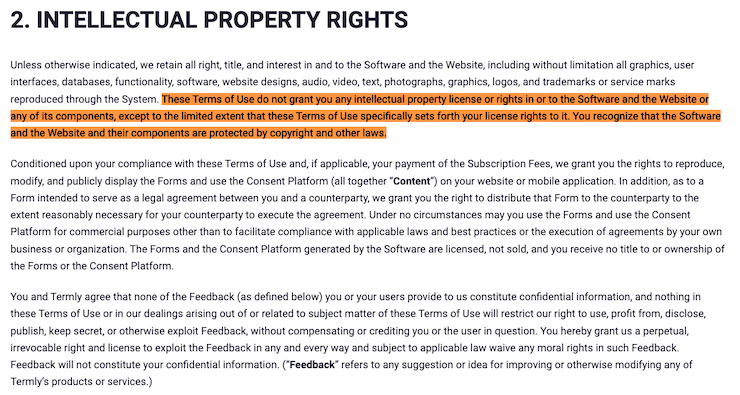
This sample disclaimer clause allows you to lay claim to your site’s creative assets. However, notifying users of your copyright as soon as they access your site is also important.
One effective way to do this is to place a copyright notice in your site’s footer. It should be comprised of the following four parts:
- The copyright symbol
- The year of publication
- The name of the copyright owner
- The rights you wish to retain
If you don’t put what rights you wish to retain at the end of your notice, the legal assumption is that you’re maintaining all rights.
In the screenshot below, see how the copyright notice looks on Instagram’s homepage:

Putting this information in the footer of your website helps you prove that your users were aware of your intellectual property rights as soon as they accessed your site. By doing this, you will have a stronger case if a dispute goes to court.
If your site or app uses content from other sources, you must include a fair use disclaimer to prevent your business from being accused of copyright infringement.
Under the principle of fair use , copyrighted works can be used in certain circumstances without the permission of the copyright owner.
According to Section 107 of the Copyright Act:
“The fair use of a copyrighted work […] for purposes such as criticism, comment, news reporting, teaching (including multiple copies for classroom use), scholarship, or research, is not an infringement of copyright.”
To protect your business from copyright infringement claims, follow these steps:
- State that your site may contain content not authorized for use by its owner
- Explain how your use of this material falls under the guidelines of fair use (e.g., comment)
- Link to Section 107 of the Copyright Act
Below, check out an example of a fair-use copyright disclaimer from a YouTube video that meets these requirements.
You can defend your use of original content with similar disclaimer language based on the category of fair use you are using copyrighted work under and any applicable licenses.
Artificial Intelligence (AI) Disclaimer
If your company publishes content generated by artificial intelligence (AI) or machine learning models, consider adding an AI disclaimer to your site to differentiate it from your human-created content.
Over the past few years, AI technology quickly advanced and become more accessible to the everyday internet user.
For example, businesses can now use AI to create customized icons or quickly write blog posts using AI for their websites. And that’s just a few examples from a rapidly-growing toolset.
As exciting as this is, the U.S. Copyright Office released an AI Policy Guidance in the Spring of 2023 stating that you must disclaim any purely AI-created materials from your copyright application. Plus, your consumers also prefer knowing the difference .
We suggest including a disclaimer on your website or app that explains what parts of your platform were created by people and the specific content, logos, or other features you made using AI.
Confidentiality disclaimers, also known as email disclaimers , explain that some content is only intended to be seen by a certain audience — for example, private information in an email.
Digital communication offers more opportunities for confidential information to be exposed or intercepted. A confidentiality disclaimer states who the message is for, why the recipient should not forward it to others, and who they should contact if they receive it by mistake.
Email hosting company Zoho offers a sample disclaimer to include in an email signature:
This message contains confidential information and is intended only for the individual named. If you are not the named addressee, you should not disseminate, distribute or copy this email. You cannot use or forward any attachments in the email. Please notify the sender immediately by email if you have received this email by mistake and delete this email from your system. Company X, Suite# 1, Street, City, Country, www.company.com
Confidentiality disclaimers are commonly used in law, education, and healthcare — industries that rely on the transfer of sensitive information. For example, they’re useful in situations where a business needs to ensure attorney-client privilege, safeguard sensitive personal data, or protect private health records.
If you send emails containing protected health information to US medical patients, a confidentiality disclaimer is required to comply with the Health Insurance Portability and Accountability Act (HIPAA) .
The screenshot below shows a HIPPA email disclaimer sample from the University of Miami .

Standard disclaimer text like this can help meet HIPAA’s list of precautions for emails .
If your business sends certain confidential information by email, add a confidentiality disclaimer to all electronic communications to comply with the law or just to ensure your messages are only seen by the intended audience.
To explain that sellers and service providers are not bound by any implied promises about their products in the event of failures or defects, add warranty disclaimers to your website or app.
These statements vary depending on the nature of your business but typically explain that a product or service is offered “as is” — implying that the customer or user accepts it in its current condition, including any unseen faults.
For websites and apps, warranty disclaimers state that the company makes no promises about the accuracy and reliability of the content it publishes. Below, see an example from our warranty disclaimer template.

This standard disclaimer wording allows you to avoid responsibility for any mistakes, errors, or omissions that occur. This prevents users from taking legal action against your business because of a simple mistake.
Here’s a screenshot of a good example from Tumblr’s terms of service:
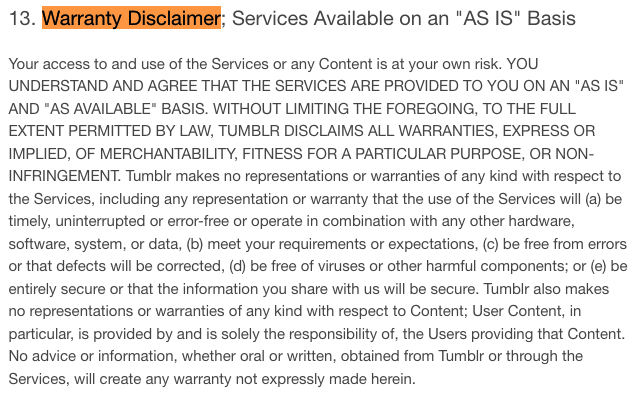
The disclaimer tells users that the service is provided on an “as is” and “as available” basis and that by using it, visitors accept that it may contain defects or not meet their expectations.
Another example we’ve included below comes from Amazon’s disclaimer of warranties , a suitably comprehensive statement that applies to its services and products.
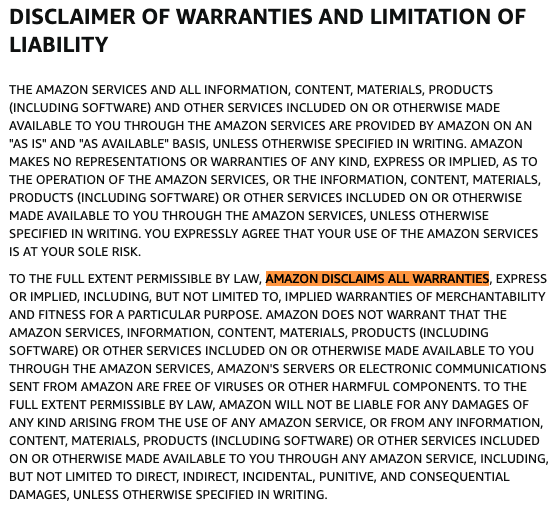
All sites and apps are subject to unforeseen technical issues, and warranty disclaimers limit your liability for problems outside of your control, such as viruses or general downtime.
If you want to explain to users that your business will not be held responsible for any damages they suffer as a result of using your products or services, put a no-responsibility disclaimer on your site.
Because these agreements limit your liability, they are also often referred to online as “no liability” disclaimers or “use at your own risk” disclaimers.
No-responsibility disclaimers address both tangible and intangible damages — for example, physical harm caused by using a product, loss of profits or loss of data , and defamatory comments.
Pictured below is Twitter’s terms of service , which includes a particularly detailed limitation of liability disclaimer.
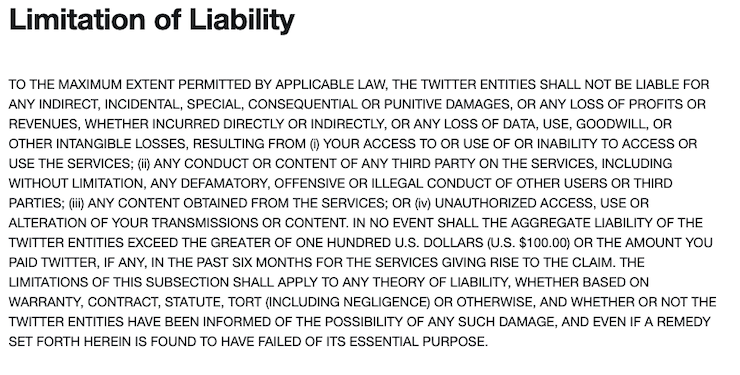
This disclaimer notice explains that Twitter will not be held responsible for the content its users choose to share, which may be offensive to others.
The Information Commissioner’s Office (ICO), which enforces global privacy laws such as the General Data Protection Regulation (GDPR) in the UK, also has a disclaimer on its site , shown below.
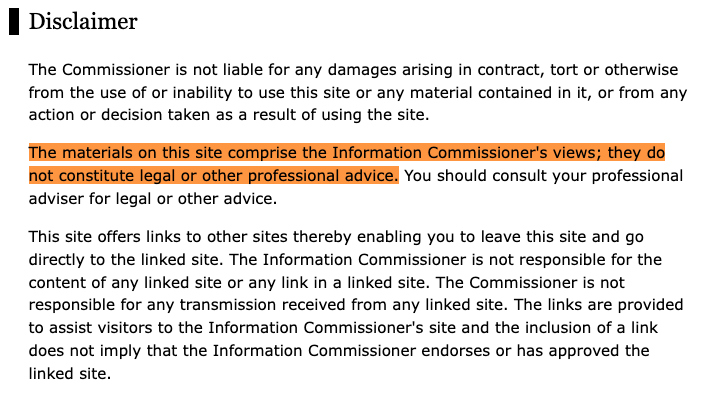
Because the ICO discusses privacy law compliance, it must inform users that the information it provides is not legal advice and that the external website links it provides are only for reference.
It’s critical to limit your business’s liability for all aspects of your operations — even for small things like linking to other websites.
To state that the views and opinions on your site or platform by contributors are not the same as those of the business, add a views expressed disclaimer to your website.
This type of disclaimer is vital if your site allows contributions from others or provides a platform for users and guests to leave comments. It explains in legal terms that the opinion of an author you publish is not the same as that of your company or organization.
Below, is an example from the Federal Communications Commission (FCC) podcast disclaimer .

The FCC’s disclaimer clearly explains to users that the podcast exists to offer guidance, not to provide a strict interpretation of FCC policy.
As another example, Fox News has a disclaimer that addresses user-generated content on its message boards and forums:
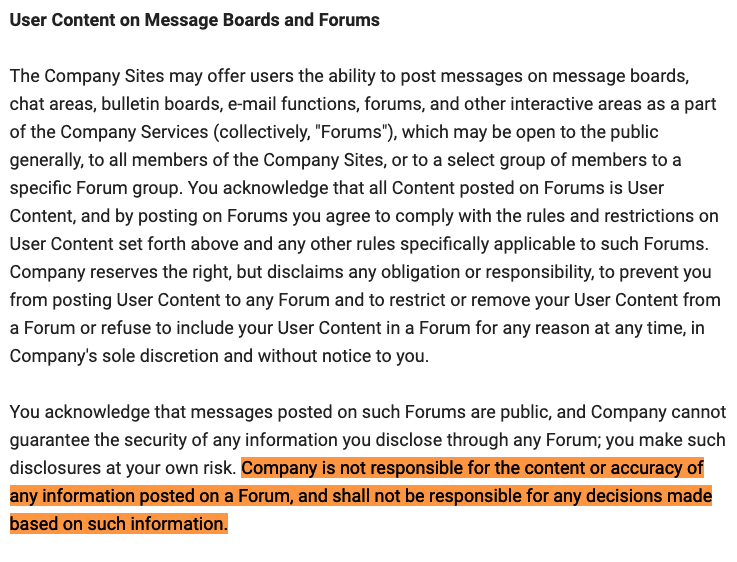
The Fox News disclaimer is a good example of how a news website can benefit from the discussion created by user-generated content but still distance itself from the views expressed.
If you allow contributors or users to share their opinions through forums or for marketing purposes, a views expressed disclaimer is a handy weapon in your legal arsenal.
Investment disclaimers explain that while a business may provide financial advice, it is not responsible for the consequences of acting on that advice. It can also act as a past performance disclaimer, which informs your users that past financial outcomes do not equal future results.
These disclaimers are suitable for sites that deal with all types of investments, from mutual funds to real estate.
Below, see Citigroup’s terms and conditions for a good example:
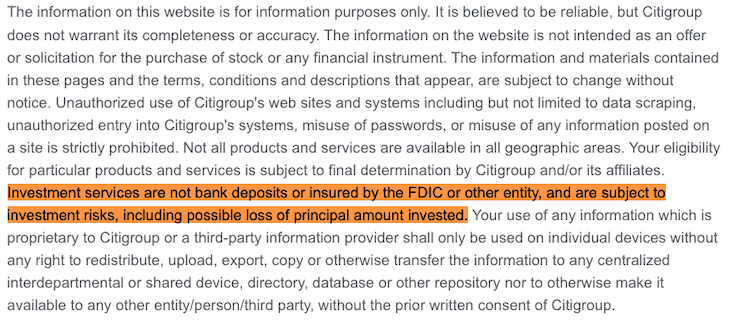
The clause above clearly states that Citibank will not be responsible for the consequences of using its investment products, such as losses associated with the risks of investing.
An investment disclaimer also explains that past performance is not an indicator of future results.
Similar financial disclaimers are found on cryptocurrency websites. For example, CoinDesk’s terms and conditions includes the following investment disclaimer clause:
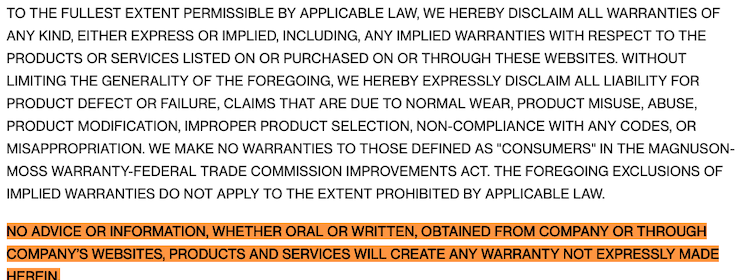
Although CoinDesk provides information about investing in digital assets, its disclaimer says no advice or information on the site guarantees any warranty of any kind. In a turbulent industry such as crypto, it’s important for a company to fully disclaim all responsibility for decisions its users make.
No matter how professional your services are, you should not be responsible for how your users act upon them. Investment disclaimers are just one industry example of how you can protect your specific business interests.
No guarantee disclaimers state that a business makes no promises regarding the outcome of using its product or service.
One of the best examples of this online comes from Wikipedia’s disclaimer :

This disclaimer explains that although Wikipedia has a team of editors, it has no formal peer review and, therefore, cannot guarantee the validity of information contained on its site.
It includes a separate clause stating that while it covers various topics, it does not constitute advice in that discipline:
If you post any type of informational content, a standard no-guarantee disclaimer clause allows you to be a source of industry knowledge without any obligations to your users.
The US Equal Employment Commission’s disclaimer is similar:
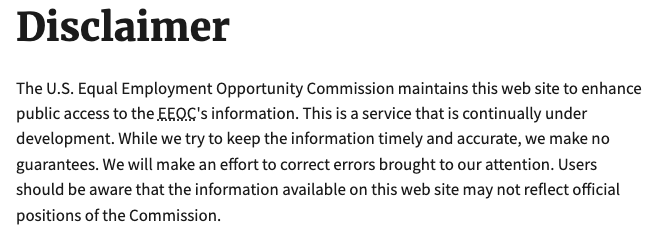
Whatever type of website you operate, it’s valuable to include a no-guarantee disclaimer like the ones above to stop users from taking advantage — for example, suing for errors.
A medical disclaimer informs users that any content on your site is provided for informational purposes only and does not qualify as professional medical advice. These are useful for:
- Pharmaceutical companies
- Healthcare organizations
See the easy-to-understand medical disclaimer that St. Jude Children’s Research Hospital includes on their website, stating that they are not a replacement for seeing a doctor:

Similarly, if you give advice or recommendations on your site that could lead to potential health risks, you might consider using a health disclaimer, especially if you run a:
- Health blog
- Gym website
- Fitness service
Below, see how fitness and lifestyle blog Jenny J Fitness uses a health disclaimer to deny responsibility on their website.
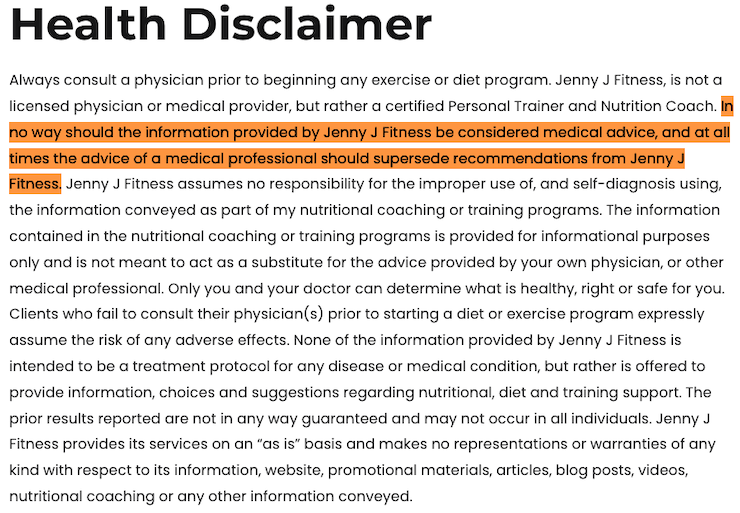
If you’re posting any medical or health information on your website or app, include this disclaimer so your users know that your service does not replace seeing an actual doctor, and establish that you’re not responsible for any harm that may occur if users follow your advice.
If you participate in any affiliate programs, adding an affiliate disclaimer to your website discloses your participation to your users so they cannot hold it against you or claim not to know that you’ve partnered with a third party.
Posting an affiliate disclosure is also legally required by the US Federal Trade Commission ( FTC ).
This disclaimer lets your users know if you’re being compensated by the companies whose products you mention on your website or app, and it must appear on every page that includes a sponsorship, endorsement, or affiliate link.
This disclaimer is relevant for:
- Social media influencers
- Blogs with sponsored posts
- Content creators who reference affiliate products
In the screenshot below, see how Casey, owner of the food and lifestyle blog Get On My Plate , uses a conversational tone for her affiliate disclaimer and clearly states that she gets monetary compensation whenever anyone uses the links on her site.
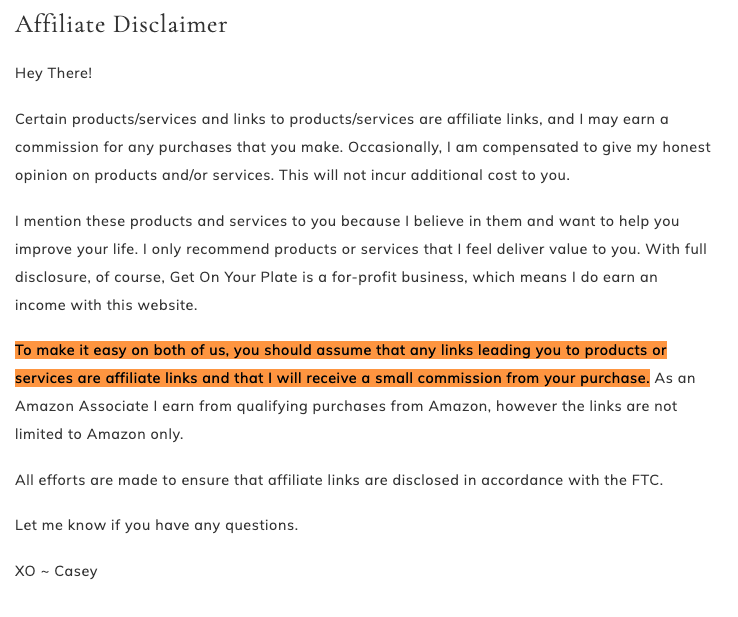
For more information relevant to blog owners and social media influencers, check out our blog disclaimers guide .
If you post content on YouTube, you can add the appropriate YouTube disclaimers to the description of your video, like a copyright, no responsibility, music, or fair use disclaimer to limit what you can be held liable for doing, using, or showing in your content.
These disclaimers are especially important if your video:
- Provides advice of any kind
- Features other people’s intellectual property
- Features your own copyrighted materials
If your video features materials created by someone else, like movie clips, you should add a fair use disclaimer in the description.
Below, see a YouTube video disclaimer example from The Cosmic Wonder .
To present its fair use guidelines , YouTube includes a link to a copyright resource in its website footer, as shown below.
In their guidelines, YouTube includes a copyright and fair use disclaimer explaining that it receives many takedown requests under copyright law and strives to protect creators, as shown in the highlighted text below.

If your website or app relies on content created by others, you can learn from YouTube’s open and accessible approach to fair use to build trust with your users.
Keep in mind that YouTube content creators and businesses that target children under 13 need to also comply with the Children’s Online Privacy Protection Act (COPPA) .
Social Media Disclaimers
If your business has a strong social media presence, post a relevant social media disclaimer covering topics like what is allowed to be shared on your website or app, how opinions shared by an employee do not reflect the company’s beliefs, and any other relevant removal of liabilities.
In the screenshot below, see how St. Phillips College puts a social disclaimer on their website that clarifies that they’re not responsible for anything shared or posted by third-party sources.
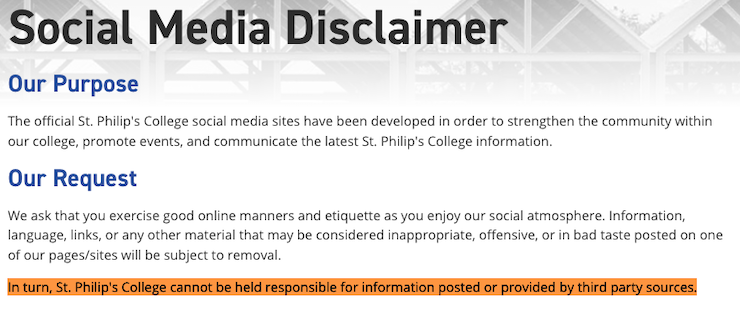
St. Phillip’s College also uses this clause to dictate what users can and cannot post on their social media pages.
Consider adding a similarly phrased disclaimer on your website or app to prevent your company from being held responsible for things your users may post or share online.
If you allow users to share reviews about your services, post a testimonial disclaimer on your website to let people know that another person’s review does not guarantee that every experience using your services will be the same.
This disclaimer states that the review or testimonial represents one person’s experiences and transparently informs others if the poster was paid or compensated for their time and opinion.
In the US, you are legally required by the Federal Trade Commission to have a testimonial disclaimer posted on your site if you allow your users to share reviews or endorsements of your products.
Below is an example statement from Stillwater Acupuncture clarifying that not everyone using their services has the same experience.
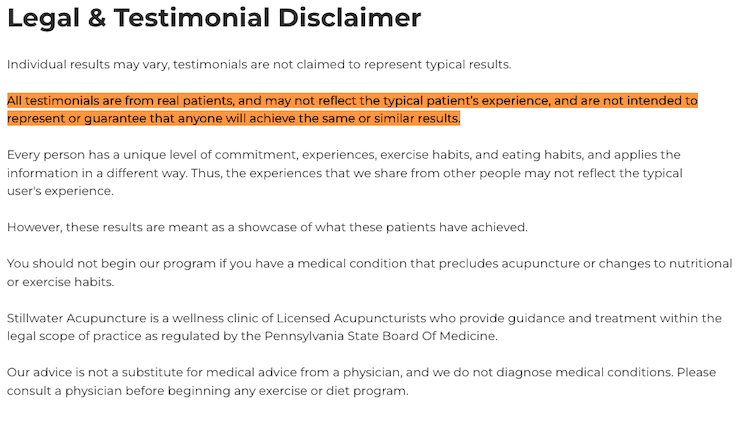
A testimonial disclaimer is important because it protects your business and builds trust with your users. This disclaimer helps properly set your users’ expectations and reminds them that customer reviews and testimonials are not indicative of every person’s experience.
Legal Disclaimer
If your website or app gives out any legal information, you should use a disclaimer to clarify that it does not qualify as real legal advice.
You can also explain to users that your website does not replace the services of an actual independent lawyer.
See a legal disclaimer example below from the National District Attorneys Association (NDAA) website.
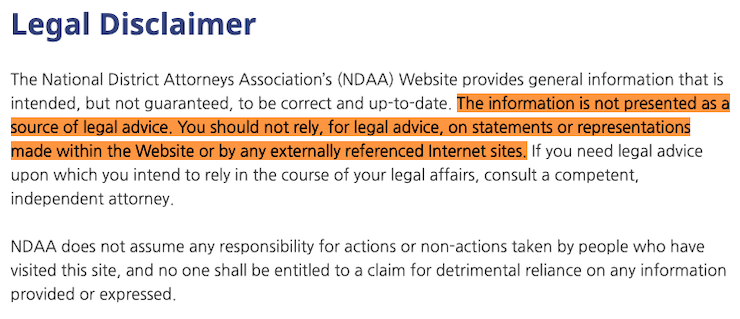
For law firm websites and lawyer blogs, posting this disclaimer prevents liabilities from falling onto you. It can also be used to inform your users that accessing your website does not mean they get any attorney-client privileges.
You can write your disclaimers entirely from scratch or save time by using free customizable templates or disclaimer generators.
Whatever method you choose, be mindful of how these clauses are written because you want as many of your users as possible to be able to read and understand them.
Our free, downloadable disclaimer template is written in simple language and can be easily modified to address the liabilities you have on your website or app. Rather than doing everything yourself, it provides you with the bulk of the information written by our legal team and data privacy experts.
Alternatively, you can quickly create a free disclaimer by answering a few simple questions using our Disclaimer Generator . Our generator is more in-depth and does as much work for you as possible.
Post your disclaimers in your terms and conditions agreement or share them in your website’s legal section; that way, your users can always easily find the information.
If you’re looking for more answers, here are some frequently asked questions we get about disclaimers.
Do I need a disclaimer?
Yes, you need a disclaimer to protect your website against legal liabilities. Disclaimers inform users that your site will not be held responsible for any damages suffered from using your services.
For example, if you run a legal blog, a legal disclaimer will tell users that your content should not be taken as legal advice, and your site will not be held accountable for any legal actions the reader may take.
Whether you run an ecommerce site, blog, app, or general website, you need a disclaimer — or multiple disclaimers — to be transparent with users and protect yourself against legal claims.
Why should I use a disclaimer?
You should use a disclaimer to help limit the liabilities your business can be held responsible for and to establish and maintain your intellectual property rights.
Can I copy someone’s disclaimer?
No, you cannot copy someone else’s disclaimer, as this is plagiarism, and the information will not apply to your business. Instead, use a free disclaimer template or a generator to customize your own.
Where do I put my disclaimer?
Put your disclaimer where users can easily find it, for example, you can put your disclaimer or disclaimers on a separate page, then link to that page in your website menu, footer, or Impressum page , if you have one.
You should also put your disclaimers on relevant content. For example, if you promote an Amazon product in a blog post through the Amazon Affiliates program, you need to add an Amazon Affiliates disclaimer to that blog post.
What types of disclaimers are there?
There are many types of disclaimers that address liabilities for different industries, activities, and content, and the most common types of disclaimers are:
- Fair Use Disclaimer: Discloses that you are legally using copyrighted materials on your website and with the appropriate permissions.
- Warranty Disclaimer: Explains that sellers and service providers are not responsible for possible product or service failures.
- Copyright Disclaimer: Lets site visitors know that your site contains copyrighted material.
- No Responsibility Disclaimer: Informs users that you are not responsible for the actions they take based on content found on your website.
- Confidentiality Disclaimer: Assures users that some content, such as contact information, is only intended to be seen by certain parties.
- Affiliate Disclaimer: Discloses your participation in an affiliate program, such as Amazon Associates.
- YouTube Disclaimer: Any disclaimer found in the description of a YouTube video. Commonly, copyright disclaimers and no responsibility disclaimers double as YouTube disclaimers.
- Views Expressed Disclaimer: Specify that the opinions found on your website are not the views or opinions of your business.
- Investment Disclaimer: Informs readers that your investment commentary is informational and should not be taken as official advice.
- No Guarantee Disclaimer: Announces that your website or business makes no promises about the results of a product or service.
- Use at Your Own Risk Disclaimer: Instructs your site’s visitors to act on your content or recommendations at their own risk.
- Email Disclaimer: Any disclaimer added to the footer of an email. Most often, confidentiality disclaimers act as email disclaimers.
- Past Performance Disclaimer: States that previous results do not equal future results.
- Medical Disclaimer: Informs users that the content on the site is provided for informational purposes only and does not substitute professional medical advice or seeing a doctor.
Disclaimers reinforce your company’s legal defenses by specifically addressing certain liabilities that aren’t explained in your other policies.
To recap, there are many types of disclaimers, and you need to pick the ones that best suit your needs. For example:
- Copyright disclaimers help protect your original content
- Fair use disclaimers help you avoid copyright infringement claims
- Confidentiality/email disclaimers help maintain the confidentiality of private information
- Warranty disclaimers prevent you from being bound by faults and defects
- No responsibility disclaimers limit your liability for damages
- Views expressed disclaimers allow you to distance yourself from others’ opinions
- Investment disclaimers state that you take no responsibility for how others act on your advice
- No guarantee disclaimers explain the limits of your products or services
The benefit of all disclaimers, no matter the industry, is to safeguard your business interests. If you don’t have a disclaimer, you’re potentially leaving your business vulnerable to legal trouble.
The good news is we can help you start protecting your business better. Just use our free disclaimer template to get started writing your own, or create custom disclaimers in minutes using our comprehensive Disclaimer Generator .

More about the author
Written by masha komnenic cipp/e, cipm, cipt, fip.
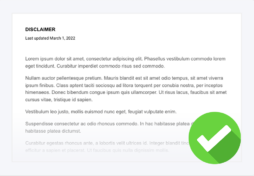
Generate a FREE Custom Disclaimer
Related articles, can i copy terms and conditions.
July 1, 2024 Etienne Cussol CIPP/E, CIPM
Product Disclaimer: Examples & Guide
June 21, 2024 Masha Komnenic CIPP/E, CIPM, CIPT, FIP
Which Laws Does Termly Cover?
June 7, 2024 Etienne Cussol CIPP/E, CIPM
Fair Use Disclaimer Examples & Guide
February 20, 2024 Masha Komnenic CIPP/E, CIPM, CIPT, FIP
Amazon Affiliate Disclosure: Template & Examples
February 14, 2024 Masha Komnenic CIPP/E, CIPM, CIPT, FIP
Affiliate Disclosure: Examples & Writing Guide
February 12, 2024 Masha Komnenic CIPP/E, CIPM, CIPT, FIP
What Is an Impressum and Do You Need One? (with Examples)
February 6, 2024 James Ó Nuanáin, CIPP/E, CIPM, CIPT
Medical Disclaimer Examples
February 1, 2024 Masha Komnenic CIPP/E, CIPM, CIPT, FIP
Website Checklist for Data Privacy and Security
June 15, 2023 James Ó Nuanáin, CIPP/E, CIPM, CIPT
Explore more resources
- Preparing to Apply
- How to Apply
- After Applying
- Why Penn State?
- Military and Veteran Students
- Frequently Asked Questions
- Degree Programs
- Academic Dates and Deadlines
- Policies for Students
- Theses and Dissertations
- Integrated Undergraduate-Graduate Plans
- Commencement
- Planning Your Finances
- External Funding Opportunities
- Information for Graduate Assistants
- Student Recognition Awards
- Funding FAQ
- Professional Development
- New Students
- From the Dean
- Advising and Mentoring Tips
- Academic Support
- Student Support FAQs
- Addressing Concerns
- Well-Being Resources
- Office of Graduate Educational Equity Programs (OGEEP)
- Graduate School Open House
- Programs and Initiatives
- McNair Scholars Program
- Summer Research Opportunities Program (SROP)
- Resources and Partners
- Office of the Vice Provost for Graduate Education and Dean
- Vision, Mission, and Strategic Plan
- By the Numbers
- Contact the Graduate School
- Resource Library
This dialog contains the full navigation menu for gradschool.psu.edu.
The Graduate School
- Student Support
Information For
- Alumni and Friends
- Veterans and Military Service Members
Helpful Links
- Graduate Education Policies
- Student Teaching Certificate
- Graduate Exhibition
- Three Minute Thesis
- Accelerate to Industry
For Faculty and Staff
- Graduate Council
- Graduate Education Resource Portal

Social Media
Tips & support.
- On this Page
How to Avoid the Most Common Mistakes
- Get the name of your major absolutely correct (e.g., Psychology, not Clinical Psychology).
- The thesis/dissertation title must be in all CAPITAL letters and double-spaced, and the date must be the month and year of your graduation.
- Doctoral candidates: use “dissertation” instead of “thesis” throughout the document.
Front Matter (the section before the text of the thesis)
- Front matter must be numbered with lower case Roman numerals.
- In the table of contents, do not list the title page, committee page, abstract, or vita. Do include the list of tables, list of figures, acknowledgements, chapters, references or bibliography, and appendices (with titles).
- Chapter titles in the table of contents should match the actual chapter titles in the text. Number chapters consistently (e.g., Chapter I, Chapter One, or Chapter 1).
- No signatures should appear in the document (the committee page is not for signatures).
- The committee page should be an exact list of those entered on the eTD submission, but do not list any name twice even if a professor has two roles (e.g., advisor and department head).
Page Numbers
- The text must begin on page 1 and be numbered from beginning to end without breaking sequence.
- Do not use running headers, and do not embellish page numbers (e.g., -1-, Page 1, 125a).
General Advice
- There should be no blank pages in the thesis/dissertation.
- Submit the format review as early as possible, but do not submit a second format review (even if you don’t finish until the next semester, a second format review is not necessary).
- Carefully complete each step outlined in the format review.
- When naming your pdf file, do not use special characters (e.g., /, ?, &), and do not make the file name extremely lengthy by using the entire thesis title.
- Doctoral candidates: include a copy of the title page and abstract with the ProQuest/UMI Agreement.
- Remember that, after approval of the final eTD by the Office of Theses and Dissertations, no further changes can be made.
- Most importantly, carefully read and follow the Thesis and Dissertation Handbook .
Thesis and Dissertation Handbook
Requirements and guidelines for the preparation of Master's Theses and Doctoral Dissertations.
How to Submit a Doctoral Dissertation
- Become familiar with the requirements by reading the Thesis and Dissertation Handbook carefully.
- Apply to graduate on LionPATH during the semester in which you plan to graduate. Deadlines for submitting your dissertation can be viewed on the Thesis, Dissertation, Performance, and Oral Presentation Calendar .
- Upload a draft of your dissertation for format review (pdf only) to the eTD website by the specified deadline. Corrections and detailed instructions will be returned to you by email.
- Defend the dissertation and make any changes required by your committee. This can be done either before or after the format review, as long as deadlines are met.
- Review the dissertation one final time to be sure that no further changes are needed. It will not be possible to make corrections after final approval by the Office of Theses and Dissertations. Convert the file into a pdf for eTD submission. If you cannot do this, contact the Office of Theses and Dissertations for assistance.
- Go to the eTD website and upload the final eTD; submit supporting materials to the Office of Theses and Dissertations. (Note: It does not matter if you upload first or submit the materials first.) Supporting materials are: ProQuest/UMI Agreement, Survey of Earned Doctorates, and $95 fee. The fee can be paid at the Payment Section of the Graduate School Thesis and Dissertation Information webpage.
- Await notification of eTD approval by email. If changes are required, you will be notified. Your eTD will be accessible on the eTD website immediately after graduation, unless you have chosen restricted access.
If bound copies are needed, contact any Multimedia & Print Center on campus or you may use an off-campus source. All copies are the author’s responsibility. The Graduate School does not provide copies.
How to Submit a Master's Thesis
Apply to graduate on LionPATH during the semester in which you plan to graduate. Deadlines for submitting your thesis can be viewed on the Thesis, Dissertation, Performance, and Oral Presentation Calendar .
- Upload a draft of your thesis for format review (PDF only) to the eTD website by the specified deadline. Corrections and detailed instructions will be returned to you by email.
- Make any changes required by adviser and/or readers.
- Review the thesis one final time to be sure that no further changes are needed. It will not be possible to make corrections after final approval by the Office of Theses and Dissertations. Convert the file into a PDF for eTD submission. If you cannot do this, contact the Office of Theses and Dissertations for assistance.
- Go to the eTD website and upload the final eTD; and pay $10 thesis fee. The fee can be paid at the Payment Portal .
Format Review
What to submit and how to submit it.
The format review is a chance for Office of Theses and Dissertations staff to take a preliminary look at your thesis or dissertation to check for formatting errors. The goal is to ensure that you are following the requirements set forth in the Thesis and Dissertation Handbook .
Please submit as complete a draft as possible , including:
- front matter (title page, committee page, abstract, etc.)
- several chapters
- back matter (references, appendices)
The draft submitted for format review does not have to be the final version, but you must submit more than just a few pages in order to complete the format review requirements.
To submit your file for format review, go to eTD website .
Survey of Earned Doctorates (SED)
Congratulations on completing your doctoral degree!
We request that all research doctorate recipients participate in the Survey of Earned Doctorates (SED) .
Conducted annually since 1957, the SED is a census of all individuals receiving a research doctorate from an accredited U.S. institution in a given academic year. It is sponsored by the National Science Foundation and five other federal agencies. The SED collects information on the doctorate recipient’s educational history, demographic characteristics, and post-graduation plans. Results are used to assess characteristics of the doctoral population and trends in doctoral education and degrees.
The ability of the survey to accurately describe doctorate earners depends on obtaining responses from all doctoral degree recipients. Your response affects decisions made for the future generations of doctorate recipients.
How to Participate:
- Register online to participate in the survey. After you register, you will receive a PIN and password as well as the link to the survey.
- Penn State requests verification of survey completion. You can enter up to two email addresses where you would like the notification of completion to be sent to or forward the email notification. Please send all notifications to [email protected] .
If you have questions related to the SED, please contact 877-256-8167 or email [email protected] .
In the fall of 1998, Penn State’s Graduate School, Information Technology Services , Digital Library Technologies, and University Libraries embarked upon an initiative to allow theses and dissertations to be submitted and archived electronically. What began as a pilot project is now required for all doctoral students, and masters students requiring a thesis at Penn State. Joining Virginia Tech, West Virginia University, and other universities across the nation, Penn State has enabled its students to incorporate multimedia formats into their theses/dissertations and to submit them electronically—the final product being easily accessible worldwide.
Electronic theses and dissertations (eTDs) expand the creative possibilities open to students and empower students to convey a richer message by permitting video, sound, and color images to be integrated into their work. Submitting and archiving eTDs helps students to understand electronic publishing issues and provides greater access to students’ research. People from any place on the globe can link directly to eTD collections at Penn State and other universities.
Acknowledgement of Federal Funding
As described in the Research Terms Clarification :
2 CFR § 200.328(see pp. 20-21), all federal funds used in the research and writing of a thesis or dissertation must be explicitly acknowledged in the acknowledgment section of the document, along with a disclaimer indicating that the findings and conclusions do not necessarily reflect the view of the funding agency.
Research Terms and Conditions Overlay
Legal Statements
- Non-Discrimination
- Equal Opportunity
- Accessibility
- The Pennsylvania State University © 2024
Stack Exchange Network
Stack Exchange network consists of 183 Q&A communities including Stack Overflow , the largest, most trusted online community for developers to learn, share their knowledge, and build their careers.
Q&A for work
Connect and share knowledge within a single location that is structured and easy to search.
Paper based on Master Thesis - Disclaimer necessary?
Making my Master Thesis into a paper.
I've recently come across a paper that put a disclaimer into the introduction:
This study is a continuation of work presented in the PhD Thesis ... .
I wanted to know if such a disclaimer is necessary if my paper is based on my Master Thesis.
- publications
- 1 Such disclaimers aren't necessary, but they might appear in the "related work" section to provide additional background. (I would discourage inclusion in the introduction, unless that is where the related work section appears.) If the paper will be co-authored, then such a citation will help distinguish your personal contribution from your contribution in collaboration with others. – user2768 Commented Nov 14, 2017 at 17:25
- It doesn't seem necessary to me (this may be field dependent), but it seems like there's no harm so it's safest to add a footnote to this effect. – Thomas Commented Nov 14, 2017 at 18:09
- I do not see a big problem here. However avoid cutting and paste .Really rewrite the paper keeping in mind that it is now a self-standing piece of work. – Alchimista Commented Dec 3, 2017 at 10:09
Yes, this is necessary.
Self Plagiarism may seem like a strange thing to be worried about, but there are many reasons to avoid it the way you would any other plagiarism:
- Some journals use double blind reviewing, so reviewers can't distinguish between self-plagiarism and plagiarism.
- You may have received funding for your thesis, which is probably acknowledged in your thesis, but not necessarily in the paper version.
- People reading your paper may want to read the full Master's thesis, since theses generally contain more detail and are less space-constrained than papers.
- Thanks for the quick reply. Is a full disclaimer necessary or is merely citing the thesis at some point already sufficient? Is there some guide online or ethics handbook out there that I could point to for guidance. – oldmansaur Commented Nov 14, 2017 at 18:30
- But wouldn't self plagiarism require that the thesis was published? I thought you could only plagiarize published work. – morxa Commented Nov 14, 2017 at 18:43
- @morxa I don't see why this is the case. In the general case of plagiarism, if I read something on a blog, or in a colleague's notes, and publish it claiming that it's my own, it is still plagiarism. For a thesis, it's a big more of a grey area as to what "published" means, but most universities keep an archive of all theses completed, so while not peer-reviewed, they are published (in a sense). – Joey Eremondi Commented Nov 14, 2017 at 19:29
- @oldmansaur I'd say that citing is necessary, and a full disclaimer is helpful, albeit not necessary. It will likely put your work into context, which can help potential readers of your paper. I'd view it not as a disclaimer, but as contextualizing the paper in terms of related work. – Joey Eremondi Commented Nov 14, 2017 at 19:30
- 2 I feel like this is another case where it comes down to the field of study. From a chemists point of view: parts of a phd thesis are often published afterwards and I've never seen a disclaimer or anything like that. A PhD thesis, even if published through the university library, doesn't usually count as peer-reviewed article. In addition, it's pretty common that the thesis itself is just a collection of published papers and drafts. – user64845 Commented Nov 15, 2017 at 0:34
You must log in to answer this question.
Not the answer you're looking for browse other questions tagged publications ethics ..
- Featured on Meta
- We spent a sprint addressing your requests — here’s how it went
- Upcoming initiatives on Stack Overflow and across the Stack Exchange network...
Hot Network Questions
- Is it an option for the ls utility specified in POSIX.1-2017?
- Did any other European leader praise China for its peace initiatives since the outbreak of the Ukraine war?
- Can I give a potential employer the LinkedIn address of my previous employer instead of his email address?
- Is it possible with modern-day technology to expand an already built bunker further below without the risk of collapsing the entire bunker?
- Is it a security issue to expose PII on any publically accessible URL?
- Does physical reality exist without an observer?
- How to delete an island whose min x less than -1
- How to calculate mean CPU and memory usage of a command line?
- Part name of this IC - Analog Devices, 8-pin, "S 6B" A 06" "C 42"
- A model suffering from omitted variable bias can be said to be unidentified?
- Why are metal ores dredged from coastal lagoons rather than being extracted directly from the mother lode?
- Is this a Hadamard matrix?
- French Election 2024 - seat share based on first round only
- Histogram manipulation
- Why does Macbeth well deserve his name?
- Any philosophical works that explicitly address the heat death of the Universe and its philosophical implications?
- How will a planet on asteroid belt see Jupiter?
- Where do we go if we gain knowledge of the absolute truth?
- An adjective for something peaceful but sad?
- How to turn a sum into an integral?
- I am trying to calculate Albumin-Creatinine ratios for research, why is the result so high?
- What do American people call the classes that students go to after school for SATs?
- Reference about cancellation property for semigroups
- Problem computing a limit

Dissertation Questionnaire
Questionnaire generator.
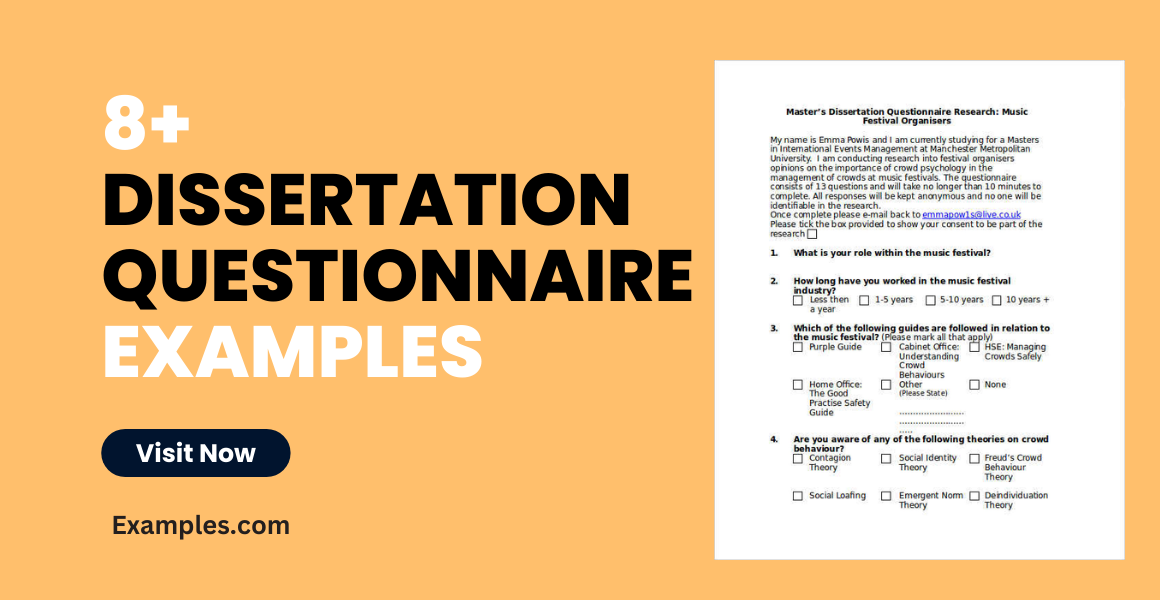
A dissertation is a document usually a requirement for a doctoral degree especially in the field of philosophy. This long essay discusses a particular subject matter uses questionnaires and other sources of data and is used to validate its content. The questionnaire’s importance is evident in the processes of data gathering as it can make the dissertation factual, effective and usable.
Having a well-curated and formatted document to follow when making a dissertation can be very beneficial to an individual who is currently immersed in the data gathering stage of the specific research study. We have gathered downloadable samples and templates of questionnaires so it will be easier for you to curate your own.
Dissertation Timeline Gantt Chart Template
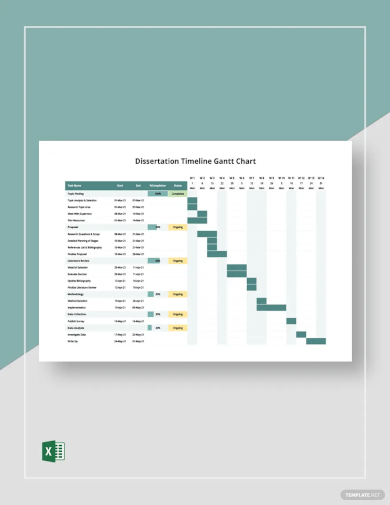
Size: 55 KB
Dissertation Research Gantt Chart Template
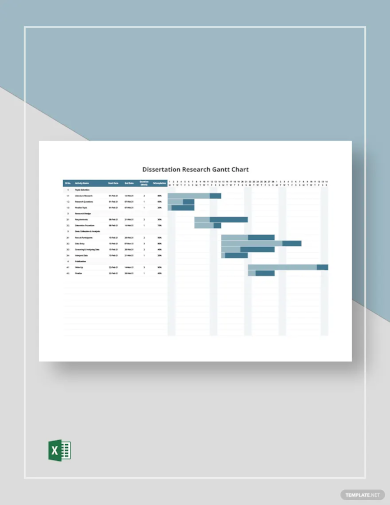
Size: 43 KB
Dissertation Project Gantt Chart Template
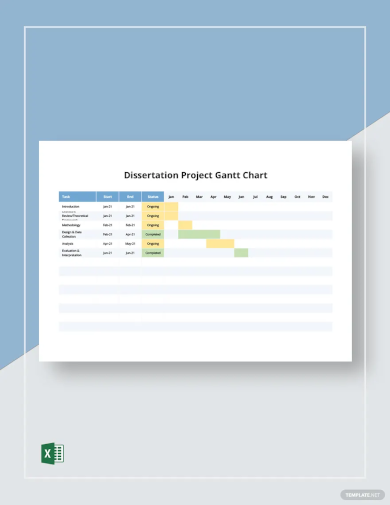
Size: 41 KB
Dissertation Plan Gantt Chart Template
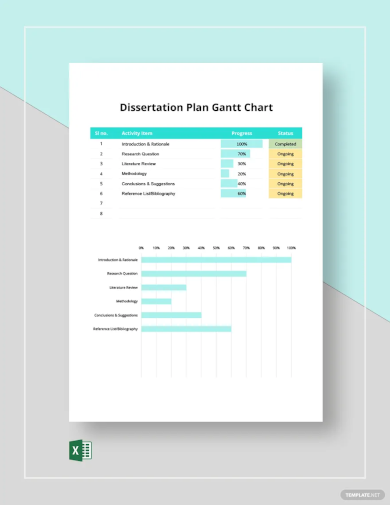
Size: 51 KB
Dissertation Research Questionnaire
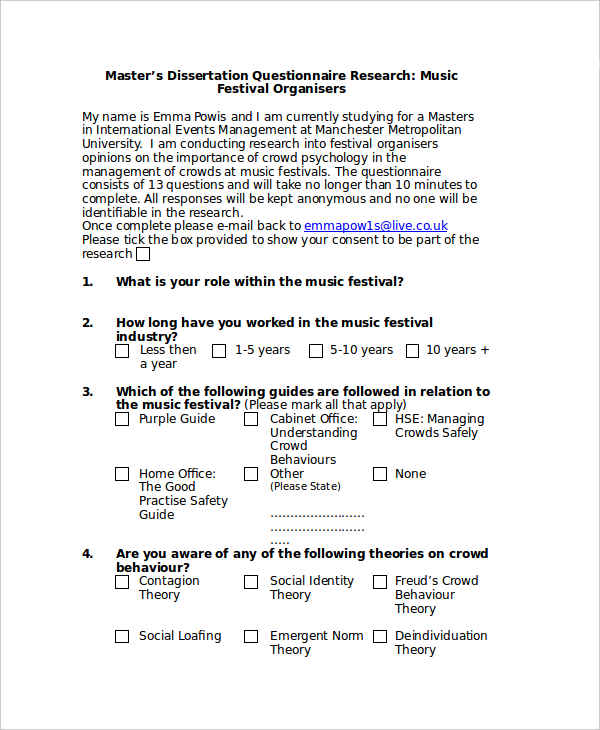
Size: 18 KB
Dissertation Proposal Questionnaire
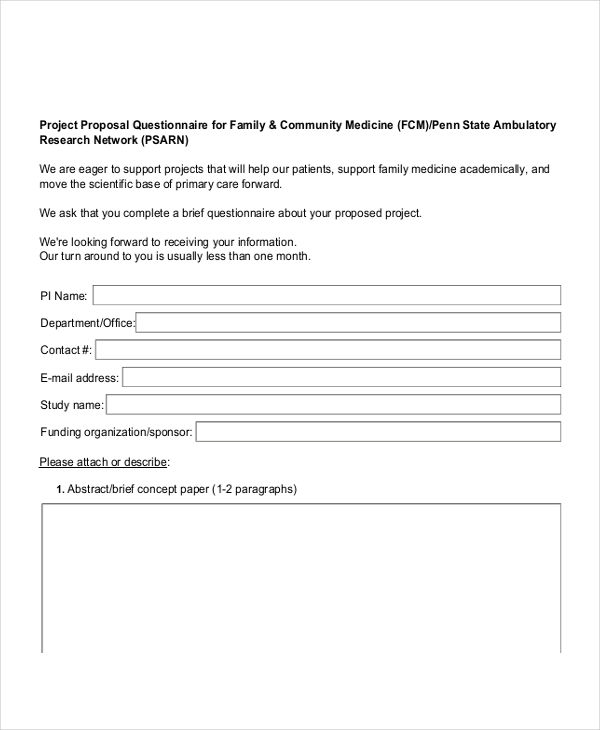
Size: 131 KB
Sample Dissertation Questionnaire
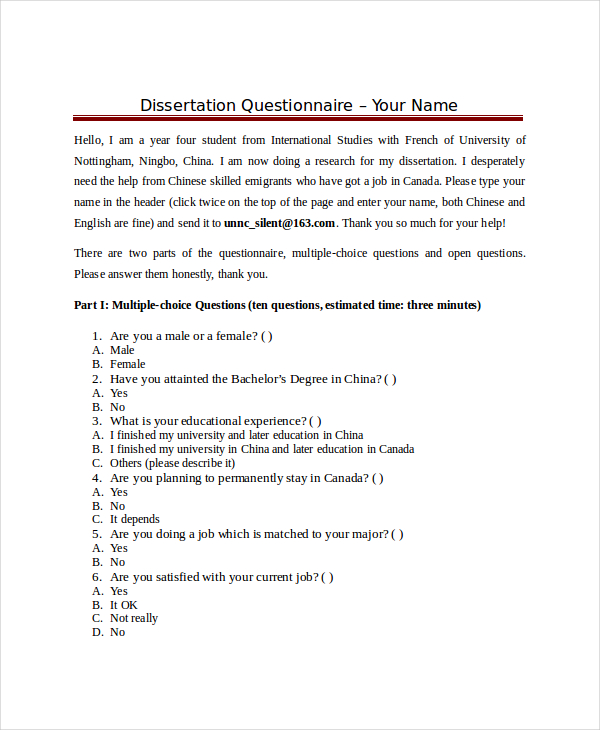
Size: 10 KB
What Is a Dissertation Questionnaire?
A dissertation questionnaire can be defined as follows:
- It is a document used in the processes of data gathering.
- Questionnaires in PDF used for a dissertation contain questions that can help assess the current condition of the community which is the subject of study within the dissertation.
- It specifies the questions that are needed to be answered to assure that there is a basis in terms of the results that will be presented in a dissertation.
How to Write a Dissertation Questionnaire
Writing an efficient and comprehensive dissertation questionnaire can greatly affect the entire dissertation. You can make one by following these steps:
- Be specific with the kind of dissertation that you are creating and align the purposes of the dissertation questionnaire that you need to make to your study.
- List down the information needed from the community who will provide the answers to your questions.
- Open a software where you can create a questionnaire template. You may also download survey questionnaire examples and templates to have a faster time in formatting the document.
- The purpose of the dissertation questionnaire.
- The guidelines and instructions in answering the dissertation questions.
- The name of the person to who will use the questionnaire results to his/her dissertation.
- The institution to whom the dissertation will be passed.
- List down the questions based on your needs.
Undergraduate Dissertation Questionnaire
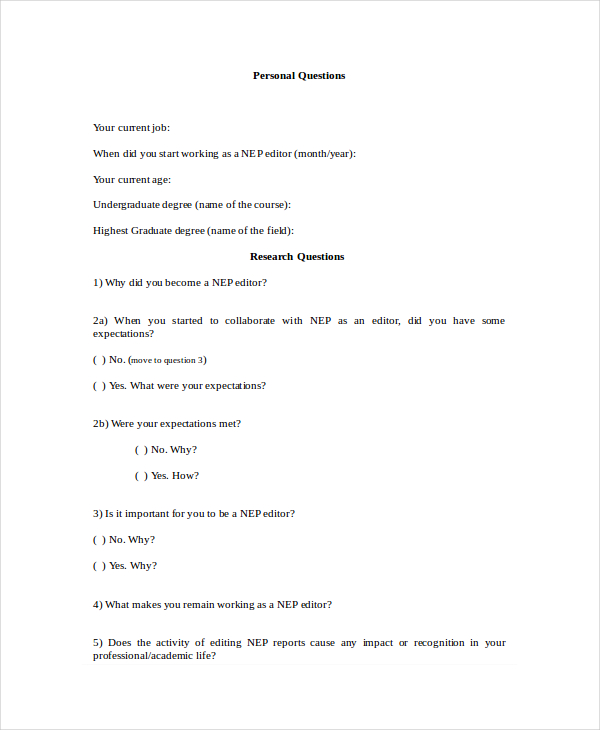
Size: 12 KB
Project Management Dissertation

Size: 54 KB
Guidelines for Writing a Dissertation Questionnaire
There are no strict rules in writing a dissertation questionnaire. However, there are some tips that can help you to create a dissertation questionnaire that is relevant to the study that you are currently doing. Some guidelines:
- Make sure that you are well aware of the data that is needed in your dissertation so you can properly curate questions that can supply your information needs.
- It will be best to use a dissertation questionnaire format that is organized, easy to understand, and properly structured. This will help the people who will answer the dissertation questionnaire quickly know how they can provide the items that you would like to know.
- Always make sure that your instructions in answering the questions are precise and directly stated.
- You may look at questionnaires in Word for comparisons. Doing this will help you assess whether there are still areas of improvement that you may tap with the content and format of the dissertation questionnaire that you have created.
Keeping this guidelines in mind and implementing them accordingly will allow you to create a dissertation questionnaire that is beneficial to the processes that you need to have an outstanding dissertation.
Text prompt
- Instructive
- Professional
Create a fun quiz to find out which historical figure you're most like in your study habits
Design a survey to discover students' favorite school subjects and why they love them.
Acts Series #65 -- Acts Summary I -- Jesus, the Spirit and your mission! More Than Bread
- Christianity
Send me a Text Message!Don't miss this, though the book of Acts has been shown time and time again to contain an accurate historical survey, this is not an historical dissertation for Dr. Luke. He's writing to a person, possibly a friend and I want you to picture, his hand shaking with emotion, with excitement, joy, and deep longing as he writes. Because more than anything, he simply wants Theopholis to know Jesus.And if we want to know Jesus, if we want others to know Jesus, that doesn...
- More Episodes
- © 2024 More Than Bread

IMAGES
VIDEO
COMMENTS
How To Draft A Survey Disclaimer: Important Laws, Examples. Surveys are an important method for collecting research data. However, respondents may be hesitant to provide their data if you do not guarantee their data security. Respondents' concerns usually revolve around their privacy, identity, and the research's purpose; this is where a ...
A survey disclaimer is a way for researchers to reiterate their privacy policies and data security measures. Learn more about it.
The survey includes questions about [describe the types of questions/themes] and should take you about [state how long] to complete. You can skip questions that you do not want to answer.
Surveys can provide organizations with valuable feedback that can be used to improve products and services. But collecting and processing personal data is inherently risky. Thankfully, disclaimers for surveys can promote transparency, give participants peace of mind, and provide abundant protections...
If you want to use surveys, questionnaires, interview questions, tests, measures, or other instruments created by other people, you are required to locate and follow usage permissions. The instrument may be protected by copyright and/or licensing restrictions.
If your business or website uses surveys to collect personal information, including a survey disclaimer is an excellent way to protect your business and your users. This article breaks down what survey disclaimers are, what they should include, and how to...
Questionnaire surveys are a well-established way of collecting data. They work with relatively small-scale research projects so design and deliver research questionnaires quickly and cheaply. When it comes to conducting research for a master's dissertation, questionnaire surveys feature prominently as the method of choice.
Surveys are a special research tool with strengths, weaknesses, and a language all of their own. There are many different steps to designing and conducting a survey, and survey researchers have specific ways of describing what they do.This handout, based on an annual workshop offered by the Program on Survey Research at Harvard, is geared toward undergraduate honors thesis writers using survey ...
A survey introduction is a short text that outlines what a survey respondent can expect from the people/company running the survey. A survey introduction is also known as a survey disclaimer.
How are surveys affected by GDPR compliance and other privacy laws? There actually is a fair bit of overlap you should be aware of.
Survey research means collecting information about a group of people by asking them questions and analysing the results. To conduct an effective survey,
You can ask respondents to agree to your consent statement or your privacy notice or practices before taking your survey. Use Skip Logic to disqualify respondents who don't consent to your terms.
This PSR Tip Sheet provides some basic tips about how to write good survey questions and design a good survey questionnaire.
Join a dissertation survey exchange group on Facebook. Another quick way to find people online who can take your dissertation survey is via Facebook and other social media networks. There are several pre-existing groups on Facebook ( such as this one) which allow students to exchange survey links. You'll have to take other people's surveys ...
Dissertation survey examples. Whatever field you're studying, we're sure the following questions will prove useful when crafting your own. At the beginning of every questionnaire, inform respondents of your topic and provide a consent form. After that, start with questions like:
Questionnaire surveys are a well-established way of collecting data. They work with relatively small-scale research projects so design and deliver research questionnaires quickly and cheaply. When it comes to conducting research for a master's dissertation, questionnaire surveys feature prominently as the method of choice.
Are you writing a dissertation and looking for ways to gain valuable insights? Surveys can be an effective tool for gathering reliable data for your research.
A dissertation is a long-form piece of academic writing based on original research conducted by you. It is usually submitted as the final step in order to finish a PhD program. Your dissertation is probably the longest piece of writing you've ever completed. It requires solid research, writing, and analysis skills, and it can be intimidating ...
If you want to use surveys, questionnaires, interview questions, tests, measures, or other instruments created by other people, you are required to locate and follow usage permissions. The instrument may be protected by copyright and/or licensing restrictions.
Check out these common disclaimer examples to find out which disclaimer statement is best for your business needs.
Supporting materials are: ProQuest/UMI Agreement, Survey of Earned Doctorates, and $95 fee. The fee can be paid at the Payment Section of the Graduate School Thesis and Dissertation Information webpage.
2. Making my Master Thesis into a paper. I've recently come across a paper that put a disclaimer into the introduction: This study is a continuation of work presented in the PhD Thesis .... I wanted to know if such a disclaimer is necessary if my paper is based on my Master Thesis. Thanks. Such disclaimers aren't necessary, but they might ...
A dissertation is a document usually a requirement for a doctoral degree especially in the field of philosophy. This long essay discusses a particular subject matter uses questionnaires and other sources of data and is used to validate its content. The questionnaire's importance is evident in the processes of data gathering as it can make the dissertation factual, effective and usable.
This document discusses the challenges of writing a dissertation questionnaire and provides tips for crafting effective survey questions. It also offers help from a writing service that can assist with designing valid and reliable questionnaires to ensure high-quality dissertation research.
Send me a Text Message!Don't miss this, though the book of Acts has been shown time and time again to contain an accurate historical survey, this is not an historical dissertation for Dr. Luke. He's writing to a person, possibly a friend and I want you to picture, his hand shaking with emotion, with excitement, joy, and deep longing as he writes.